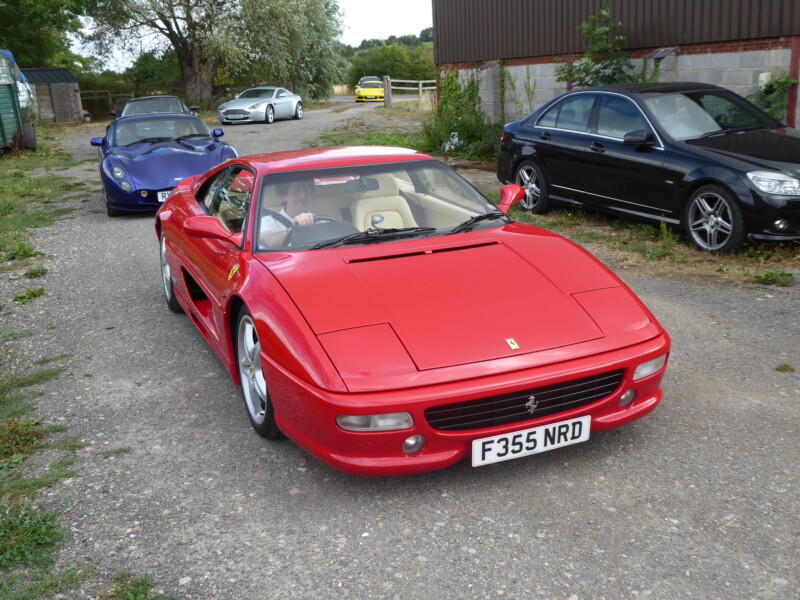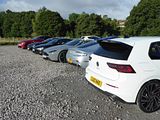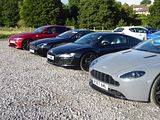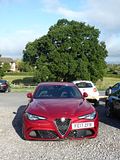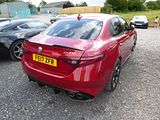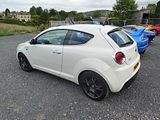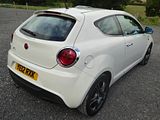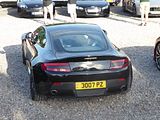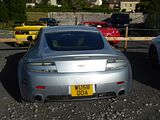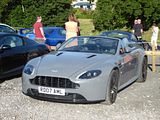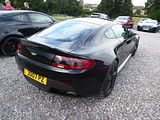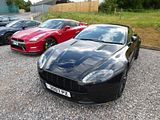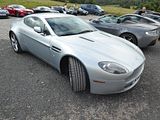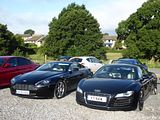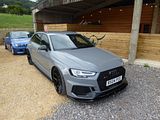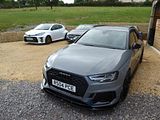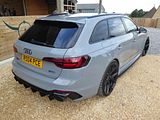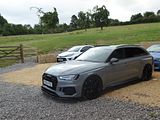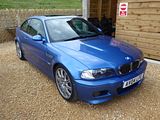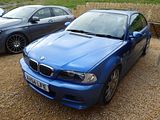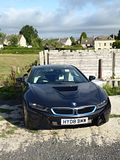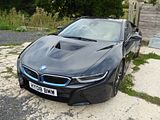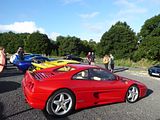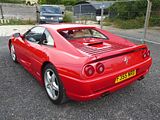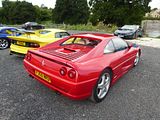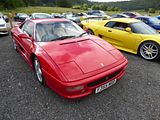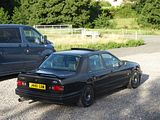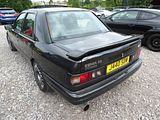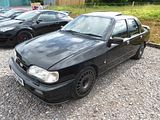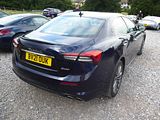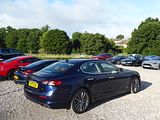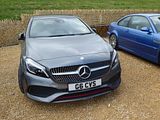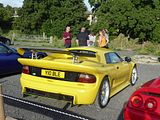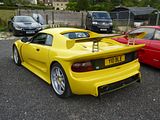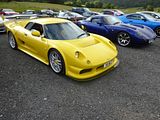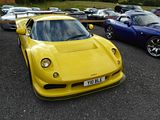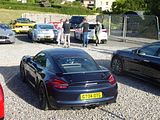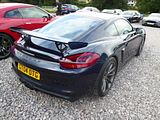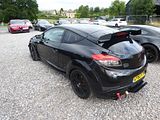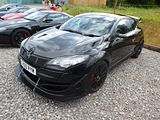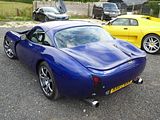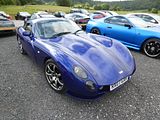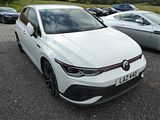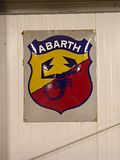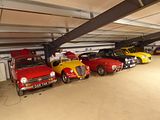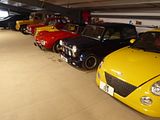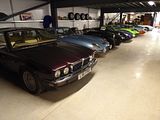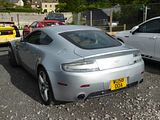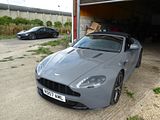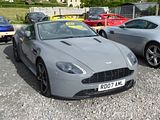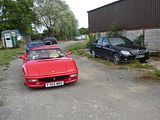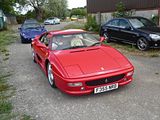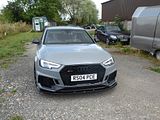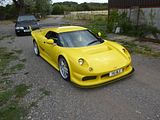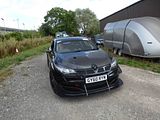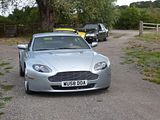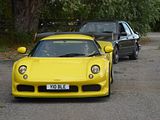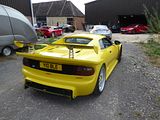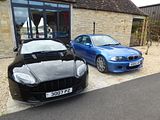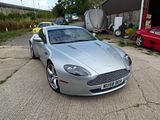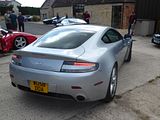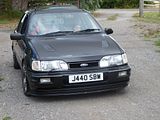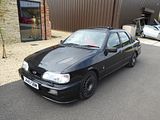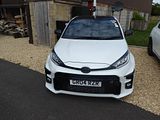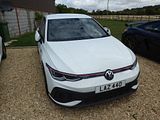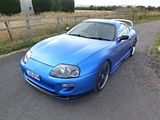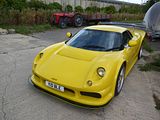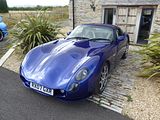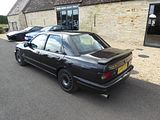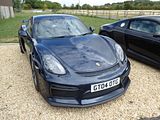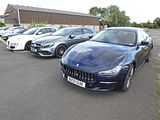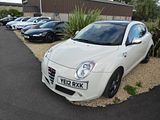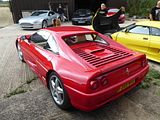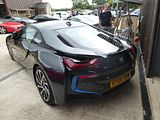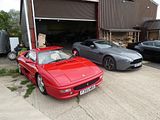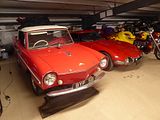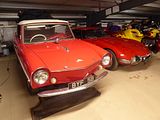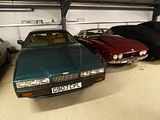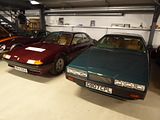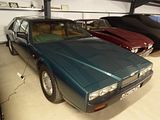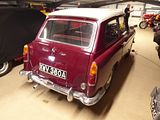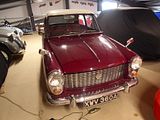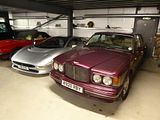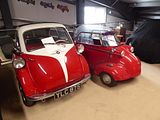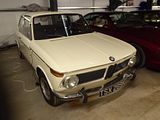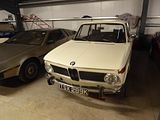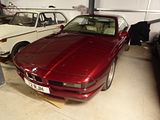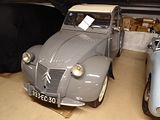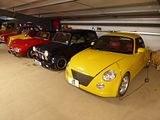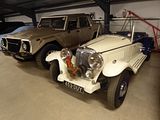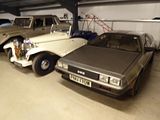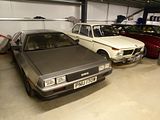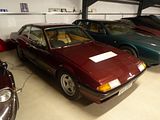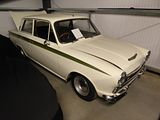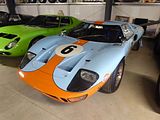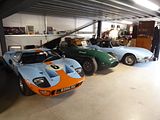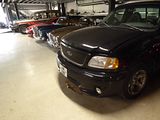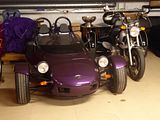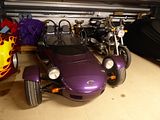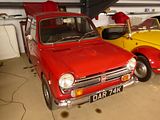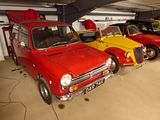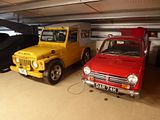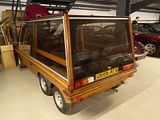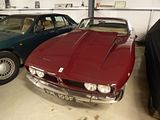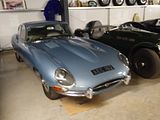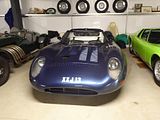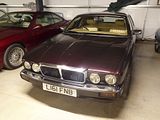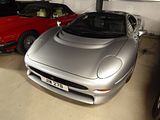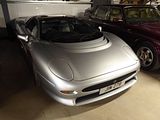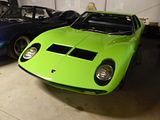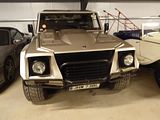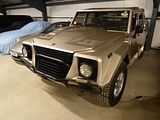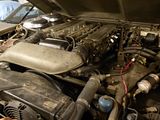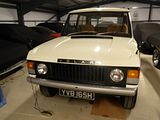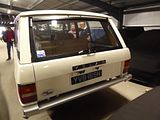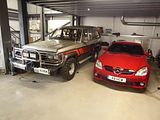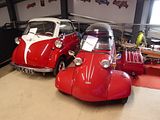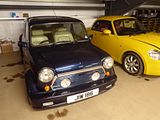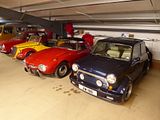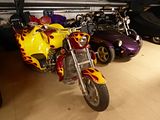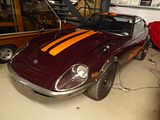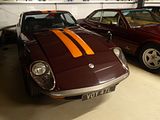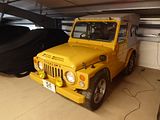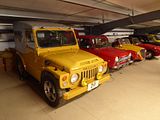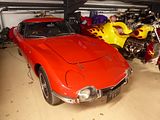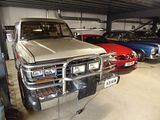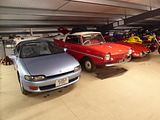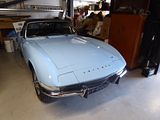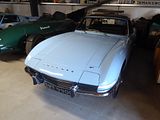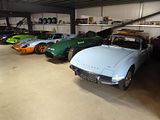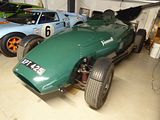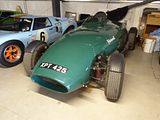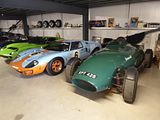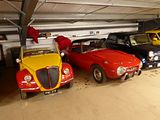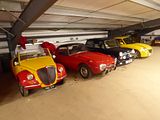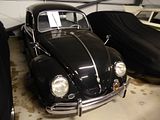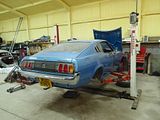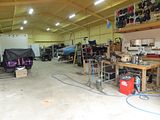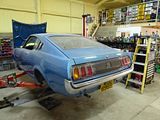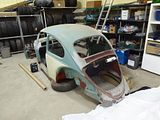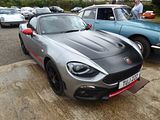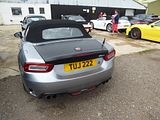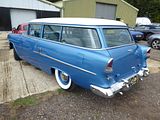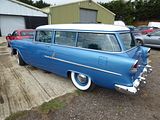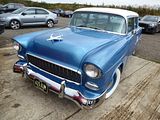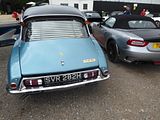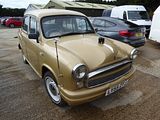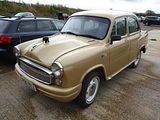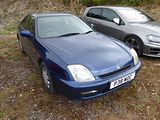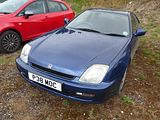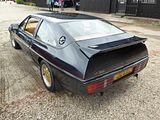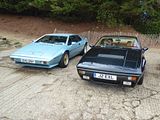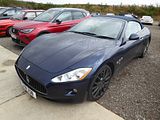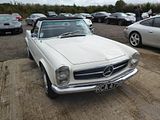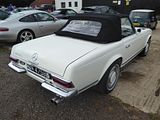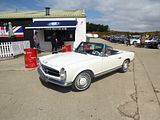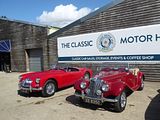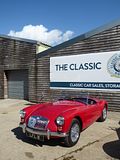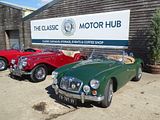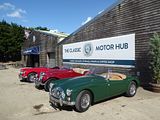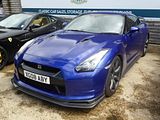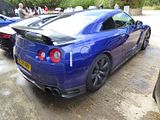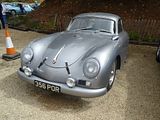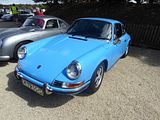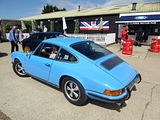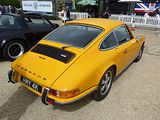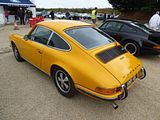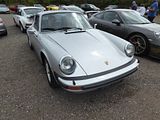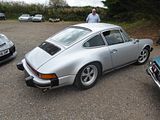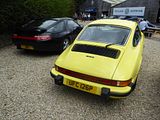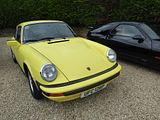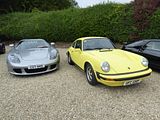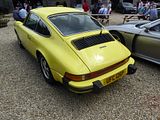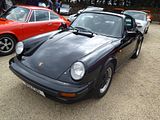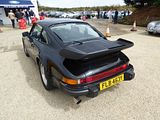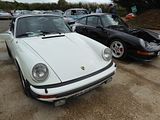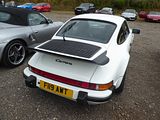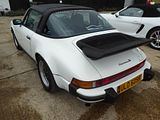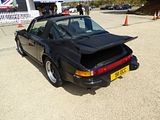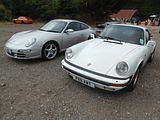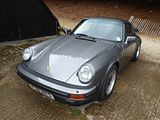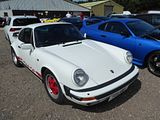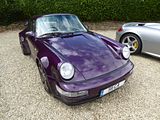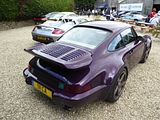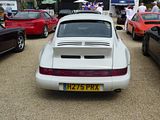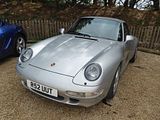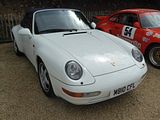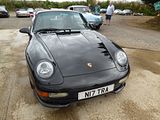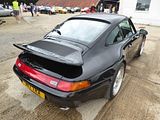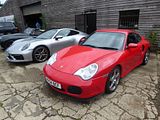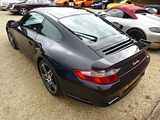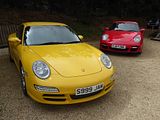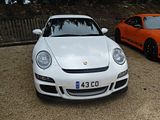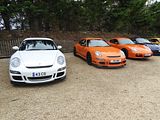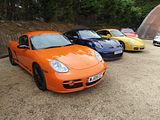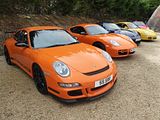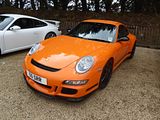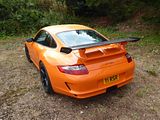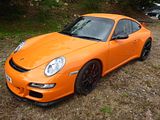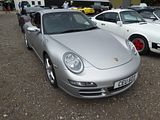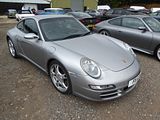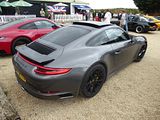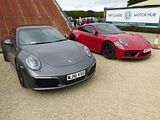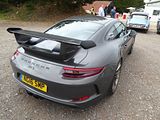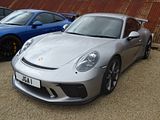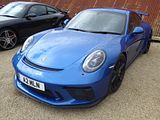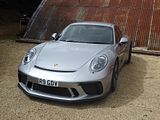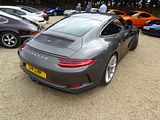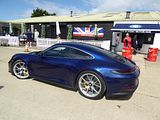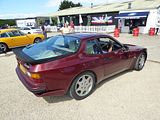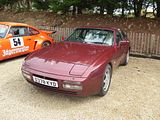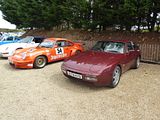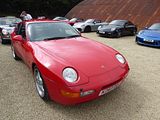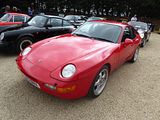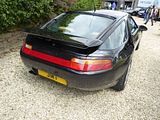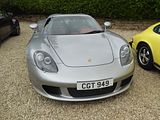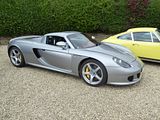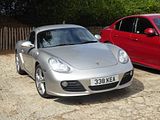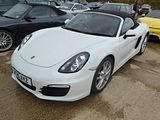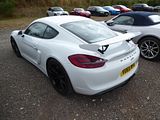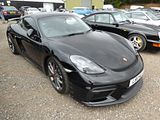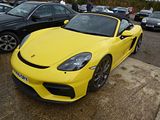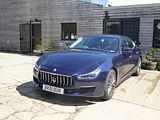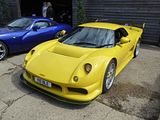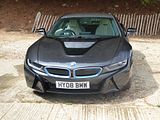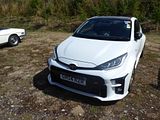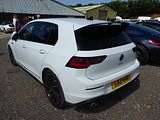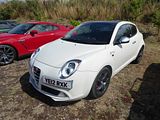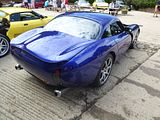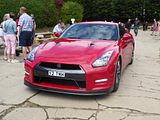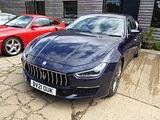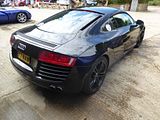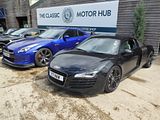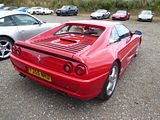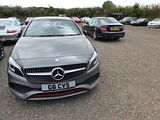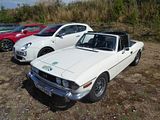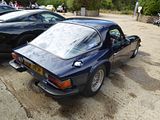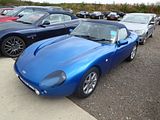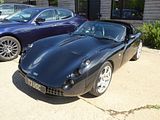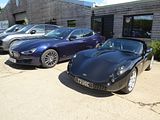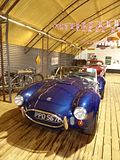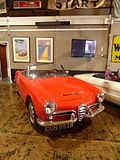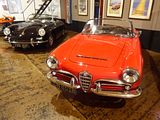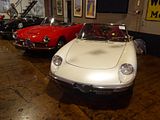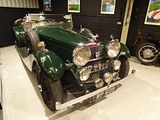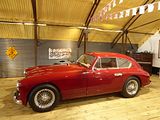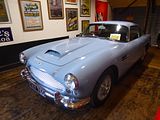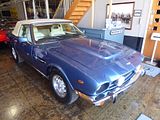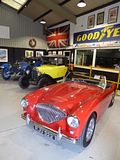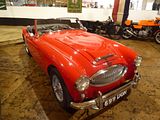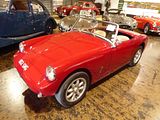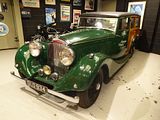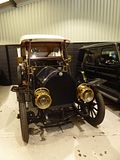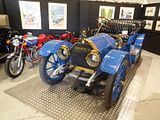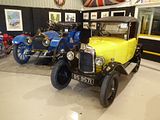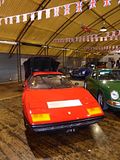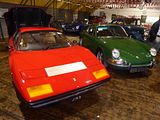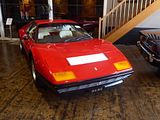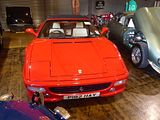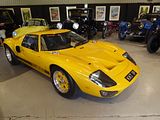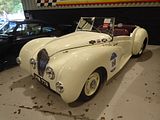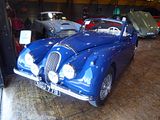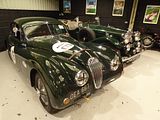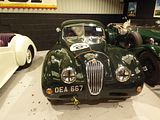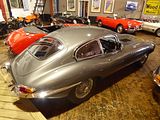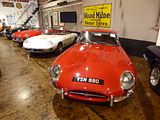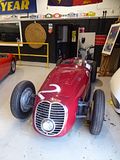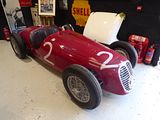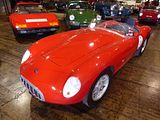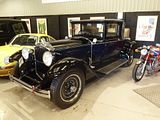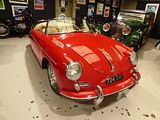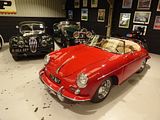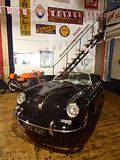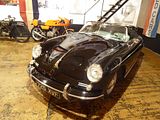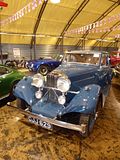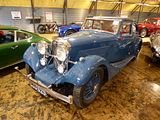Although static cars shows are always interesting, with plenty of nice cars to look at and often their proud owners to chat with, there is at least as much enjoyment to be had from a day which involves more in the way of driving, with all the fun that entails as well as the fact that you can then fit in multiple destinations in a day. There’s more preparation required by the organiser, of course, but many are quite happy to put that time, thought and effort in. That’s certainly true for the Queen Square Car Club. Initially this was a continuation and expansion of a monthly Breakfast Club meet in the centre of Bristol, but which had started to outgrow the location even before Dan Grazier, the organiser, took charge and made it into the pre-eminent such meet in the West Country. he quickly found out that there was demand for doing more than just a monthly meet and so started to offer additional activities and a number of driving days, often linked to a theme, especially around the supercar owners have been on the calendar for the last few years. Such are the challenges on my diary that I’ve never managed to attend one and then I spotted that the latest one he had conceived was on a Saturday and the diary was clear, so I signed up. Here is how the day panned out.
BREAKFAST AT THE BOHO
Assembly point, with a bacon roll and cup of coffee as part of the package for the day was at The BoHo, a bakery that is tucked away on the outskirts of Kings Stanley, itself on the edge of the better known Gloucestershire town of Stroud. There’s plenty of space in the car park for a sizeable gathering, and we did not fill it, but when everyone decides all at once that they want their breakfast there is quite a queue as there is not that much space in the servery. The bacon roll was very good, and both before eating it and after I had the chance to look at the cars that were coming on this event, some familiar from Queen Square events, but others not so. There was a very varied mix indeed.
ALFA ROMEO
First car to catch my attention was an example of the highly rated Giulia Quadrifoglio
The Alfa Romeo MiTo (Type 955) is a front-wheel drive, three-door supermini designed by Centro Stile Alfa Romeo and presented in 2008 at Castello Sforzesco in Milan with an international introduction at the British Motor Show in 2008. The new car was provisionally named the “Junior”. In November 2007, Alfa Romeo launched a European public naming competition; the winner from each country to win an Alfa Romeo Spider or an Alfa Romeo mountain bike. The winning name was “Furiosa”, which scored well in Italy, France, United Kingdom and Germany, but not in Spain. In 2008, Alfa Romeo announced “MiTo” as the official name, a portmanteau of Milano (Milan) & Torino (Turin), because it was designed in the former and was assembled in the latter. The name is also a play on the Italian word “mito”, meaning “myth” or “legend”. The MiTo is front-wheel drive, with a system allowing the driver to choose three driving settings: Dynamic, Normal, and All-Weather. The system, marketed as “Alfa DNA,” tunes the behavior of the engine, brakes, steering, suspension and gearbox. The MiTo also features LED tail lights and 250-litre (8.8 cu ft) of luggage space. The MiTo also features a Q2 electronic differential on the front wheels, which is active with the DNA switch in Dynamic position, and allows for faster and tighter cornering without loss of traction. In 2010 a new transmission for the MiTo was unveiled at the 2010 Geneva Motor Show, the six-speed TCT which is produced by Fiat Powertrain Technologies in Verrone (TCT Dual Dry Clutch Transmission). Magneti Marelli delivers the control system which integrates BorgWarner’s hydraulic actuation module into its own power and transmission control units. It can handle torque inputs of up to 350 N⋅m (258 lbf⋅ft) In Geneva was also unveiled Blue&Me–TomTom, this new system integrates TomTom navigation to the Blue&Me infotelematic system. At its launch the MiTo featured low-displacement turbocharged petrol and diesel engines. Also, a power limited 78 bhp naturally aspirated engine variant is produced to meet the new Italian legislation for young people. MiTo got new electro-hydraulic valve control system Multiair engines from September 2009. MultiAir engines will increase power (up to 10%) and torque (up to 15%), as well as a considerable reduction in consumption levels (up to 10%) and CO2 emissions (up to 10%), of particulates (up to 40%) and NOx (up to 60%). This new engine is available with 104 bhp,133 bhp and 168 bhp power ratings. All multiair versions have start-stop system as standard. In October 2009 was unveiled a dual fuel MiTo version, this version can run with LPG (Liquefied petroleum gas) or petrol, with this engine MiTo has range of 1,200 km (750 miles). The LPG version is made in collaboration with Landi Renzo. In Summer 2010 Alfa introduced the Dual Dry Clutch Transmission called Alfa TCT ( i.e. Twin Clutch Transmission ). From model year 2011 the start-stop system came as standard on all versions. At the 2011 Frankfurt Motor Show, AR introduced two new engines for the MiTo – The 0.9 L I2 TwinAir and a new low emission 85 PS version of the 1.3 JTD diesel engine. The Quadrifoglio Verde (green four-leaf clover) has traditionally been the highest line of Alfa Romeo models. The car (see Alfa Romeo in motorsport article for the history of this emblem) version of Mito was presented at the 2009 Frankfurt Motor Show. The QV version has the new 1.4 litres (1,368 cc) Turbo Multiair inline-four engine 168 bhp at 5500 rpm and 250 Nm (184 lb/ft) of torque at 2500 rpm, with newly engineered suspension, steering and new six-speed C635 gearbox developed by Fiat Powertrain Technologies (FPT). Its specific output of 124 PS per litre was highest in its segment at that time. The new multiair technology allows fuel consumption of 6 l/100 km (47 mpg) in EU combined driving and CO2 emissions of 139 g/km. QV had bigger 305 mm front brake discs and exclusive 18″ alloy wheels as standard and Sabelt carbon fibre backed bucket seats as an option. From 2014 QV was now available with TCT robotised gearbox which brought down the 0–100 km/h time to 7.3 s. With the 2016 facelift, the QV was renamed as the Veloce. For model year 2014, the MiTo got a new 105 PS 0.9 L Turbo TwinAir engine, new chrome-plated grille, new Anthracite grey colour and new burnished front light clusters. The car interior was also updated with new upholsteries, three new dashboards looks, as well as the new Uconnect 5.0 infotainment systems. The engine range now consists two turbo diesel engines (the updated E5+ 85 PS 1.3 L JTDM and the 120 PS 1.6 L JTDM) and five petrol engines: the 70 PS 1.4, the 78 PS 1.4, the 135 PS 1.4 MultiAir Turbo (with manual or Alfa TCT Dual Dry Clutch Transmission) and the 170 PS 1.4 MultiAir Turbo. The range has also 120 HP 1.4 LPG Turbo option. Debuting at the 2016 2016 Geneva Motor Show, the revised Mito featured a facelifted front fascia with a new updated brand logo and new lettering. Trim line up was changed to Mito, Super and Veloce. A new body colour and new rims designs also became available. The previous MiTo QV became the Mito Veloce, available with 170 PS engine and TCT transmission. The MiTo was marketed across a single generation from 2008 to 2018, sharing the Fiat Small platform with the Fiat Grande Punto. Production reached 293,428 at FCA’s Mirafiori plant.
ASTON MARTIN
Following the unveiling of the AMV8 Vantage concept car in 2003 at the North American International Auto Show designed by Henrik Fisker, the production version, known as the V8 Vantage was introduced at the Geneva Motor Show in 2005. The two seat, two-door coupé had a bonded aluminium structure for strength and lightness. The 172.5 inch (4.38 m) long car featured a hatchback-style tailgate for practicality, with a large luggage shelf behind the seats. In addition to the coupé, a convertible, known as the V8 Vantage Roadster, was introduced later in that year. The V8 Vantage was initially powered by a 4.3 litre quad-cam 32-valve V8 which produced 380 bhp at 7,300 rpm and 409 Nm (302 lb/ft) at 5,000 rpm. However, models produced after 2008 had a 4.7-litre V8 with 420 bhp and 470 Nm (347 lbft) of torque. Though based loosely on Jaguar’s AJ-V8 engine architecture, this engine was unique to Aston Martin and featured race-style dry-sump lubrication, which enabled it to be mounted low in the chassis for an improved centre of gravity. The cylinder block and heads, crankshaft, connecting rods, pistons, camshafts, inlet and exhaust manifolds, lubrication system and engine management were all designed in house by Aston Martin and the engine was assembled by hand at the AM facility in Cologne, Germany, which also built the V12 engine for the DB9 and Vanquish. The engine was front mid-mounted with a rear-mounted transaxle, giving a 49/51 front/rear weight distribution. Slotted Brembo brakes were also standard. The original V8 Vantage could accelerate from 0 to 60 mph in 4.8 seconds before topping out at 175 mph. In 2008, Aston Martin introduced an aftermarket dealer approved upgrade package for power and handling of the 4.3-litre variants that maintained the warranty with the company. The power upgrade was called the V8 Vantage Power Upgrade, creating a more potent version of the Aston Martin 4.3-litre V8 engine with an increase in peak power of 20 bhp to 400 bhp while peak torque increased by 10 Nm to 420 Nm (310 lb/ft). This consists of the fitting of the following revised components; manifold assembly (painted Crackle Black), valved air box, right and left hand side vacuum hose assemblies, engine bay fuse box link lead (ECU to fuse box), throttle body to manifold gasket, intake manifold gasket, fuel injector to manifold seal and a manifold badge. The V8 Vantage had a retail price of GB£79,000, US$110,000, or €104,000 in 2006, Aston Martin planned to build up to 3,000 per year. Included was a 6-speed manual transmission and leather-upholstery for the seats, dash board, steering-wheel, and shift-knob. A new 6-speed sequential manual transmission, similar to those produced by Ferrari and Lamborghini, called Sportshift was introduced later as an option. An open-topped model was added to the range in 2006 and then in the quest for more power a V12 Vantage joined the range not long after. There were no fewer than 28 different versions of the car produced over its model life and several of them were here, all different. There were more of these than any other model in the group on this occasion.
AUDI
The Audi R8, based on the Audi Le Mans quattro concept car (designed by Frank Lamberty and Julian Hoenig) first appeared at the 2003 International Geneva Motor Show and the 2003 Frankfurt International Motor Show. The R8 road car was officially launched at the Paris Auto Show on 30 September 2006. There was some confusion with the name, which the car shares with the 24 Hours of Le Mans winning R8 Le Mans Prototype (LMP). Initial models included the R8 4.2 FSI coupé (with a V8 engine) and R8 5.2 FSI coupé (with a V10 engine). Convertible models, called the Spyder by the manufacturer, were introduced in 2008, followed by the high-performance GT model introduced in 2011. The Motorsport variants of the R8 were also subsequently introduced from 2008 onwards. An all-electric version called the e-Tron started development but would only reach production stage when the second generation model would be introduced. 6-time 24 Hours of Le Mans winner Jacky Ickx described the R8 as “the best handling road car today” and the car was well received by everyone who drove it. The car received a facelift in 2012 and a new model called the V10 Plus was now added to the range. Production of the Type 42 ended in August 2015
Also wearing its 4 ringed grilled bade was this example of the latest RS4 Avant
BMW
The M3 version of the E46 3 Series was produced in coupé and convertible body styles. The E46 M3 is powered by the S54 straight-six engine and has a 0-100 km/h (62 mph) acceleration time of 5.1 seconds for the coupe, with either the manual or SMG-II transmission. The skid pad cornering results are 0.89 g for the coupe and 0.81 g for the convertible.The top speed is electronically limited to 250 km/h (155 mph). The available transmissions were a Getrag 420G 6-speed manual transmission or a SMG-II 6-speed automated manual transmission, which was based on the Getrag 420G. The SMG-II used an electrohydraulically actuated clutch and gearshifts could be selected via the gear knob or paddles mounted on the steering wheel. The SMG-II was praised for its fast shift times and racetrack performance, but some people found its shifts to be delayed and lurching in stop-start traffic. In 2005, a special edition was introduced which used several parts from the CSL. This model was called the M3 Competition Package (ZCP) in the United States and mainland Europe, and the M3 CS in the United Kingdom. Compared to the regular M3, the Competition Package includes: 19-inch BBS alloy wheels- 19″x 8″ at the front and 19″x 9.5″ at the rear; Stiffer springs (which were carried over to the regular M3 from 12/04); Faster ratio steering rack of 14.5:1 (compared with the regular M3’s ratio of 15.4:1) as per the CSL; Steering wheel from the CSL; M-track mode for the electronic stability control, as per the CSL; The CSL’s larger front brake discs (but with the regular M3 front calipers) and rear brake calipers with larger pistons; Alcantara steering wheel and handbrake covers; The engine, gearbox and other drivetrain components are the same as the standard M3. Total production of the E46 M3 was 56,133 coupes and 29,633 convertibles. The cars were assembled at the BMW Regensburg factory in Germany and production was from September 2000 until August 2006, production totalled 85,766.
First introduced as the Concept Vision EfficientDynamics, the i8 was part of BMW’s “Project i” and was marketed as a new brand, BMW i, sold separately from BMW or Mini. The BMW i3, launched for customers in Europe in the fourth quarter of 2013, was the first model of the i brand available in the market, and it was followed by the i8, released in Germany in June 2014 as a 2015 model year. Other i models were expected to follow.The initial turbodiesel concept car was unveiled at the 2009 International Motor Show Germany, In 2010, BMW announced the mass production of the Vision EfficientDynamics concept in Leipzig beginning in 2013 as the BMW i8. The BMW i8 gasoline-powered concept car destined for production was unveiled at the 2011 Frankfurt Motor Show. The production version of the BMW i8 was unveiled at the 2013 International Motor Show Germany. The following are the concept and pre-production models developed by BMW that preceded the production version. When BMW i sponsored the ABB FIA Formula E World Championship, they announced that they would provide support vehicles; the i8 operated as the official safety car. BMW Vision EfficientDynamics concept car was a plug-in hybrid with a 1.5L three-cylinder turbo-diesel engine. Additionally, there were two electric motors with 104 kW (139 hp). It allowed an acceleration to 100 km/h (62 mph) in 4.8 seconds, with an electronically limited top speed of 250 km/h (155 mph). According to BMW, the average fuel consumption in the EU test cycle (KV01) was 3.76 L/100 km (75.1 mpg imp), with a carbon dioxide emission rating of 99 g/km(1,3 L/100 km and 33g CO2/kabelham; EU-PHEV ECE-R101). The estimated all-electric range was 50 km (31 mi), and the 24-litre petrol tank extended the total vehicle range to up to 700 km (430 mi). The lightweight chassis was made mainly from aluminum. The windshield, top, doors, and fenders were made from polycarbonate glass, with the body having a drag coefficient of 0.22. The designers of the BMW Vision EfficientDynamics concept were Mario Majdandzic for the exterior and Jochen Paesen (lead interior design), Markus Speck (interior design), and Felix Staudacher former Baerlin (detail design) for the interior. While Jochen Paesen took care of the main interior theme, Markus Speck was in charge of the seats, all the visible structure, and some details. Felix Baerlin supported Jochen Paesen on details including the steering wheel and center console. The vehicle was unveiled at the 2009 International Motor Show Germany, followed by Auto China 2010. The BMW i8 Concept plug-in hybrid electric vehicle included an electric motor located in the front axle powering the front wheels rated 96 kW (131 PS; 129 hp) and 250 Nm (184 lb/ft, a turbocharged 1.5-litre 3-cylinder petrol engine driving rear wheels rated 164 kW (223 PS; 220 hp) and 300 Nm (221 lb/ft of torque, with combined output of 260 kW (354 PS; 349 hp) and 550 Nm (406 lb/ft), a 7.2 kWh (26 MJ) lithium-ion battery pack that allowed an all-electric range of 35 km (22 mi). All four wheels provided regenerative braking. The location of the battery pack in the energy tunnel gave the vehicle a low centre of gravity, enhancing its dynamics. Its top speed was electronically limited to 250 km/h (155 mph) and was expected to go from 0 to 100 km/h (0 to 60 mph) in 4.6 seconds. Under normal driving conditions the i8 was expected to deliver 80 mpg US (2.9 L/100 km; 96 mpg imp) under the European cycle. A full charge of the battery would take less than two hours at 220 V. The positioning of the motor and engine over the axles resulted in 50/50 weight distribution.The vehicle was unveiled at the 2011 International Motor Show Germany, followed by CENTER 548 in New York City, 42nd Tokyo Motor Show 2011, 82nd Geneva Motor Show 2012, BMW i Born Electric Tour at the Palazzo Delle Esposizioni at Via Nazionale 194 in Rome, and Auto Shanghai 2013. This concept car was featured in the film Mission: Impossible – Ghost Protocol. The BMW i8 Concept Spyder included a slightly shorter wheelbase and overall length compared to the BMW i8 Concept, carbon-fiber-reinforced plastic (CFRP) Life module, drive modules made primarily from aluminium components, interlocking of surfaces and lines, 8.8-inch (22.4 cm) screen display, off-white outer layer, and orange-toned naturally tanned leather upholstery. The vehicle was unveiled at Auto China 2012 in Beijing where it won Concept Car of the Year, followed by the 83rd Geneva International Motor Show 2013. The designer of the BMW i8 Concept Spyder was Richard Kim. The design of the BMW i8 coupe prototype was based on the BMW i8 Concept. The BMW i8 prototype had an average fuel efficiency of less than 2.5 L/100 km (113.0 mpg imp; 94.1 mpg US) under the New European Driving Cycle with carbon emissions of less than 59 g/km. The i8 with its carbon-fibre-reinforced plastic (CFRP) passenger cell lightweight, aerodynamically optimized body, and BMW eDrive technology offered the dynamic performance of a sports car, with an expected 0–100 km/h (0–62 mph) sprint time of less than 4.5 seconds using both power sources. The plug-in hybrid system of the BMW i8 comprised a three-cylinder, 1.5-liter BMW TwinPower Turbo gasoline engine combined with BMW eDrive technology used in the BMW i3 and developed maximum power of 170 kW (228 hp). The BMW i8 was the first BMW production model to be powered by a three-cylinder gasoline engine and the resulting specific output of 115 kW (154 hp) per liter of displacement was on par with high-performance sports car engines and was the highest of any engine produced by the BMW Group. The BMW i8’s second power source was a hybrid synchronous electric motor specially developed and produced by the BMW Group for BMW i. The electric motor developed maximum power of 131 hp (98 kW) and produced its maximum torque of around 320 Nm (236 lb/ft) from a standstill. Typical of an electric motor, responsive power was instantly available when starting and this continued into the higher load ranges. As well as providing a power boost to assist the gasoline engine during acceleration, the electric motor could also power the vehicle by itself. Top speed in electric mode was approximately 120 km/h (75 mph), with a maximum driving range of up to 35 km (22 mi). Linear acceleration was maintained even at higher speeds since the interplay between the two power sources efficiently absorbed any power flow interruptions when shifting gears. The model-specific version of the high-voltage 7.2 lithium-ion battery had a liquid cooling system and could be recharged at a conventional household power socket, at a BMW I Wallbox, or at a public charging station. In the US, a full recharge took approximately 3.5 hours from a conventional 120 V, 12 amp household circuit or approximately 1.5 hours from a 240 V Level 2 charger. The driver could select several driving modes: SPORT, COMFORT, and ECO PRO. Using the gear selector, the driver could either select position D for automated gear selection or could switch to SPORT mode. SPORT mode offered manual gear selection and at the same time switched to sporty drive and suspension settings. In SPORT mode, the engine and electric motor delivered extra performance, accelerator response was faster, and the power boost from the electric motor was maximized. And to keep the battery topped up, SPORT mode also activated maximum energy recuperation during overrun and braking as the electric motor’s generator function, which recharged the battery using kinetic energy, switched to a more powerful setting. The Driving Experience Control switch on the center console offered a choice of two settings. On starting, COMFORT mode was activated, which offered a balance between performance and fuel efficiency, with unrestricted access to all convenience functions. Alternatively, the ECO PRO mode could be engaged, which, on the BMW i8 as on other models, supported an efficiency-optimized driving style. In this mode, the powertrain controller coordinated the cooperation between the gasoline engine and the electric motor for maximum fuel economy. On deceleration, the intelligent energy management system automatically decided, in line with the driving situation and vehicle status, whether to recuperate braking energy or to coast with the powertrain disengaged. At the same time, ECO PRO mode also programmed electrical convenience functions such as the air conditioning, seat heating, and heated mirrors to operate at minimum power consumption, but without compromising safety. The maximum driving range of the BMW i8 on a full fuel tank and with a fully charged battery was more than 500 km (310 mi) in COMFORT mode, which could be increased by up to 20% in ECO PRO mode. The BMW i8’s ECO PRO mode could also be used during all-electric operation. The vehicle was then powered solely by the electric motor. Only if the battery charge dropped below a given level, or under sudden intense throttle application such as kick down, was the internal combustion engine automatically activated. The vehicle was unveiled in BMW Group’s Miramas test track in France. The production BMW i8 was designed by Benoit Jacob. The production version was unveiled at the 2013 Frankfurt International Motor Show followed by 2013 Les Voiles de Saint-Tropez. Its design was heavily influenced by the BMW M1 Homage concept car, which in turn pays homage to BMW’s last production mid-engined sports car prior to the i8: the BMW M1. The BMW i8 featured butterfly doors, head-up display, rear-view cameras and partially false engine noise. Series production of customer vehicles began in April 2014. The electric two-speed drivetrain was developed and produced by GKN. It was the first production car with laser headlights, reaching farther than LED lights. The i8 had a vehicle weight of 1,485 kg (3,274 lb) (DIN kerb weight) and a low drag coefficient (Cd) of 0.26. In all-electric mode, the BMW i8 had a top speed of 120 km/h (75 mph). In Sport mode, the i8 delivered a mid-range acceleration from 80 to 120 km/h (50 to 75 mph) in 2.6 seconds. The electronically controlled top speed was 250 km/h (155 mph). The 20,000th i8 was produced in December 2019, one of the limited Ultimate Sophisto Edition models. The last i8 rolled off the production line on 11 June 2020. In total, there were 20,465 units produced: 16,581 coupés and 3,884 roadsters.
FERRARI
Stung by the criticism of the 348, Ferrari undertook a comprehensive revision, creating the F355 model which they launched in May 1994. An evolution of the Ferrari 348, just about everything was changed, and improved. Design emphasis for the F355 was placed on significantly improved performance, but driveability across a wider range of speeds and in different environments such as low-speed city traffic was also addressed, as the Honda NS-X had proved that you could make a supercar that could be lived with every day. Apart from the displacement increase from 3.4 to 3.5 litres, the major difference between the V8 engine in the 348 and F355 was the introduction of a 5-valve cylinder head. This new head design allowed for better intake permeability and resulted in an engine that was considerably more powerful, producing 375 hp. The longitudinal 90° V8 engine was bored 2mm over the 348’s engine, resulting in the small increase in displacement. The F355 had a Motronic system controlling the electronic fuel injection and ignition systems, with a single spark plug per cylinder, resulting in an unusual 5 valves per cylinder configuration. This was reflected in the name, which did not follow the formula from the previous decades of engine capacity in litres followed by number of cylinders such as the 246 = 2.4 litres and 6 cylinders and the 308 of 3.0 litres and 8 cylinders. For the F355, Ferrari used engine capacity followed by the number of valves per cylinder (355 = 3.5 litres engine capacity and 5 valves per cylinder) to bring the performance advances introduced by a 5 valve per cylinder configuration into the forefront. 5. The frame was a steel monocoque with tubular steel rear sub-frame with front and rear suspensions using independent, unequal-length wishbones, coil springs over gas-filled telescopic shock absorbers with electronic control servos and anti-roll bars. The car allows selection between two damper settings, “Comfort” and “Sport”. Ferrari fitted all road-going F355 models with Pirelli tires, size 225/40ZR 18 in front and 265/40 ZR 18 in the rear. Although the F355 was equipped with power-assisted steering (intended to improve low-speed driveability relative to the outgoing 348), this could optionally be replaced with a manual steering rack setup by special order. Aerodynamic designs for the car included over 1,300 hours of wind tunnel analysis. The car incorporates a Nolder profile on the upper portion of the tail, and a fairing on the underbody that generates downforce when the car is at speed. These changes not only made the car faster but also much better to drive,m restoring Ferrari to the top of the tree among its rivals. At launch, two models were available: the coupe Berlinetta and the targa topped GTS, which was identical to the Berlinetta apart from the fact that the removable “targa-style” hard top roof could be stored behind the seats. The F355 would prove to be last in the series of mid-engined Ferraris with the Flying Buttress rear window, a lineage going back to the 1965 Dino 206 GT, unveiled at the Paris Auto Show. The Spider (convertible) version came later in the year. In 1997 the Formula One style paddle gear shift electrohydraulic manual transmission was introduced with the Ferrari 355 F1 adding £6,000 to the dealer asking price. This system promised faster gearchanges and allowed the driver to keep both hands on the steering wheel, It proved to be very popular and was the beginning of the end for the manual-transmission Ferrari. Ferrari produced 4,871 road-going Berlinetta models, of which 3,829 were 6-speed and 1,042 were F1 transmissions. The Spider proved to be the second-most popular F355 model, with a total production of 3,717 units, of which 2,664 were produced with the 6-speed transmission and another 1,053 produced with the F1 transmission. A total of 2,577 GTS models were produced, with 2,048 delivered with the 6-speed transmission and another 529 with the F1 transmission. This was the last GTS targa style model produced by Ferrari. This made a total production run of 11,273 units making the F355 the most-produced Ferrari at the time, though this sales record would be surpassed by the next generation 360 and later, the F430.
FORD
The Sierra RS Cosworth model. a very sporting version of Ford’s upper-medium sized family car, was built by Ford Europe from 1986 to 1992, the result of a Ford Motorsport project with the purpose of producing an outright winner for Group A racing in Europe. The project was defined in the spring of 1983 by Stuart Turner, then recently appointed head of Ford Motorsport in Europe, who had realised right away that Ford was no longer competitive in this area. Turner got in touch with Walter Hayes, at the time the vice-president of public relations at Ford, to get support for the project. Hayes had earlier been the driving force behind the development of the Ford GT40 that won Le Mans in 1966, and the Cosworth DFV engine that brought Ford 154 victories and 12 world championships in Formula One during the 1960s and 1970s. Hayes found the project very appealing and promised his full support. Turner then invited Ken Kohrs, vice-president of development, to visit Ford’s longtime partner, the automotive company Cosworth, where they were presented a project developed on Cosworth’s own initiative, the YAA engine. This was a twin cam, 16-valve engine based on Ford’s own T88 engine block, better known as the Pinto. This prototype proved an almost ideal basis for the engine Turner needed to power his Group A winner. Therefore, an official request for a turbocharged version (designated Cosworth YBB) capable of 180 HP on the street and 300 HP in race trim, was placed. Cosworth answered positively, but they put up two conditions: the engine would produce not less than 204 HP in the street version, and Ford had to accept no fewer than 15,000 engines. Turner’s project would only need about 5,000 engines, but Ford nevertheless accepted the conditions. The extra 10,000 engines would later become one of the reasons Ford also chose to develop a four door, second generation Sierra RS Cosworth. To find a suitable gearbox proved more challenging. The Borg-Warner T5, also used in the Ford Mustang, was chosen, but the higher revving nature of the Sierra caused some problems. Eventually Borg-Warner had to set up a dedicated production line for the gearboxes to be used in the Sierra RS Cosworth. Many of the suspension differences between the standard Sierra and the Cosworth attributed their development to what was learned from racing the turbocharged Jack Roush IMSA Merkur XR4Ti in America and Andy Rouse’s successful campaign of the 1985 British Saloon Car Championship. Much of Ford’s external documentation for customer race preparation indicated “developed for the XR4Ti” when describing parts that were Sierra Cosworth specific. Roush’s suspension and aerodynamics engineering for the IMSA cars was excellent feedback for Ford. Some production parts from the XR4Ti made their way into the Cosworth such as the speedometer with integral boost gauge and the motorsport 909 chassis stiffening plates. In April 1983, Turner’s team decided on the recently launched Sierra as a basis for their project. The Sierra filled the requirements for rear wheel drive and decent aerodynamic drag. A racing version could also help to improve the unfortunate, and somewhat undeserved, reputation that Sierra had earned since the introduction in 1982. Lothar Pinske, responsible for the car’s bodywork, demanded carte blanche when it came to appearance in order to make the car stable at high speed. Experience had shown that the Sierra hatchback body generated significant aerodynamic lift even at relatively moderate speed. After extensive wind tunnel testing and test runs at the Nardò circuit in Italy, a prototype was presented to the project management. This was based on an XR4i body with provisional body modifications in fibreglass and aluminium. The car’s appearance raised little enthusiasm. The large rear wing caused particular reluctance. Pinske insisted however that the modifications were necessary to make the project successful. The rear wing was essential to retain ground contact at 300 km/h, the opening between the headlights was needed to feed air to the intercooler and the wheel arch extensions had to be there to house wheels 10” wide on the racing version. Eventually, the Ford designers agreed to try to make a production version based on the prototype. In 1984, Walter Hayes paid visits to many European Ford dealers in order to survey the sales potential for the Sierra RS Cosworth. A requirement for participation in Group A was that 5,000 cars were built and sold. The feedback was not encouraging. The dealers estimated they could sell approximately 1,500 cars. Hayes did not give up, however, and continued his passionate internal marketing of the project. As prototypes started to emerge, dealers were invited to test drive sessions, and this increased the enthusiasm for the new car. In addition, Ford took some radical measures to reduce the price on the car. As an example, the car was only offered in three exterior colours (black, white and moonstone blue) and one interior colour (grey). There were also just two equipment options: with or without central locking and electric window lifts. The Sierra RS Cosworth was first presented to the public at the Geneva Motor Show in March 1985, with plans to release it for sale in September and closing production of the 5,000 cars in the summer of 1986. In practice, it was launched in July 1986. 5545 were manufactured in total of which 500 were sent to Tickford for conversion to the Sierra three-door RS500 Cosworth. The vehicles were manufactured in right hand drive only, and were made in Ford’s Genk factory in Belgium. Exactly 500 RS500s were produced, all of them RHD for sale in the UK only – the biggest market for this kind of Ford car. It was originally intended that all 500 would be black, but in practice 56 white and 52 moonstone blue cars were produced.To broaden the sales appeal, the second generation model was based on the 4 door Sierra Sapphire body. It was launched in 1988, and was assembled in Genk, Belgium, with the UK-built Ford-Cosworth YBB engine. Cylinder heads on this car were early spec 2wd heads and also the “later” 2wd head which had some improvements which made their way to the 4X4 head. Suspension was essentially the same with some minor changes in geometry to suit a less aggressive driving style and favour ride over handling. Spindles, wheel offset and other changes were responsible for this effect. Approximately 13,140 examples were produced during 1988-1989 and were the most numerous and lightest of all Sierra Cosworth models. Specifically the LHD models which saved weight with a lesser trim level such as manual rear windows and no air conditioning. In the UK, the RHD 1988-1989 Sierra Sapphire RS Cosworth is badged as such with a small “Sapphire” badge on the rear door window trims. All 1988-1989 LHD models are badged and registered as a Sierra RS Cosworth with no Sapphire nomenclature at all. “Sapphire” being viewed as a Ghia trim level that saw power rear windows, air conditioning and other minor options. Enthusiasts of the marque are mindful of this and will describe the LHD cars by their body shell configuration, 3 door or 4 door. As the Sapphire Cosworth was based on a different shell to the original three-door Cosworth, along with its more discreet rear wing, recorded a drag co-efficient of 0.33, it registered slightly better performance figures, with a top speed of 150 mph and 0-60 of 6.1 seconds, compared to the original Cosworth. In January 1990, the third generation Sierra RS Cosworth was launched, this time with four wheel drive. As early as 1987, Mike Moreton and Ford Motorsport had been talking about a four wheel drive Sierra RS Cosworth that could make Ford competitive in the World Rally Championship. The Ferguson MT75 gearbox that was considered an essential part of the project wasn’t available until late 1989 however. Ford Motorsport’s desire for a 3-door “Motorsport Special” equivalent to the original Sierra RS Cosworth was not embraced. The more discreet 4-door version was considered to have a better market potential. It was therefore decided that the new car should be a natural development of the second generation, to be launched in conjunction with the face lift scheduled for the entire Sierra line in 1990. The waiting time gave Ford Motorsport a good opportunity to conduct extensive testing and demand improvements. One example was the return of the bonnet louvres. According to Ford’s own publicity material, 80% of the engine parts were also modified. The improved engine was designated YBJ for cars without a catalyst and YBG for cars with a catalyst. The latter had the red valve cover replaced by a green one, to emphasise the environmental friendliness. Four wheel drive and an increasing amount of equipment had raised the weight by 100 kg, and the power was therefore increased to just about compensate for this. The Sierra RS Cosworth 4×4 received, if possible, an even more flattering response than its predecessors and production continued until the end of 1992, when the Sierra was replaced by the Mondeo. The replacement for the Sierra RS Cosworth was not a Mondeo however, but the Escort RS Cosworth. This was to some extent a Sierra RS Cosworth clad in an “Escort-like” body. The car went on sale in May 1992, more than a year after the first pre-production examples were shown to the public, and was homologated for Group A rally in December, just as the Sierra RS Cosworth was retired. It continued in production until 1996. The Sierra and Sapphire Cosworths were undoubted performance bargains when new, but they also gained a reputation both for suffering a lot of accidents in the hands of the unskilled and also for being among the most frequently stole cars of their generation. These days, though, there are some lovely and treasured examples around and indeed you are far more likely to see a Cosworth version of the Sierra than one of the volume selling models.
MASERATI
Sole Maserati in the group was my Ghibli
MERCEDES-BENZ
Slightly surprisingly, perhaps, there was just one Mercedes here, too, an example of the previous generation AMG 45
NISSAN
There was just one Nissan, too, the long-lived R35 generation GT-R.
NOBLE
Follow on to the Noble M10, the M12 was a two-door, two-seat model, originally planned both as a coupe and as a convertible. All M12s were powered by modified bi-turbocharged Ford Duratec V6 engines. There was a full steel roll cage, steel frame, and G.R.P. (fibreglass) composite clam shell body parts. Although looking to be track derived, the M12 was street-legal, ready for both road and track. The M12 has no anti-roll bars on the car, allowing for a comfortable feel. The coupe evolved through four versions of Noble cars, with the 425 bhp M400 as the ultimate version of the M12, following the first 2.5 litre 310 bhp car, the 352 bhp 3 litre GTO-3 and the GTO-3R. The car was sold in the US, where it proved quite popular, with 220 GTO-3Rs and M400s sold there. US production rights were sold in February 2007 to 1G Racing from Ohio. Due to high demand of these cars, 1G Racing (now Rossion Automotive) released its own improved car based on the M400, named Rossion Q1. Another company which is also producing a model developed from the M12 is Salica Cars 1 with their Salica GT and Salica GTR.
PORSCHE
Much rumoured for some time, the Cayman GT4 was officially launched at the 2015 Geneva Show, positioned to sit between the Cayman GTS and the 911 GT3. By the time of the official unveiling, the car was supposedly sold out many times over, though more recently it has become apparent that at least some Porsche dealers have been holding onto cars claiming that the first purchaser changed their mind, and then offering them to those who did not get one of the allocation a year ago, at vastly inflated prices. If true, this is very sharp practice indeed, but seems to be the sort to tricks that are becoming increasingly common as enthusiasts are being fleeced in the name of extra profit. For a starting price of around £65,000 in the UK, the lucky customer would get a car which used used a stiffened and strengthened Cayman bodyshell as a starting point, but lowered by 30mm . Porsche say that in fitting as many GT parts as possible, they did not make it out of a Cayman GTS, but rather they produced an entry-level mid-engined GT3 car. That sounds like PR spin to me, as of course the car does use an awful lot of parts from the regular Cayman. However, plenty is changed, too. There is a reworked version of the Carrera S’s 3.8-litre flat six engine, producing 380bhp at 7400rpm and 310lb ft at 4750-6000rpm, hooked up to a modified version of the Cayman GTS’s six-speed manual gearbox. A PDK dual-clutch automatic was considered but rejected, meaning the Cayman GT4 is manual only. This is enough to mean that the 0-62mph sprint takes 4.4sec and the top speed is 183mph, with combined fuel economy of 27.4mpg and CO2 emissions rated at 238g/km. The front axle and suspension are borrowed from the 911 GT3 and the rear axle and forged aluminium double wishbone suspension are completely new. Dampers are taken from the 911 GT3. The electric steering system from the 911 GT3 does make it onto the Cayman GT4 but is given new software. Stopping power is provided by standard steel brakes, or optional carbon-ceramics from the 911 GT3. The forged 20in alloy wheels were new and are shod with Michelin Pilot Sport Cup 2 tyres. The rear 295/30 ZR20 tyres are bespoke, but the front 245/35 ZR20s were borrowed from the 911 GT3 as they were “a perfect match”. design-wise, the goal was to create a “zero lift car”, but thanks to the extensive aerodynamic and cooling package on the car – which includes a front splitter, a larger front grille and increased frontal air intakes, side air intakes, not one but two rear spoilers and a fully functional diffuser – the Cayman GT4 produces as much downforce at speed (100kg) as the 911 GT3. Every single part on the Cayman GT4 has a functional use. Other design features include “cool” black glass on the front and rear lights, blackened twin central exhausts and quality stitching on the twin lightweight bucket seats, taken from the 918 Spyder, as small details adding to that ‘want factor’. Despite all the extra equipment, the Cayman GT4 weighs no more than a Cayman GTS, tipping the scales at 1340kg dry. You could delete items such as the sat-nav and air-con to save weight, but few customers did, just as with the 911 GT3 RS were just 2% of buyers deleted the air-con. Inside, the steering wheel was new. The sports seats were trimmed in both leather and Alcantara. Standard equipment included bi-xenon headlights, a sports exhaust system, a Sport Chrono Package with dynamic engine mounts, the Porsche Torque Vectoring system, a mechanical limited-slip differential at the rear and the Porsche Stability Management system. On the options list were items such as carbonfibre-reinforced, plastic-backed seats for the two-seat interior. These weigh just 15kg each and were inspired by the 918 Spyder. A customised version of the Sport Chrono Package was offered, as is a Club Sport Package. Initially it was declared that production would be very limited, but Porsche soon relented and far more were built than had originally been declared.
RENAULT
It did not take Renault long to add an RS version to their 3rd generation Megane range. debuting the car at the 2009 Geneva Show. This new Megane Renault Sport 250 included a 2.0litre twin-scroll turbo 4-cylinder F4Rt engine rated at 250 PS (247 bhp) at 5500 rpm and 340 Nm (251 lb/ft) at 3000 rpm with a 6-speed manual gearbox, Brembo front brakes, front splitter, extended sills and wheel arches, rear diffuser with central exhaust pipe, and 18-inch alloy wheels wearing 225/40R18 tyres. Aluminum pedals, a Renault Sport steering wheel with thumb grips, analog rev counter and sport seats with extra lateral support dress up the cabin. Other features include front LED daytime running lights and bi-xenon headlights. The 250 Cup variant contains a number of sharpened performance features including a stiffer chassis, track focused suspension, a limited slip differential and a slightly lighter gross weight. The Cup is differentiated visually with painted red brake calipers, instead of the silver calipers for the normal Sport. 18×8.25″ “Ax-l” alloy wheels are fitted with wider 235/40R18 tyres, while 19×8.25″ “Steev” wheels were available as an option with 235/35R19 tyres. In June 2011 Renault Sport revealed a limited edition 265 PS (261 bhp) version of the Mégane III called the Mégane R.S. Trophy. The Megane R.S. Trophy uses the same 2.0 four-cylinder as the standard 250 PS R.S. but thanks to modifications such as a new air intake and higher turbo pressure it gains an extra 15 hp, increasing the power output to 265 PS. It reaches 0–62 mph in six seconds flat and goes on to a top speed of 254 km/h (157 mph). It is recognizable thanks to model-specific decoration such as Trophy stickers on the doors, a new spoiler and specific 19″ rims with R.S. centre caps. It comes in a model-specific metallic yellow (Jaune Sirius) but is also available in more low-key colours such as white (Blanc Glacier), black (Noir Étoilé) and gray (Gris Cassiopée). Production was limited to 500 examples. In 2012, the Megane R.S. adopted the updated engine from the Trophy version with 265 PS (261 HP) and offers the same “Cup” and “Sport” versions like the previous 250 PS (247 HP) model. Changes include Piano Black interior highlights and wider LED daytime running lights with 6 LEDs per side rather than the 3 LEDs found in the RS250. The 18″ wheels were changed to a new design called “Tibor”, while the 19″ wheels carried over from the 250. Extreme Blue and Sport Yellow were dropped as colour options. In Australia, the Cup and Cup Trophée models were replaced with the Cup, Cup+ and Trophy+ with slightly more flexible specification levels
TOYOTA
No event, it seems, is complete at present without a Yaris GR and so, of course, there was one here!
This Supra is from the fourth generation of the model, known as the A80. Design work began in February 1989 under various teams for design, product planning, and engineering. By the middle of 1990, a final A80 design concept from Toyota Technical Centre Aichi was approved and frozen for production in late 1990. The first test mules were hand-built in A70 bodies during late 1990, followed by the first A80 prototypes being hand-assembled in 1991. Again using subframe, suspension, and drivetrain assemblies from the Z30 Soarer (Lexus SC300/400), test model pre-production started in December 1992 with 20 models, and official mass production began in April 1993. This redesign saw Toyota placing great emphasis on a more serious high-performance car. The new Supra was completely redesigned, with rounded body styling and featured two new engines: a naturally aspirated Toyota 2JZ-GE producing 220 hp at 5800 rpm and 210 lb·ft at 4800 rpm of torque and a twin turbocharged Toyota 2JZ-GTE making 276 hp and 318 lb·ft of torque for the Japanese version. The styling, while modern, does seem to borrow some elements from Toyota’s first grand touring sports car, the Toyota 2000GT. For the export model (America/Europe) Toyota upgraded the Supra turbo’s engine which increased the power output to 320 hp at 5600 rpm and 315 lb·ft at 4000 rpm. The turbocharged variant could achieve 0–60 mph in as low as 4.6 seconds and 1/4-mile in 13.1 seconds at 109 mph. The turbo version was tested to reach over 285 km/h (177 mph), but the cars were restricted to just 180 km/h (112 mph) in Japan and 250 km/h (155 mph) elsewhere. The twin turbos operated in sequential mode, not parallel. Initially, all of the exhaust is routed to the first turbine for reduced lag. This resulted in boost and enhanced torque as early as 1800 rpm, where it already produced 300 lb·ft (410 N·m) of torque. At 3500 rpm, some of the exhaust is routed to the second turbine for a “pre-boost” mode, although none of the compressor output is used by the engine at this point. At 4000 rpm, the second turbo’s output is used to augment the first turbo’s output. Compared to the parallel mode, sequential mode turbos provide quicker low RPM response and increased high RPM boost. This high RPM boost was also aided with technology originally present in the 7M-GE in the form of the Acoustic Control Induction System (ACIS) which is a way of managing the air compression pulses within the intake piping as to increase power. For this generation, the Supra received a new 6-speed Getrag/Toyota V160 gearbox on the turbo models while the naturally aspirated models made do with a 5-speed manual W58, revised from the previous version. Each model was offered with a 4-speed automatic with manual shifting mode. All vehicles were equipped with 5-spoke aluminium alloy wheels, the naturally aspirated model had 16″ rims and the turbo models were 17″. The difference in wheel size was to accommodate the larger brakes equipped as standard onto the turbo model, but in Japan were optional extras. Both models had a space saver spare tire on a steel rim to save both space and weight. Toyota took measures to reduce the weight of this new model. Aluminium was used for the hood, targa top (when fitted), front crossmember, oil and transmission pans, and the suspension upper A-arms. Other measures included hollow carpet fibres, magnesium-alloy steering wheel, plastic gas tank and lid, gas injected rear spoiler, and a single pipe exhaust. Despite having more features such as dual airbags, traction control, larger brakes, wheels, tyres, and an additional turbo, the car was at least 200 lb lighter than its predecessor. The base model with a manual transmission had a curb weight of 3,210 lb (1,460 kg). The Sport Roof added 40 lb while the automatic transmission added 55 lb. It had a 51:49 (front:rear) weight distribution. The turbo model weighed 3,450 lb (1,560 kg) for the manual, automatic added another 10 lb (4.5 kg). Weight distribution was 53% front/47% rear. The Supra was heavier than the spartan Mazda RX-7 and all aluminium bodied Acura/Honda NSX, but it was lighter than the Mitsubishi 3000GT VR-4. The Supra soon became something of a legend, establishing itself as an effective platform for drifting in Japan, and for roadracing, with several top 20 and top 10 One Lap of America finishes in the SSGT1 class. Despite its curb weight, in 1994 the A80 managed remarkable skidpad ratings of 0.95 lateral g’s (200 ft) and 0.98 lateral g’s (300 ft), and the car has proved popular even as it ages in the UK, with several “grey market” cars having been brought here over the years.
TVR
The Tuscan was launched in 2000, by which time there had been a series of what we think of as the modern era TVRs produced for nearly a decade, the Cerbera, Griffith and Cerbera. The Tuscan did not replace any of them, but was intended to help with the company’s ambitious push further up market to become a sort of Blackpool-built alternative to Ferrari. It did not lack the styling for the task, and unlike the preceding models with their Rover V8 engines, the new car came with TVR’s own engine, a straight six unit of 3.6 litre capacity putting out 360 bhp. The Tuscan was intended to be the grand tourer of the range, perfectly practical for everyday use, though with only two seats, no ABS, no airbags and no traction control, it was a tough sell on wet days in a more safety conscious world, but at least there was a removable targa top roof panel for those days when the sun came out. The car may have lacked the rumble of a V8, but when pushed hard, the sound track from the engine was still pretty special, and the car was faster than the Cerbera, but sadly, the car proved less than reliable, which really started to harm TVR’s reputation, something which would ultimately prove to be its undoing.
VOLKSWAGEN
Final car in the group was an example of the latest Golf GTi, the eighth generation of the model.
JHW CLASSICS – JANE WEITZMANN’s COLLECTION
First destination was somewhere I really wanted to visit, the facility where renowned collector Jane Weitzmann stores her cars. I recall chatting to her at Brooklands earlier in the year and she told me that she had had a barn specially built as she has in excess of 60 cars. It is large enough that there is space for cars that belong to others as well. When we visited, there were plenty of cars under covers, and it was a challenging game trying to work out what they all were – some were just too baffling. These it turned out belong to another collector who is building his own museum out in Mauritius, so they will all be headed there in due course. Jane’s cars are not just road legal but she makes sure that they all get out on the road pretty regularly and she definitely believes in driving them.
Before we go to see her cars, there was the taks of parking all of ours up outside the barns and the chance for more photos.
AMPHICAR
The Amphicar Model 770 is an amphibious automobile, the first such vehicle mass-produced for sale to the public, starting in 1961. The German vehicle was designed by Hans Trippel and manufactured by the Quandt Group at Lübeck and at Berlin-Borsigwalde, and used Triumph Herald components under its glassfibre body. The name is a portmanteau of “amphibious” and “car”, and it truly could be drive on the road, and then by pulling a lever, converted into a boat. Compared to most boats or cars, its performance was modest, and it was expensive, so it is no surprised that only 4000 were produced by 1965. Most of them were sold in the USA, and most of them have rusted away as once they got wet, well, you can imagine what that did to the metalwork. Nevertheless, it is still among the most successful amphibious civilian autos of all time, and still often prized and preserved as a novelty collectible automobile. It is believed that there are just 7 examples on the road in the UK.
ASTON MARTIN
The wedge shaped Lagonda V8 saloon was launched in 1976 at the London Motor Show and was a total contrast to the 1974 model, sharing little but the engine. Deliveries of the Lagonda did not commence until 1979. Series 2 cars were originally fitted with digital LED dashboards and touch pad controls, but the innovative steering wheel controls and gas plasma display were abandoned in 1980. The Lagonda retailed at GB£49,933 in 1980, significantly more than a Ferrari 400 or Maserati Kyalami but less than a Rolls-Royce Corniche. The car commenced sales in the US from 1982 with minor amendments to the front bumper and airdam due to regulations. Mechanically, it was similar to the established V8 Coupe, but the larger and heavier body meant that the performance was not quite as strong. The Series 3 was produced for only one year, in 1986/7, with just 75 units manufactured, and featured fuel injected engines. Originally with cathode ray tube instruments, later versions featured a vacuum fluorescent display system similar to that used by some Vauxhalls and Opels, but were the same as the Series 2 model from the exterior. The Series 4 was launched at the Geneva Motor Show in March 1987 and received a significant exterior facelift by the car’s original designer William Towns. The car’s sharp edges were rounded off and the pop-up headlights were eliminated, with a new arrangement of triple headlights on each side of the grille being the most obvious alteration, along with the removal of the side swage line (or character line) and the introduction of 16-inch wheels. With production of around one car per week, 105 Series 4 cars were manufactured. The last car was produced during January 1990. 81 remain registered in the UK.
AUSTIN
By the mid 1950s, the BMC organisation was well established, and it dominated the UK market with a 39% share. Plans were made for a complete new range of cars that would encompass all the marques: Austin, Morris, MG, Riley and Wolseley. Italian stylist Pininfarina was commissioned to design them. The first model to appear was the A40 which was launched in October 1958 at the London Motor Show. Although it is frequently referred to as the A40 Farina, it was only ever badged as the A40. It was only ever sold with Austin badging. At a time when Turin auto-design studios were, for the most part, consulted only by builders of expensive “exotic” cars, Austin made much of the car’s Italian styling, with both “Pinin” Farina and his son Sergio being present at the car’s UK launch. As would become apparent in later years, the car was something of a scaled-down version of the forthcoming Austin Cambridge and Morris Oxford, but without an extended boot. The A40 Farina was intended to replace the Austin A35, from which it inherited much of its running gear, and was a capacious thoroughly modern small car, with a brand new distinctive “two box” shape and generous headroom in the back seat. It was a saloon, the lower rear panel dropped like a then conventional bootlid, the rear window remaining fixed. The Countryman hatchback appeared exactly a year later in October 1959, and differed from the saloon in that the rear window was marginally smaller, to allow for a frame that could be lifted up, with its own support, while the lower panel was now flush with the floor and its hinges had been strengthened It was effectively a very small estate car with a horizontally split tailgate having a top-hinged upper door and bottom-hinged lower door. October 1959 also saw the standardisation on both cars of self-cancelling indicators and the provision of a centre interior light and, in early summer 1960, a flat lid was added over the spare wheel in the rear luggage compartment. At launch the car shared the 948 cc A-Series straight-4 used in other Austins including its A35 predecessor. The suspension was independent at the front using coil springs with a live axle and semi elliptic leaf springs at the rear. The drum brakes were a hybrid (hydromech) arrangement, hydraulically operated at the front but cable actuated at the rear. The front drums at 8 in were slightly larger than the 7 in rears. Cam and peg steering was fitted. Individual seats were fitted in the front, with a bench at the rear that could fold down to increase luggage capacity. The trim material was a vinyl treated fabric. Options included a heater, radio, windscreen washers and white-wall tyres. The gearchange lever was floor-mounted with the handbrake between the seats. The door windows were not opened by conventional winders, but pulled up and down using finger grips; a window lock position was on the door handle. An A40 Farina Mark II was introduced in 1961. It had a 3.5 in longer wheelbase to increase the space for passengers in the back seats, and the front grille and dashboard were redesigned. The Mark II had more power – (37 hp – and an SU replaced the previous Zenith carburettor but was otherwise similar mechanically. An anti-roll bar was fitted at the front. The 948 cc engine was replaced in the autumn of 1962 by a larger 1098 cc version with an output of 48 bhp. The A40 shared this engine with the Morris Minor, which was also rear-wheel drive – both models retaining the traditional north-south engine layout – and also with the recently introduced front-wheel drive, transverse-engined Morris 1100. An improved gearbox was fitted to the A40 at the same time. Further changes were minimal. However, in 1964 a new fascia with imitation wood veneer covering was fitted, the brakes also became fully hydraulic, replacing the semi cable operated rear system that the Mark I had inherited from the A35. Nevertheless, the introduction at the end of 1962 of the similarly sized Morris 1100, followed by an Austin-badged counterpart a year later, left the A40 looking cramped on the inside and outclassed in terms of road holding and ride; sales of the A40 Mark II progressed at a slower rate than had been achieved by the Mark I It remained in production until 1967.
AUSTIN HEALEY
Known officially as the Sprite, it was announced to the press in Monte Carlo by the British Motor Corporation on 20 May 1958, just before that year’s Monaco Grand Prix. It was intended to be a low-cost model that “a chap could keep in his bike shed”, yet be the successor to the sporting versions of the pre-war Austin Seven. The Sprite was designed by the Donald Healey Motor Company, with production being undertaken at the MG factory at Abingdon. It first went on sale at a price of £669, using a tuned version of the Austin A-Series engine and as many other components from existing cars as possible to keep costs down. It was produced for a little over 3 years before being replaced by a Mark 2 version, which was then joined by a badge-engineered MG version, the Midget, reviving a model name used by MG from the late 1920s through to the mid 1950s. Enthusiasts often refer to Sprites and the later Midgets collectively as “Spridgets.” The first Sprite quickly became affectionately known as the “frogeye” in the UK and the “bugeye” in the US, because its headlights were prominently mounted on top of the bonnet, inboard of the front wings. The car’s designers had intended that the headlights could be retracted, with the lenses facing skyward when not in use; a similar arrangement was used many years later on the Porsche 928. But cost cutting by BMC led to the flip-up mechanism being deleted, therefore the headlights were simply fixed in a permanently upright position, giving the car its most distinctive feature. The body was styled by Gerry Coker, with subsequent alterations by Les Ireland following Coker’s emigration to the US in 1957. The car’s distinctive frontal styling bore a strong resemblance to the defunct American 1951 Crosley Super Sport. The problem of providing a rigid structure to an open-topped sports car was resolved by Barry Bilbie, Healey’s chassis designer, who adapted the idea provided by the Jaguar D-type, with rear suspension forces routed through the bodyshell’s floor pan. The Sprite’s chassis design was the world’s first volume-production sports car to use unitary construction, where the sheet metal body panels (apart from the bonnet) take many of the structural stresses. The original metal gauge (thickness of steel) of the rear structure specified by Bilbie was reduced by the Austin Design Office during prototype build, however during testing at MIRA (Motor Industry Research Association) distortion and deformation of the rear structure occurred and the original specification was reinstated. The two front chassis legs projecting forward from the passenger compartment mean the shell is not a full monocoque. The front sheet-metal assembly, including the bonnet (hood) and wings, was a one-piece unit, hinged from the back, that swung up to allow access to the engine compartment. The 43 bhp, 948 cc OHV engine (coded 9CC) was derived from the Austin A35 and Morris Minor 1000 models, also BMC products, but upgraded with twin 11⁄8 inch SU carburettors which gave it 43 hp at 5200 rpm and 52 lb/ft at 3300 rpm. When tested by “The Motor” magazine in 1958. It had a top speed of 82.9 mph and could accelerate from 0-60 mph in 20.5 seconds. Fuel consumption of 43 mpg was recorded. The rack and pinion steering was derived from the Morris Minor 1000 and the front suspension from the Austin A35. The front suspension was a coil spring and wishbone arrangement, with the arm of the Armstrong lever shock absorber serving as the top suspension link. The rear axle was both located and sprung by quarter-elliptic leaf springs, again with lever-arm shock absorbers and top links. There were no exterior door handles; the driver and passenger were required to reach inside to open the door. There was also no boot lid, owing to the need to retain as much structural integrity as possible, and access to the spare wheel and luggage compartment was achieved by tilting the seat-backs forward and reaching under the rear deck, a process likened to potholing by many owners, but which resulted in a large space available to store soft baggage. The BMC Competition Department entered Austin Healey Sprites in major international races and rallies, their first major success coming when John Sprinzel and Willy Cave won their class on the 1958 Alpine Rally. Private competitors also competed with much success in Sprites. Because of its affordability and practicality, the Austin Healey Sprite was developed into a formidable competition car, assuming many variants by John Sprinzel, Speedwell and WSM. The Sebring Sprite became the most iconic of the racing breed of Austin Healey Sprites. Many owners use their Austin Healey Sprites in competition today, fifty years after its introduction. 48,987 “frogeye” Sprites were made and the car remains popular to this day.
BENTLEY
Although the Turbo models claimed the limelight of the 1980s and 1990s, the lesser versions of the car sold well, too. Several different version of what started out simply as the Mulsanne, a badge-engineered version of the Rolls-Royce Silver Spirit were offered. The Eight was Bentley’s “entry-level” offering from 1984 until 1992. Distinguished mainly by a wire-mesh grille radiator instead of vertical slats, the Eight also had somewhat less equipment than the similar Mulsanne on which it was based. This brought the introductory price to under the psychologically important £50,000 mark at the time of introduction, £6,000 less than the Mulsannne. A firmer suspension offered slight handling improvements. The Eight was so popular that sales expanded from the original UK market to Europe and the United States. The Eight was introduced with cloth upholstery, steel wheels, and a mesh grille that was simpler than the slatted grille of the Mulsanne. Fuel injection and anti-lock brakes were added in 1986, leather upholstery and power memory seats were added in 1987, and automatic ride height adjustment was added in 1990. In Britain, catalytic converters became optional in 1990 – although they had been available long before in markets where such were required. The three-speed automatic transmission was replaced by a four-speed transmission in August 1992. The Bentley Brooklands was introduced in 1992 as a replacement for the Bentley Mulsanne S and Bentley Eight models. It was intended as a slightly cheaper alternative to the Bentley Turbo R, featuring the same styling, underpinnings and the Rolls-Royce 6.75-litre V8 engine, but without the more powerful model’s turbocharger. The Brooklands continued Bentley’s relatively angular design theme, which was also used on contemporary Rolls-Royce vehicles, throughout the 1980s and early 1990s. The exterior design featured the classic Bentley waterfall grille as well as dual headlights with wraparound parking lights. As in many Bentley and Rolls-Royce vehicles, the Brooklands also featured the trademark descending bootlid and chrome B-pillars. The interior remained relatively unchanged from previous Bentley models, with more curvaceous design elements surrounding the leather-wrapped centre console. The steering wheel and interior door panels remained largely unchanged; the major change arrived in the form of relocating the gear selector to the centre console – for decades the standard practice among R-R and Bentley models utilised a steering column mounted selector. The interior continued to be surrounded by ample woodgrain which featured engraved, lighter-coloured outlines on the door panels.
BMW
The Isetta is far more significant than many would realise, as without these cars, the modern BMW company simply would not exist. However, the car originated with the Italian firm of Iso SpA, and it is two of those models which were to be seen here. In the early 1950s the company was building refrigerators, motor scooters and small three-wheeled trucks. Iso’s owner, Renzo Rivolta, decided he would like to build a small car for mass distribution. By 1952 the engineers Ermenegildo Preti and Pierluigi Raggi had designed a small car that used the motorcycle engine of the Iso Moto 200 and named it Isetta—an Italian diminutive meaning little ISO. The Isetta caused a sensation when it was introduced to the motoring press in Turin in November 1953, it was unlike anything seen before. Small (only 7.5 ft long by 4.5 ft wide) and egg-shaped, with bubble-type windows, the entire front end of the car hinged outwards to allow entry. In the event of a crash, the driver and passenger were to exit through the canvas sunroof. The steering wheel and instrument panel swung out with the single door, as this made access to the single bench seat simpler. The seat provided reasonable comfort for two occupants, and perhaps a small child. Behind the seat was a large parcel shelf with a spare wheel located below. A heater was optional, and ventilation was provided by opening the fabric sunroof. Power came from a 236 cc 9.5 hp split-single two-stroke motorcycle engine. The engine was started by a combination generator-starter known as Dynastart. A manual gearbox provided four forward speeds and reverse. A chain drive connected the gearbox to a solid rear axle with a pair of closely spaced 25 cm (10 in) rear wheels. The first prototypes had one wheel at the rear, but having a single rear wheel made the car prone to roll-overs, so the rear wheel layout was changed to two wheels set 19 in apart from each other. This narrow track eliminated the need for a differential. The front axle was a modified version of a Dubonnet independent front suspension. The Isetta took over 30 seconds to reach 50 km/h (31 mph) from rest. Top speed was only about 75 km/h (47 mph). The fuel tank held only 13 litres. However, the Isetta would get somewhere between 50 and 70 mpg depending on how it was driven. In 1954, Iso entered several Isettas in the legendary Mille Miglia where they took the top three spots in the economy classification. Over a distance of 1,600 km (1,000 mi) the drivers achieved an average speed of over 70 km/h (43 mph). In view of its maximum speed, which was just 15 km/h (9 mph) higher, this was an almost incredible figure. However, despite its initial success, the Isetta was beginning to slip in popularity at home. This was mainly due to renewed competition from Fiat with its 500C model. Renzo Rivolta wanted to concentrate on his new Iso Rivolta sports car, and was extremely interested in doing licensing deals. Plants in Spain and Belgium were already assembling Isettas and Autocarros using Italian made Iso components. BMW began talking with Rivolta in mid-1954 and bought not just a license but the complete Isetta body tooling as well. Rivolta did not stop with licensing the Isetta to BMW. He negotiated similar deals with companies in France and Brazil. After constructing some 1,000 units, production of the Italian built cars ceased in 1955, although Iso continued to build the Isetta in Spain until 1958. In addition to the Turismo, Iso in Spain also built the Autocarro, a commercial version with full-width rear axle. The Autocarro was offered in several body styles, a flatbed pickup, enclosed truck, a tilt-bed, or even a fire engine, although some of these might not have been sold. The Autocarro was an extremely popular type of vehicle in Italy, and numerous manufacturers produced some variant of the type. Iso had previously produced a motorcycle-type Isocarro. The Iso Autocarro was larger than most, with its four-wheel layout, conventional rear axle with differential and leaf springs, and a large tubular frame. It could carry a 500 kg load. It is thought that more than 4,000 Autocarros were built.
The 1600-2, as the first “02 Series” BMW was designated, was an entry-level BMW, and was smaller, less expensive, and less well-appointed than the New Class Sedan on which it was based. BMW’s design director Wilhelm Hofmeister assigned the two-door project to staff designers Georg Bertram and Manfred Rennen. The 9.1 in shorter length and wheelbase and lighter weight of the two-door sedan made it more suitable than the original New Class sedan for sporting applications. As a result, the two door sedan became the basis of the sporting 02 Series. The 1600-2 (the “-2” meaning “2-door”) made its debut at the Geneva Show in March 1966 and was sold until 1975, with the designation being simplified to “1602” in 1971. The 1.6 litre M10 engine produced 84 hp at 5,700 rpm and 96 lb·ft. A high performance version, the 1600 TI, was introduced in September 1967. With a compression ratio of 9.5:1 and the dual Solex PHH side-draft carburettor system from the 1800 TI, the 1600 TI produced 110 hp at 6,000 rpm. Also introduced in September 1967 was a limited-production cabriolet, which would be produced by Baur from 1967 through 1971. A hatchback 1600 Touring model was introduced in 1971 but was discontinued in 1972. It was what came next which was more significant. Helmut Werner Bönsch, BMW’s director of product planning, and Alex von Falkenhausen, designer of the M10 engine, each had a two litre engine installed in a 1600-2 for their respective personal use. When they realised they had both made the same modification to their own cars, they prepared a joint proposal to BMW’s board to manufacture a two litre version of the 1600-2. At the same time, American importer Max Hoffman was asking BMW for a sporting version of the 02 series that could be sold in the United States. As per the larger coupe and 4-door saloon models, the 2.0 engine was sold in two states of tune: the base single-carburettor 2002 producing 101 hp and the dual-carburettor high compression 2002 ti producing 119 hp.In 1971, the Baur cabriolet was switched from the 1.6 litre engine to the 2.0 litre engine to become the 2002 cabriolet, the Touring hatchback version of the 02 Series became available with all engine sizes available in the 02 Series at the time and the 2002 tii was introduced as the replacement for the 2002 ti. The 2002 tii used the fuel-injected 130 hp engine from the 2000 tii, which resulted in a top speed of 185 km/h (115 mph). A 2002 tii Touring model was available throughout the run of the tii engine and the Touring body, both of which ended production in 1974. The 2002 Turbo was launched at the 1973 Frankfurt Motor Show. This was BMW’s first turbocharged production car and the first turbocharged car since General Motors’ brief offerings in the early 1960s. It produced 170 hp. The 2002 Turbo used the 2002 tii engine with a KKK turbocharger and a compression ratio of 6.9:1 in order to prevent engine knocking. Kugelfischer mechanical fuel injection was used, with a sliding throttle plate instead of the usual throttle butterfly. The 2002 Turbo was introduced just before the 1973 oil crisis, therefore only 1,672 were built. The 1802 was introduced in 1971 and was available with either the original 2-door sedan body or the 3-door Touring hatchback introduced that year. Production of the Touring model continued until 1974, with the 1802 sedan ending production the following year. The 1502, an economy model with an engine displacement of 1573 cc was introduced in 1975. This engine had a lower compression ratio of 8.0:1, therefore standard-octane petrol could be used. While the rest of the 02 Series was replaced in 1975 by the E21 3 Series, the 1502 was continued until 1977.
Representing the E31 8 Series, a car which found less favour than everyone expected when it was new, as this 840Ci. While it did supplant the original E24 based 6 Series in 1991, a common misconception is that the 8 Series was developed as a successor. It was actually an entirely new class aimed at a different market, however, with a substantially higher price and better performance than the 6 series. Design of the 8 Series began in 1984, with the final design phase and production development starting in 1986. The 8 Series debuted at the Frankfurt Motor Show (IAA) in early September 1989. The 8 Series was designed to move beyond the market of the original 6 Series. The 8 Series had substantially improved performance, however, as well as a far higher purchase price. Over 1.5 billion Deutsche Mark was spent on total development. BMW used CAD tools, still unusual at the time, to design the car’s all-new body. Combined with wind tunnel testing, the resulting car had a drag coefficient of 0.29, a major improvement from the previous BMW M6/635CSi’s 0.39. The 8 Series supercar offered the first V-12 engine mated to a 6-speed manual gearbox on a road car. It was the first car to feature CAN bus—a form of multiplex wiring for cars that is now an industry standard. It was also one of the first vehicles to be fitted with an electronic drive-by-wire throttle. The 8 Series was one of BMW’s first cars, together with the Z1, to use a multi-link rear axle. While CAD modelling allowed the car’s unibody to be 8 lb (3 kg) lighter than that of its predecessor, the car was significantly heavier when completed due to the large engine and added luxury items—a source of criticism from those who wanted BMW to concentrate on the driving experience. Some of the car’s weight may have been due to its pillarless “hardtop” body style, which lacked a “B” post. Sales of the 8 Series were affected by the global recession of the early 1990s, the Persian Gulf War, and energy price spikes. As a result, plans for the M8 supercar were dropped in 1991. A cheaper 8 cylinder 840CI joined the range in 1993 in an effort to boost sales, and to an extent it, did but this was still not enough and BMW pulled the 8 Series from the North American market in 1997, having sold only 7,232 cars over seven years. BMW continued production for Europe until 1999. The ultimate worldwide production total was 31,062
CITROEN
Citroën unveiled the car at the Paris Salon on 7 October 1948. The car on display was nearly identical to the 2CV type A that would be sold the next year, but it lacked an electric starter, the addition of which was decided the day before the opening of the Salon, replacing the pull cord starter. The canvas roof could be rolled completely open. The Type A had one stop light, and was only available in grey. The fuel level was checked with a dipstick/measuring rod, and the speedometer was attached to the windscreen pillar. The only other instrument was an ammeter. In 1949 the first delivered 2CV type A was 375 cc, 9 hp with a 65 km/h (40 mph) top speed, only one tail light and windscreen wiper with speed shaft drive; the wiper speed was dependent on the driving speed. The car was heavily criticised by the motoring press and became the butt of French comedians for a short while. One American motoring journalist quipped, “Does it come with a can opener?” The British Autocar correspondent wrote that the 2CV “…is the work of a designer who has kissed the lash of austerity with almost masochistic fervour”. Despite critics, Citroën was flooded with customer orders at the show. The car had a great impact on the lives of the low-income segment of the population in France. The 2CV was a commercial success: within months of it going on sale, there was a three-year waiting list, which soon increased to five years. At the time a second-hand 2CV was more expensive than a new one because the buyer did not have to wait. Production was increased from 876 units in 1949 to 6,196 units in 1950. Grudging respect began to emanate from the international press: towards the end of 1951 the opinion appeared in Germany’s recently launched Auto, Motor und Sport magazine that, despite its “ugliness and primitiveness” (“Häßlichkeit und Primitivität”), the 2CV was a “highly interesting” (“hochinteressantes”) car. In 1950, Pierre-Jules Boulanger was killed in a car crash on the main road from Clermont-Ferrand (the home of Michelin) to Paris. In 1951 the 2CV received an ignition lock and a lockable driver’s door. Production reached 100 cars a week. By the end of 1951 production totalled 16,288. Citroën introduced the 2CV Fourgonnette panel van. The “Weekend” version of the van had collapsible, removable rear seating and rear side windows, enabling a tradesman to use it as a family vehicle on the weekend as well as for business in the week. By 1952, production had reached more than 21,000 with export markets earning foreign currency taking precedence. Boulanger’s policy, which continued after his death, was: “Priority is given to those who have to travel by car because of their work, and for whom ordinary cars are too expensive to buy.” Cars were sold preferentially to country vets, doctors, midwives, priests and small farmers. In 1954 the speedometer got a light for night driving. In 1955 the 2CV side repeaters were added above and behind the rear doors. It was now also available with 425 cc (AZ), 12.5 hp and a top speed of 80 km/h (50 mph). In 1957 a heating and ventilation system was installed. The colour of the steering wheel changed from black to grey. The mirrors and the rear window were enlarged. The bonnet was decorated with a longitudinal strip of aluminium (AZL). In September 1957, the model AZLP (P for porte de malle, “boot lid”), appeared with a boot lid panel; previously the soft top had to be opened at the bottom to get to the boot. In 1958 a Belgian Citroën plant produced a higher quality version of the car (AZL3). It had a third side window, not available in the normal version, and improved details. The car would continue evolve in detail over the next 30 years.
DAIHATSU
Possibly the very first Copen in the country, privately imported, it is as the name suggests, compact and open, a mini Audi TT with folding metal roof and it’s 660cc engine making it a pocket rocket.
DAIMLER
This is the first Daimler to bear the Sovereign name plate. Whereas the Daimler 2½-litre V8 released in 1962 differed from the Jaguar Mark 2 in having a genuine Daimler engine, only the Sovereign’s badging and aspects of interior trim differentiated it from the 420. The market perception of the two marques Daimler and Jaguar, which the material differences between them sought to foster, was that the Daimler represented luxury motoring for the discerning and more mature gentleman whereas the Jaguar was a sporting saloon aimed at a somewhat younger clientele. In the Daimler model range, the Sovereign filled a gap between the 2½-litre V8 and the larger and more conservatively styled 4½-litre Majestic Major. Prices in the UK of the basic 420 and Sovereign, as quoted in the Motor magazine of October 1966 were: Manual o/d – Jaguar £1615, Daimler £1724; Automatic – Jaguar £1678, Daimler £1787. In return for the 6.5% difference in price, the Daimler purchaser obtained only a few substantive advantages but would have considered the cachet of the Daimler badge to be well worth the extra money; indeed the Daimler name attracted buyers who disliked the Jaguar’s racier image. By the same token, rather than being unable to afford the difference for a Daimler, those who chose the Jaguar are unlikely to have regarded the Daimler as something they would wish to own anyway.
This is a Special, based on the chassis of the SP250 Dart sports car.
DELOREAN
It is now over 35 years since this striking Northern Ireland built car entered production, but it still pulls the crowds, thanks in no small part, I am sure, to the gullwing doors, and its starring role in “Back to the Future”. The DeLorean story goes back to October 1976, when the first prototype was completed by American automotive chief engineer William T. Collins, formerly chief engineer at Pontiac. Originally, the car was intended to have a centrally-mounted Wankel rotary engine. The engine selection was reconsidered when Comotor production ended, and the favoured engine became Ford’s “Cologne V6.” Eventually the French/Swedish PRV (Peugeot-Renault-Volvo) fuel injected V6 was selected. Also the engine location moved from the mid-engined location in the prototype to a rear-engined installation in the production car. The chassis was initially planned to be produced from a new and untested manufacturing technology known as elastic reservoir moulding (ERM), which would lighten the car while presumably lowering its production costs. This new technology, for which DeLorean had purchased patent rights, was eventually found to be unsuitable. These and other changes to the original concept led to considerable schedule pressures. The entire car was deemed to require almost complete re-engineering, which was turned over to engineer Colin Chapman, founder and owner of Lotus Cars. Chapman replaced most of the unproven material and manufacturing techniques with those then employed by Lotus, like the steel backbone chassis. DeLorean required $175 million to develop and build the motor company. Convincing Hollywood celebrities such as Johnny Carson and Sammy Davis, Jr. to invest in the firm, DeLorean eventually built the DMC-12 in a factory in Dunmurry, Northern Ireland, a neighbourhood a few miles from Belfast city centre. Construction on the factory began in October 1978, and although production of the DMC-12 was scheduled to start in 1979, engineering problems and budget overruns delayed production until early 1981. By that time, the unemployment rate was high in Northern Ireland and local residents lined up to apply for jobs at the factory. The workers were largely inexperienced, but were paid premium wages and supplied with the best equipment available. Most quality issues were solved by 1982 and the cars were sold from dealers with a one-year, 12,000-mile warranty and an available five-year, 50,000-mile service contract. The DeLorean Motor Company went bankrupt in late 1982 following John DeLorean’s arrest in October of that year on drug trafficking charges. He was later found not guilty, but it was too late for the DMC-12 to remain in production. Approximately 100 partially assembled DMCs on the production line were completed by Consolidated International (now known as Big Lots). The remaining parts from the factory stock, the parts from the US Warranty Parts Centre, as well as parts from the original suppliers that had not yet been delivered to the factory were all shipped to Columbus, Ohio in 1983–1984. A company called KAPAC sold these parts to retail and wholesale customers via mail order. In 1997, DeLorean Motor Company of Texas acquired this inventory. There had also been a long-standing rumour that the body stamping dies were dumped into the ocean to prevent later manufacture. Evidence later emerged that the dies were used as anchors for nets at a fish farm in Ards Bay, Connemara, Ireland. About 9,200 DMC-12s were produced between January 1981 and December 1982. Almost a fifth of these were produced in October 1981. About a thousand 1982 models were produced between February and May 1982, and all of these cars had the VINs changed after purchase by Consolidated to make them appear as 1983 models. The survival rate of the cars is good.
FERRARI
The 400 was an evolution of the 365 GT4 2+2, which was first seen at the 1976 Paris Motor Show. It proved quite controversial, as this was the first Ferrari to be offered with an automatic gearbox, a Borg Warner 3-speed unit, though a five speed manual was also offered. The 365’s V12 engine had been stroked to a displacement of 4.8 litres and given six 38 DCOE 110-111 Webers, and now produced 340 PS. 0-60 mph took 7.1 seconds. Other changes compared to the 365 GT4 included five-stud wheels to replace the knock-off hubs (Borrani wheels weren’t offered anymore), a revised interior, the addition of a lip to the front spoiler, and double circular tail light assemblies instead of triple. A total of 502 examples were produced, 355 of which were Automatics and 147 GTs before a further upgrade in 1979 which saw the addition of fuel injection. It was replaced by the visually similar 412i in 1985. which had a larger 5 litre engine. Production of this version ran for 4 years, meaning that by the time the model was deleted from the range, this elegant Pininfarina design had been produced for 17 years, the longest run of any Ferrari bodystyle ever. It was some years before another 4 seater V12 Ferrari would join the range, the 456 GT in 1994.
FORD
The history of the Lotus Cortina began in 1961, before the launch of Ford’s family saloon. Colin Chapman had been wishing to build his own engines for Lotus, mainly because the Coventry Climax unit was so expensive and his chance came when he commissioned Harry Mundy (a close friend and designer of the Coventry Climax engine and technical editor for Autocar) to design a twin-cam version of the Ford Kent engine. Most of the development of the engine was done on the 997cc and 1,340cc bottom end, but in 1962 Ford released the 116E five bearing 1,499 cc engine and work centred on this. Keith Duckworth, from Cosworth, played an important part in tuning of the engine. The engine’s first appearance was in 1962 at the Nürburgring in a Lotus 23 driven by Jim Clark. Almost as soon as the engine appeared in production cars (Lotus Elan), it was replaced with a larger capacity unit (82.55 mm bore to give 1,557 cc). This was in order to get the car closer to the 1.6 litre capacity class in motorsport. Whilst the engine was being developed, Walter Hayes (Ford) asked Colin Chapman if he would fit the engine to 1,000 Ford saloons for Group 2 homologation. Chapman quickly accepted, although it must have been very busy in the Cheshunt plant, with the Elan about to be launched. The Type 28 or Lotus Cortina or Cortina Lotus (as Ford liked to call it) was duly launched. Ford supplied the 2-door Cortina bodyshells and took care of all the marketing and selling of the cars, whilst Lotus did all the mechanical and cosmetic changes. The major changes involved installing the 1,557 cc 105 bhp engine, together with the same close-ratio gearbox as the Elan. The rear suspension was drastically altered and lightweight alloy panels were used for doors, bonnet and boot. Lightweight casings were fitted to gearbox and differential. All the Lotus factory cars were painted white with a green stripe (although Ford built some for racing in red, and one customer had a dark blue stripe due to being superstitious about green). The cars also received front quarter bumpers and round Lotus badges were fitted to rear wings and to the right side of the radiator grille. Interior modifications were limited to a centre console designed to accommodate the new gear lever position, different seats and the later style dashboard, featuring tachometer, speedometer, oil pressure, water temperature and fuel level gauges. A wood-rimmed steering wheel was fitted. The suspension changes to the car were quite extensive; the car received shorter struts up front, forged track control arms and 5.5J by 13 steel wheel rims. The rear was even more radical with vertical coil spring/dampers replacing the leaf springs and two trailing arms with a A- bracket (which connected to the differential housing and brackets near the trailing arm pivots) sorting out axle location. To support this set-up, further braces were put behind the rear seat and from the rear wheelarch down to chassis in the boot. The stiffening braces meant that the spare wheel had to be moved from the standard Cortina’s wheel well and was bolted to the left side of the boot floor. The battery was also relocated to the boot, behind the right wheelarch. Both of these changes made big improvements to overall weight distribution. Another improvement the Cortina Lotus gained was the new braking system (9.5 in front discs) which were built by brake specialist Girling. This system also was fitted to Cortina GTs but without a servo, which was fitted in the Cortina Lotus engine bay. Initially, the engines were built by J. A Prestwich of Tottenham and then Villiers of Wolverhampton. In 1966, Lotus moved to Hethel in Norwich where they had their own engine building facilities. The Cortina Lotus used a 8.0 in diaphragm-spring clutch, whereas Ford fitted coil-spring clutches to the rest of the range. The remainder of the gearbox was identical to the Lotus Elan. This led to a few problems because although the ultra-close gear ratios were perfect for the race track or open road, the clutch was given a hard time in traffic. The ratios were later changed. The early cars were very popular and earned some rave reviews; one magazine described the car as a tin-top version of a Lotus 7. It was ‘THE car’ for many enthusiasts who before had to settle for a Cortina GT or a Mini-Cooper and it also amazed a lot of the public who were used to overweight ‘sports cars’ like the Austin-Healey 3000. The launch was not perfect however, the car was too specialist for some Ford dealerships who did not understand the car; there are a few stories of incorrect parts being fitted at services. There were a few teething problems reported by the first batch of owners, (most of these problems show how quickly the car was developed) some of the engines were down on power, the gear ratios were too close and the worst problem was the differential housing coming away from the casing. This problem was mainly caused by the high loads put on the axle because of the A bracket it was an integral part of the rear suspension. This was made even worse by the fact any oil lost from the axle worked its way on to the bushes of the A bracket. There were 4 main updates made to the Mk1 Lotus during its production to solve some of these problems. The first change was a swap to a two-piece prop shaft and the lighter alloy transmission casing were changed for standard Ford items; this also included swapping the ultra close ratio gears for Cortina GT gear ratios, the main difference was 1st, 2nd and reverse were much higher ratios. from 1964, standard panels were used rather than the light alloy ones. Alloy items and ultra-close ratios coulds be specified when buying new cars. The 2nd main change came in late 1964 when the entire Cortina range had a facelift which included a full width front grille and aeroflow outlets in the rear quarters because the Cortina Lotus also gained Ford’s new ventilation system which also included an update to the interior. The third and probably most important change came in mid-1965, when the Lotus rear suspension was changed for the leaf springs and radius arms of the Cortina GT. This replaced all the stiffening tubing as well. The last update also came in 1965 when the rear drums were swapped for self-adjusting items and also the famous 2000E gearbox ratios were used. These lowered 1st and reverse about halfway between the Cortina GT ratios and the ultra close-ratio box. All these changes made the cars less specialised but far more reliable and all the special parts were still available for competition as well as to members of the public. The Cortina Lotus had by this time earned an impressive competition reputation. It was also being made in left hand drive when production finished around late 1966 and the Mk2 took over. 3306 examples were made. It is sometimes suggested that the survival rate is well in excess of that, with many cars being created out of non-Lotus models. There certainly are plenty of those around, so it really is a case of “buyer beware” if in the market to acquire one of these cars.
This Ford GTD 40 Mk1 ‘wide body’ is the ultimate recreation of the iconic Gulf Oil-sponsored car number ‘6’ piloted to victory by Jacky Ickx and Jackie Oliver at the 1969 Le Mans 24-Hour race. Attention to detail on this car is in a class of its own, with much time spent sourcing original parts. The engine is a genuine 327ci (5.4-litre) racing unit supplied by Ford Motor Sport.
The Ford SVT Lightning is a sports/performance version of the F-150, developed by the SVT (Special Vehicle Team) division of Ford. For 1999, the second generation of the Lightning was released using the PN96 platform, after a three-year hiatus of the model line. As with its 1993-1995 predecessor, the Lightning was based on the F-150; all versions were produced with a regular cab, rear-wheel drive, and a 6+1⁄2-foot (2,000 mm) bed length. In sharp contrast to its predecessor, the 1999-2002 Lightning was given a payload of 800 pounds (360 kg) (half the payload of a Ranger); for 2003, the figure was raised to 1,350 pounds (610 kg) pounds. While the first-generation Lightning chassis was a hybrid of the F-150 and F-250, to save weight and lower its cost, the second-generation adopted the stock F-150 frame. To improve handling, while the stock short/long arm front suspension configuration was used, the Lightning was lowered one inch with a 31mm stabilizer bar; the rear solid axle with leaf springs was lowered two inches, using a 23mm stabilizer bar. Monroe shocks were used from 1999 to 2001; Bilstein shocks were used from 2002 to 2004. In place of the 17-inch wheels of its predecessor, the second-generation Lightning was given 18-inch wheels with Goodyear Eagle F1 directional tires developed for the truck. The second-generation Lightning was powered by a 5.4 L Triton SOHC V8 equipped with an Eaton M112 supercharger. At its launch, the Lightning produced 360 bhp and 440 lb/ft (597 Nm) of torque, increased to 380 hp (283 kW) and 450 ft⋅lbf (610 N⋅m) of torque in 2001. The supercharged V8 was paired with a 4-speed Ford 4R100 overdrive automatic transmission (shared with the 5.4L V8, 6.8L V10, and 7.3L diesel). From 1999 to 2000, the rear axle ratio was 3.55:1, shortened to 3.73:1 in 2001. The same year, a 4.5-inch (110 mm) aluminium driveshaft replaced a 3.5-inch (89 mm) steel unit. Following the 2001 drivetrain revisions, Car and Driver magazine tested a Lightning, accelerating from 0-60 mph in 5.2 seconds. During its production, the 1999-2004 was offered in a limited variety of colors. Initially produced in Bright Red, Black, and White, for 2000, Silver was introduced. For 2002, True Blue (a very dark blue) was introduced, but was replaced by a lighter Sonic Blue for 2003, along with Dark Shadow Gray. The Ford SVT Lightning was manufactured by Ford of Canada at its Ontario Truck facility in Oakville, Ontario;
GRINNALL
The Grinnall Scorpion III, by Grinnall Specialist Cars, is a reverse trike, with two wheels at the front and one at the rear, which is a better-handling configuration than one wheel at the front. Designed in 1991 by Steve Harper, the Scorpion III features a GRP body tub which is bonded to a space frame chassis underneath, and employs a BMW K-series motorcycle engine as its power plant. The engine, gearbox and final drive from the motorcycle are utilised with a special rear wheel which is fitted with a car tyre, as are the front wheels. It has a very good power-to-weight ratio which endows it with excellent performance. The rear wheel is of a smaller circumference than the bike’s wheel so the gearing is optimised for a lower top speed of around 125 mph with 0-60 mph taking around 6 seconds when using a K1100 engine. Any BMW K engine can be used, from a 750 cc 3-cylinder, to a 1200 cc, 4-cylinder, giving power outputs from 75 bhp to 130 bhp. The motorcycle sequential gearchange is retained and operated via a gear shift inside the cockpit and requires a forward or backward movement to change gear. The brake, accelerator and clutch operate as per a car and are adjustable for reach to accommodate drivers of different size. The seat and steering wheel are fixed in position. Handling is generally considered to be good due to the low centre of gravity and wide front track (approx 6 ft (1.8 m)) although care is needed when roads are wet. A turbo charged engine kit is available from BBR racing which increases power to around 300 bhp for an 1100 cc engine. There are two seats, and there is provision above the engine to accommodate some luggage which is roughly equivalent to two sports bags. The trikes are sold as complete kits with everything needed to finish including washers, ty-wraps etc. or as completed vehicles. They are essentially recreational vehicles which offer high performance but lack the practicality of a conventional car. In 2008 Grinnall offered the Scorpion III with the BMW K40 engine which Grinnall claim is producing over 167 bhp at the rear wheel.
HONDA
The Honda N360 is a small front-engine, front-wheel drive, two-door, four-passenger car manufactured and marketed by Honda from March 1967 through 1970 in Japan’s highly regulated kei class — as both a two-door sedan and three-door wagon. After a January 1970 facelift, the N360 became the NIII360 and continued in production until June 1972. A larger-engined variant, the N600, was marketed through 1973. All models used a straight forward two-box design that complied with kei dimensional regulations — though vehicles with the 401 cc and 598 cc engines exceeded the kei engine displacement limits and were largely intended for markets outside Japan. The N360 featured front wheel drive and an air-cooled, four-stroke, 354 cc, 31 bhp two-cylinder engine. This same engine was used in the Honda Vamos, with a beam axle/leaf spring rear suspension. The simple N360 name, along with its variants, used the “N” prefix, which stood for norimono and translated from Japanese to English as vehicle (or car) — distinguishing the cars from the company’s motorcycle offerings. Honda marketed the N360 as a two-door sedan, with a three-door wagon (considered a commercial vehicle in Japan, and therefore called a “Light van”) called the LN360 arriving in June of the first year. It has a horizontally divided rear gate and boxier rear bodywork for maximum load capacity. The LN360 had the same 31 PS engine as the sedan, and a top speed of 105 km/h (65 mph). After a January 1970 facelift it became the LNIII 360, with a new non-reflective dash, bigger turn signals, and the same new front end as the sedan. The LNIII 360 was built until late 1971, when the Life Van took over. The N360 was an all new, clean-sheet product, and did not share its chassis with the Honda Sports roadster, or the Honda L700 commercial platform. The N360 was a new market segment for Honda, providing an affordable, reliable, and easy-to-maintain vehicle that had broad market appeal to private car ownership. The roadsters and trucks built up to then had specific, targeted appeal. The engine’s technological specifications reflected engineering efforts resulting from the development of the larger Honda 1300, which used an air-cooled 1.3-litre engine. One of the primary differences between the N360 and the Honda Life that followed was the N360/600 had an air-cooled engine, and the Life had a water-cooled engine. The water-cooled engine was better able to comply with newly enacted emission standards in Japan, and reflected an industry wide move away from air-cooled as well as two-stroke engines. As does the original Mini, but unlike the succeeding Life, the N360/600 had its gearbox mounted in the sump rather than bolted on as a separate unit. The N360E engine was unusual in several ways: its two cylinders sat rather far apart, with the cam chain running between them. Unlike most air-cooled automobile engine, it does not use an oil cooler. The two pistons travel together, eliminating the need for a distributor but making for additional vibrations. An upgraded 36 PS engine was added in October 1968 for the N360 TS, which was sold as the N360 Touring following a minor update in January 1969. The updated version is referred to as the NII. A 401.54 cc engine was used in the similar N400, a model sold in certain export markets beginning in late summer 1968. This occupied the narrow slot between the 360 and the 600; in most markets where it was available it was only sold as the N400 L with better equipment. The Hondamatic-equipped N360AT which appeared in August 1968 was the first kei car equipped with an automatic transmission. The larger-engined N600 was developed alongside the N360 in order to target export markets like the US and Europe, where motorways demanded higher top speeds. It was also briefly sold in the domestic Japanese market, however, where it went on sale in July 1968 as the N600E. Only 1,500 examples were sold until early 1969 when the N600 was discontinued in Japan; because of its larger engine it did not qualify for any of the tax and insurance breaks given to kei cars even though it was as small as one. Just seven months after road testing the N360, Britain’s Motor magazine tested a Honda N600 in November 1968. They reported that it had a top speed of 77.1 mph (124.1 km/h) and could accelerate from 0-60 mph in 19 seconds. An overall fuel consumption of 36.3 mpg was achieved. The test car was priced in the UK at £589 including taxes, at a time when the Mini 850 was retailing for £561. The testers were impressed to find 1100 cc performance from a 600 cc car, but found it ‘very noisy when extended’. They found the Honda as easy to drive and park, and ‘quite well equipped’. The performance figures put the car at or near the top of its class under most criteria, reflecting its favourable power-to-weight ratio. The car was thus 5 mph faster than the 72 mph achieved by rival magazine Autocar in an N360 in May 1968, and more than ten seconds quicker to 60 mph which the N360 achieved in 29.3 seconds. Consistent with its slower performance, the N360 squeezed 3 extra miles out of a (UK) gallon of fuel, managing an overall 39.4 mpg. The N600 was introduced to the United States as the 600 Sedan in 1969 as a 1970 model, and was the first Honda automobile to be officially exported to the United States by the Honda Motor Company (a small number of sports cars had been imported privately in years prior). Sales were originally limited to Hawaii, but cars were soon exported to the US West Coast by 1970. It was technologically advanced for its time, with an all alloy engine that could achieve 9000 rpm. Engine output was 36–45 hp and was capable of propelling the car to a top speed of 81 mph (130 km/h). The lower-powered engine arrived in 1972; with milder cams and lowered compression it gave up some peak power and torque, while allowing for a less peaky delivery and higher driveability. It delivered surprisingly peppy performance because of its light weight (around 550 kg/1100 pounds), due to compact dimensions and some plastic parts (like the boot lid). The brakes on early models were very weak, despite having front discs and servo assistance. Rear suspension was a dead axle on leaf springs. The N600 (along with the TN360 kei truck), were the first Honda cars to be assembled outside Japan, with production in Taiwan by local joint venture Sanyang Industrial beginning in 1969. The N600 was called the Fu Gui, meaning ‘Wealth’ in Chinese (富貴). US sales stopped in 1972, as did those of the sportier Honda Z600 (or Z, depending on country), after about 25,000 sales of the N600. 40,550 Zs and Ns were sold altogether in the United States. The first-generation Honda Civic replaced the N models.
HUSTLER
The futuristic ‘Hustler’ series of cars were designed and built by William Towns between 1979 and 1989. Usually based on the Mini, they featured sharp-edged, angular bodywork in the 70s industrial-design idiom, including sliding glass doors. One of 80 built, the ‘Wooden’ used a unique marine-ply monococque chassis in place of the usual fibreglass.
ISO
The prototype ‘Grifo A3/L’ was revealed at the Turin show in 1963 to overwhelming approval. First production Iso Grifo’s followed and all used reassembled and blueprinted Chevrolet Corvette 5.4 litre engines until a 7.0 litre option was introduced in 1968. The larger engined cars were distinguished by some detail modifications, such as a “subtle” bonnet scoop, necessary to accommodate the taller engine and a black band across the rear roof pillar. 322 Series I Grifos were produced before the design received a facelift in 1972 after which time a further 78 Series II Grifo’s were built. In total 90 Grifos were specified in seven-litre form, with only four being built in right-hand drive. The 7 litre cars had a 454 cubic inch Chevrolet V8 engine, and following a rebuild, this car recorded dynamometer results of 490bhp at 5,500rpm. The engine is mated to a modern Tremec TKO600 five-speed gearbox capable of handling this mighty power house. Just 322 series 1 cars were built, of which there were only 34 right hand drive models.
JAGUAR
The Series 1 E Type was introduced, initially for export only, in March 1961. The domestic market launch came four months later in July 1961. The cars at this time used the triple SU carburetted 3.8-litre six-cylinder Jaguar XK6 engine from the XK150S. Earlier built cars utilised external bonnet latches which required a tool to open and had a flat floor design. These cars are rare and more valuable. After that, the floors were dished to provide more leg room and the twin bonnet latches moved to inside the car. The 3.8-litre engine was increased to 4,235 cc in October 1964. The 4.2-litre engine produced the same power as the 3.8-litre (265 bhp) and same top speed (150 mph), but increased torque approximately 10% from 240 to 283 lb/ft. Acceleration remained pretty much the same and 0 to 60 mph times were around 6.4 seconds for both engines, but maximum power was now reached at 5,400 rpm instead of 5,500 rpm on the 3.8-litre. That all meant better throttle response for drivers that did not want to shift down gears. The 4.2-litre’s block was completely redesigned, made longer to accommodate 5 mm (0.20 in) larger bores, and the crankshaft modified to use newer bearings. Other engine upgrades included a new alternator/generator and an electric cooling fan for the radiator. Autocar road tested a UK spec E-Type 4.2 fixed head coupé in May 1965. The maximum speed was 153 mph, the 0–60 mph time was 7.6 seconds and the 1⁄4 mile from a standing start took 15.1 seconds. They summarised it as “In its 4.2 guise the E-Type is a fast car (the fastest we have ever tested) and offers just about the easiest way to travel quickly by road.”. Motor magazine road tested a UK spec E-Type 4.2 fixed head coupé in Oct 1964. The maximum speed was 150 mph, the 0–60 mph time was 7 seconds and the 1⁄4 mile time was 14.9 seconds. They summarised it as “The new 4.2 supersedes the early 3.8 as the fastest car Motor has tested. The absurd ease which 100 mph can be exceeded in a 1⁄4 mile never failed to astonish. 3,000 miles (4,828 km) of testing confirms that this is still one of the world’s outstanding cars”. All E-Types featured independent coil spring rear suspension designed and developed by R J Knight with torsion bar front ends, and four wheel disc brakes, in-board at the rear, all were power-assisted. The Coventry engineers spared nothing with regards to high automotive technology in braking. Like several British car builders of the middle and late 1950s, the four-wheel disc brakes were also used in that era by Austin-Healey, MG,putting the British far ahead of Ferrari, Maserati, Alfa Romeo, Porsche, and Mercedes-Benz. Even Lanchester tried an abortive attempt to use copper disc brakes in 1902. Jaguar was one of the first vehicle manufacturers to equip production cars with 4 wheel disc brakes as standard from the XK150 in 1958. The Series 1 (except for late 1967 models) can be recognised by glass-covered headlights (up to 1967), small “mouth” opening at the front, signal lights and tail-lights above bumpers and exhaust tips under the number plate in the rear. 3.8-litre cars have leather-upholstered bucket seats, an aluminium-trimmed centre instrument panel and console (changed to vinyl and leather in 1963), and a Moss four-speed gearbox that lacks synchromesh for first gear (“Moss box”) on all except very last cars. 4.2-litre cars have more comfortable seats, improved brakes and electrical systems, and, obviously, an all-synchromesh Jaguar designed four-speed gearbox. 4.2-litre cars also have a badge on the boot proclaiming “Jaguar 4.2 Litre E-Type” (3.8 cars have a simple “Jaguar” badge). Optional extras included chrome spoked wheels and a detachable hard top for the OTS. When leaving the factory the car was originally fitted with Dunlop 6.40 × 15-inch RS5 tyres on 15 × 5K wire wheels (with the rear fitting 15 × 5K½ wheels supplied with 6.50 X15 Dunlop Racing R5 tyres in mind of competition). Later Series One cars were fitted with Dunlop 185 – 15 SP41 or 185 VR 15 Pirelli Cinturato as radial ply tyres. A 2+2 version of the fastback coupé was added in 1966. The 2+2 offered the option of an automatic transmission. The body is 9 in (229 mm) longer and the roof angles are different. The roadster and the non 2+2 FHC (Fixed Head Coupé) remained as two-seaters. Less widely known, right at the end of Series 1 production, but prior to the transitional “Series 1½” referred to below, a small number of Series 1 cars were produced with open headlights. These Series 1 cars had their headlights modified by removing the covers and altering the scoops they sit in, but these Series 1 headlights differ in several respects from those later used in the Series 1½ (or 1.5), the main being they are shorter at 143 mm from the Series 1½ at 160 mm. Production dates on these machines vary but in right-hand drive form production has been verified as late as July 1968. They are not “rare” in the sense of the build of the twelve lightweights, but they are certainly uncommon; they were not produced until January 1967 and given the foregoing information that they were produced as late as July 1968, it appears that there must have been an overlap with the Series 1.5 production, which began in August 1967 as model year 1968 models. These calendar year/model year Series 1 E-Types are identical to other 4.2-litre Series 1 examples in every respect except for the open headlights; all other component areas, including the exterior, the interior, and the engine compartment are the same, with the same three SU carburettors, polished aluminium cam covers, center dash toggle switches, etc. Following the Series 1 there was a transitional series of cars built in 1967–68 as model year 1968 cars, unofficially called “Series 1½.” Due to American pressure the new features were not just open headlights, but also different switches (black rocker switches as opposed to the Series 1 toggle switches), de-tuning for emissions (using two Zenith-Stromberg carburettors instead of the original three SUs) for US models, ribbed cam covers painted black except for the top brushed aluminium ribbing, bonnet frames on the OTS that have two bows, and other changes. Series 1½ cars also have twin cooling fans and adjustable seat backs. The biggest change between 1961–1967 Series 1 E-Types and the 1968 Series 1.5 was the reduction in the number of carburettors from 3 to just 2 (North America), resulting in a loss in horsepower. Series 2 features were gradually introduced into the Series 1, creating the unofficial Series 1½ cars, but always with the Series 1 body style. A United States federal safety law affecting 1968 model year cars sold in the US was the reason for the lack of headlight covers and change in dash switch design in the “Series 1.5” of 1968. An often overlooked change, one that is often “modified back” to the older style, is the wheel knock-off “nut.” US safety law for 1968 models also forbade the winged-spinner knockoff, and any 1968 model year sold in the US (or earlier German delivery cars) should have a hexagonal knockoff nut, to be hammered on and off with the assistance of a special “socket” included with the car from the factory. This hexagonal nut carried on into the later Series 2 and 3. The engine configuration of the US Series 1.5s was the same as is found in the Series 2. An open 3.8-litre car, actually the first such production car to be completed, was tested by the British magazine Motor in 1961 and had a top speed of 149.1 mph and could accelerate from 0 to 60 mph in 7.1 seconds. A fuel consumption of 21.3 mpg was recorded. The test car cost £2,097 including taxes.The cars submitted for road test by the motoring journals of the time (1961) such as Motor, Autocar and Autosport magazines were prepared by the Jaguar works. This work entailed engine balancing and subtle tuning work such as gas-flowing checking the cylinder heads but otherwise production built engines. Both of the well-known 1961 road test cars: the E-Type coupé Reg. No. 9600 HP and E-Type Convertible Reg. No. 77 RW, were fitted with Dunlop Racing Tyres on test, which had a larger rolling diameter and lower drag coefficient. This goes some way to explaining the 150 mph (240 km/h) maximum speeds that were obtained under ideal test conditions. The maximum safe rev limit for standard 6-cylinder 3.8-litre E-Type engines is 5,500 rpm. The later 4.2-Litre units had a red marking on the rev counter from just 5,000 rpm. Both 3.8 test cars may have approached 6,000 rpm in top gear when on road test, depending on final drive ratio. Production numbers were as follows: 15,490 of the 3.8s, 17,320 of the 4.2s and 10,930 of the 2+2s. And by body style there were 15,442 of the FHC, 17,378 of the OTS and 5,500 of the 2+2, making a total of 38,419 of the Series 1 car.
The Jaguar XJ13 is a one-off racing prototype with a mid-mounted 6 litre V12 intended to take on the likes of the Ferrari 250LM at Le Mans after the front-engined D-Type was rendered obsolete. This like-for-like recreation has a proper aluminium body (very rare indeed), and was completely restored in the late 2000s. The car has been signed by famous Jaguar Test Driver Norman Dewis.
Successor to the E Type was the XJ-S, launched in September 1975, and to a not universally approving public. This was a very different sort of sporting Jaguar, more boulevard cruiser than sports car, even though the car had plenty of appeal with its smooth V12 engine which gave it genuine 150 mph performance. Press reports were favourable, but a thirsty V12 and a car with inconsistent build quality and styling that not everyone warmed to meant that sales were slow, and they got slower as the decade passed, leading questions to be asked as to whether the car should continue. As well as sorting the saloon models, Jaguar’s Chairman, John Egan, put in place a program to improve the XJ-S as well, which also benefitted from the HE engine in early 1981. A Cabrio model and the option of the new 3.6 litre 6 cylinder engine from 1984 widened the sales appeal, and the volumes of cars being bought started to go up. A fully open Convertible, launched in 1988 was the model many had been waiting for, and by this time, although the design was over 10 years old, it was now brimming with appeal to many. 1991 saw an extensive facelift which changed the styling details as well as incorporating the latest mechanical changes from the Jaguar parts bin, making the XJS (the hyphen had been dropped from the name in 1990) a truly desirable car.
Throughout the 1970s Jaguar had been developing “Project XJ40”, which was an all-new model intended to replace the original XJ6. Scale models were being built as early as 1972. Due to the 1973 oil crisis and problems at parent company British Leyland, the car was continually delayed. Proposals from both Jaguar’s in-house designers and Pininfarina were received. Eventually, it was decided an internal design would be carried through to production and, in February 1981, the British Leyland board approved £80 million to produce the new car. Launch was originally scheduled for 1984, but following Jaguar’s de-merger from BL and privatisation that same year, the company’s CEO Sir John Egan took advantage of the resurgence in sales of the existing Series III XJ6 (particularly in the lucrative North American market) to delay the XJ40’s launch a further two years to allow for more development time. The XJ40 was at the time, the most extensively tested vehicle the company had ever developed. Designs for the XJ40 pioneered significant improvements to how Jaguar cars were designed, built, and assembled. Among these improvements was a 25% reduction in the number of bodywork panels required per car (e.g. three pressings needed for a Series 3 door compared with one for a XJ40 door), resulting in not only a more efficient assembly process, but also a weight saving and a stiffer structure. Initially, only two engines were offered across the XJ40 models: a 2.9 L and a 3.6 L version of the AJ6 inline-six. In 1990 the 3.6 L was replaced by a 4.0 L model and in 1991 the 2.9 L was replaced by a 3.2 L model. During the development of the XJ40, British Leyland had considered providing the Rover V8 engine for the car, which would have eliminated the need for future Jaguar engine production. The XJ40 bodyshell was allegedly engineered to prevent fitting V-configuration engines – in particular the Rover V8 – which British Leyland management had desired; this delayed the introduction of the V12-powered XJ12 until 1993 as the front structure of the XJ40 had to be extensively redesigned. As a consequence, the preceeding Series III XJ was kept in production in V12 form to cater for this market need until 1992. The automatic gearbox used in the 2.9 L, 3.2 L and 3.6 L six-cylinder cars was the four-speed ZF 4HP22. On the 4.0 L, the four-speed ZF 4HP24 was used. A stronger automatic gearbox was required for the V12-equipped cars, and the four-speed GM 4L80-E was selected. The manual gearbox fitted to early cars was the five-speed Getrag 265, while later cars received the Getrag 290. The automatic transmission selector was redesigned to allow the manual selection of forward gears without accidentally selecting neutral or reverse. This new feature was dubbed the “J-Gate” and remained a staple of all Jaguar models up until the 2008 Jaguar XF, when shift by wire technology rendered it redundant – all subsequent Jaguar models now use a rotary knob for transmission mode selection. The base XJ6 of the model range was modestly equipped; extra-cost options included alloy wheels, anti-lock brakes, air conditioning, leather upholstery, and an automatic transmission. The exterior featured two pairs of circular headlamps and black powder-coated window frames. The Sovereign model came equipped with significantly more features than the base XJ6. Included was air conditioning, headlamp washers, a six-speaker sound system, rear self-levelling suspension (SLS), anti-lock braking system, and inlaid burl walnut wood trim (pre-MY1991). The headlamps fitted were the rectangular single units. The window frames were made from stainless steel. Further variants would follow, before the car’s replacement in 1994.
As is well known, the XJ220 was developed from a V12-engined 4-wheel drive concept car designed by an informal group of Jaguar employees working in their spare time. The group wished to create a modern version of the successful Jaguar 24 Hours of Le Mans racing cars of the 1950s and ’60s that could be entered into FIA Group B competitions. The XJ220 made use of engineering work undertaken for Jaguar’s then current racing car family. The initial XJ220 concept car was unveiled to the public at the 1988 British International Motor Show. Its positive reception prompted Jaguar to put the car into production; some 1500 deposits of £50,000 each were taken, and deliveries were planned for 1992. Engineering requirements resulted in significant changes to the specification of the XJ220, most notably replacement of the Jaguar V12 engine by a turbocharged V6 engine. The changes to the specification and a collapse in the price of collectible cars brought about by the early 1990s recession resulted in many buyers choosing not to exercise their purchase options. A total of just 271 cars were produced by the time production ended, each with a retail price of £470,000 in 1992. The production XJ220 used a 3.5-litre twin turbocharged engine, which was given the designation Jaguar/TWR JV6. This engine, which replaced the Jaguar V12 engine featured in the concept car, was a heavily redesigned and significantly altered version of the Austin Rover V64V V6 engine. The decision to change the engine was based on engine weight and dimensions, as well as to environmental emission considerations. Use of the shorter V6 engine design allowed the wheelbase of the XJ220 to be shortened and its weight to be reduced; the V12 engine was definitively ruled out when it was determined it would have difficulty in meeting emissions legislation whilst producing the required power and torque. TWR purchased the rights to the V64V engine from Austin Rover in 1989 and developed a completely new turbocharged engine, codenamed JV6, under the auspices of Allan Scott, with proportions roughly similar to the V64V, and suitable for Sportcar racing. TWR redesigned all parts of the engine, increasing the displacement to 3.5 litres, and adding two Garrett TO3 turbochargers. The JV6 engine would first be used in the JaguarSport XJR-10 and XJR-11 racing cars; its compact dimensions and low weight made it an ideal candidate for the XJ220. The engine had a 90° bank angle, four valves per cylinder and belt-driven double overhead camshafts. It shares a number of design features with the Cosworth DFV Formula One engine. The V64V engine chosen had a short but successful career as a purpose-designed racing car engine. It was designed by Cosworth engine designer David Wood for Austin Rover Group’s Metro derived Group B rally car, the MG Metro 6R4. The redesign work necessary to create the Jaguar/TWR JV6 engine was undertaken by Andrew Barnes, TWR’s Powertrain Manager, and also involved Swiss engine builder Max Heidegger who had designed and built the race engines used in the XJR-10 and XJR-11 racing cars. The XJ220’s engine had a bore and stroke of 94 mm × 84 mm, dry sump lubrication, Zytek multi point fuel injection with dual injectors and Zytek electronic engine management. The engine was manufactured with an aluminium cylinder block, aluminium cylinder heads with steel connecting rods and crankshaft, and in the standard state of tune, it produced a maximum power of 550 PS at 7200 rpm and torque of 475 lb·ft at 4500 rpm. The XJ220 can accelerate from 0–60 miles per hour in 3.6 seconds and reach a top speed of 213 miles per hour.The exhaust system had two catalytic converters, which reduced the power output of the engine. During testing at the Nardò Ring in Italy the XJ220, driven by 1990 Le Mans Winner Martin Brundle achieved a top speed of 217.1 miles per hour when the catalytic converters were disconnected and the rev limiter was increased to 7,900rpm; owing to the circular nature of the track, a speed of 217 mph is equivalent to 223 mph on a straight, level road. The V64V engine had the additional benefit of being very economical for such a powerful petrol engine, it was capable of achieving 32 mpg, in contrast, the smallest-engined Jaguar saloon of the time, the Jaguar XJ6 4.0 could only achieve around 24 mpg. Four-wheel drive was decided against early in the development process, for a number of reasons. It was thought rear-wheel drive would be adequate in the majority of situations, that the additional complexity of the four-wheel drive system would hinder the development process and potentially be problematic for the customer. FF Developments were contracted to provide the gearbox/transaxle assembly, modifying their four-wheel drive transaxle assembly from the XJ220 concept into a pure rear-wheel drive design for the production car. A five-speed gearbox is fitted; a six-speed gearbox was considered but deemed unnecessary, as the torque characteristics of the engine made a sixth gear redundant. The transaxle featured a viscous coupling limited slip differential to improve traction. The transmission system featured triple-cone synchromeshing on first and second gears to handle rapid starts, whilst remaining relatively easy for the driver to engage and providing positive feel. The exterior retained the aluminium body panels of the XJ220 concept, but for the production vehicles, Abbey Panels of Coventry were contracted to provide the exterior panels. The scissor doors were dropped for the production model, and significant redesign work was carried out on the design when the wheelbase and overall length of the car was altered. Geoff Lawson, Design Director at Jaguar took a greater interest in the car and insisted the design had to be seen to be a Jaguar if it was to be successful in promoting the company. Keith Helfet returned to undertake the necessary redesign work mandated by the change in the wheelbase, which was reduced by 200 mm. The turbocharged engine required larger air intakes to feed the two intercoolers. Situated between the doors and the rear wheels, the air intakes were larger on the production version of the XJ220 than on the concept car. A number of small design changes for the body were tested in the wind tunnel; the final version had a drag coefficient of 0.36 with downforce of 3,000 lb at 200 mph. The XJ220 was one of the first production cars to intentionally use underbody airflow and the venturi effect to generate downforce. The rear lights used on the production XJ220 were taken from the Rover 200. The production model utilised the same Alcan bonded honeycomb aluminium structure vehicle technology (ASVT) as the concept car for the chassis. The chassis design featured two box section rails which acted as the suspension mounting points and would provide an energy absorbing structure in the event of a frontal impact, these were successfully tested at speeds up to 30 mph, an integral roll cage formed part of the chassis and monocoque, providing additional structural rigidity for the car and allowing the XJ220 to easily pass stringent crash testing.The rear-wheel steering was dropped from the production car to save weight and reduce complexity, as was the height adjustable suspension and active aerodynamic technology. The suspension fitted to the production model consisted of front and rear independent suspension, double unequal length wishbones, inboard coil springs and anti-roll bars, with Bilstein gas-filled dampers. The suspension was designed in accordance with the FIA Group C specifications. The braking system was designed by AP Racing and featured ventilated and cross-drilled discs of 13 in diameter at the front and 11.8 in diameter at the rear. The calipers are four pot aluminium units. JaguarSport designed the handbrake, which are separate calipers acting on the rear brake discs. Feedback from enthusiasts and racing drivers resulted in the decision to drop the anti-lock braking system from the production car. The braking system was installed without a servo, but a number of owners found the brakes to be difficult to judge when cold and subsequently requested a servo to be fitted. Rack and pinion steering was fitted, with 2.5 turns lock to lock; no power assistance was fitted. The Bridgestone Expedia S.01 asymmetric uni-directional tyres were specially developed for the XJ220 and had to be rateable to a top speed in excess of 220 mph, carry a doubling of load with the exceptionally high downforce at speed and maintain a compliant and comfortable ride. Rally alloy wheel specialists Speedline Corse designed the alloy wheels, these are both wider and have a larger diameter on the rear wheels; 17 inches wheels are fitted to the front and 18 inches are fitted at the rear, with 255/55 ZR17 tyres at the front and 345/35 ZR18 tyres at the rear. The interior was designed for two passengers and trimmed in leather. Leather trimmed sports seats are fitted together with electric windows and electrically adjustable heated mirrors. The dashboard unusually curves round and carries onto the drivers door, with a secondary instrument binnacle containing four analogue gauges, including a clock and voltmeter fitted on the front of the drivers door. Air conditioning and green tinted glazing was also fitted.The luggage space consists of a small boot directly behind and above the rear portion of the engine, also trimmed in leather. The car was assembled in a purpose-built factory at Wykham Mill, Bloxham near Banbury. HRH The Princess of Wales officially opened the factory and unveiled the first production XJ220 in October 1991. The JV6 engines used in the Jaguar racing cars were produced by Swiss engineer Max Heidegger, but delivering the number of engines required for the XJ220 program was considered beyond his capacity. TWR formed a division, TWR Road Engines, to manage the design, development, construction and testing of the engines for the production cars. The JV6 engine used in the XJ220 featured little commonality with the engines Heidegger built for use in the XJR racing cars, being specifically engineered to meet performance and in particular, the European emissions requirements, which the race engines didn’t have to meet. FF Developments, in addition to their design work on the gearbox and rear axle assembly were given responsibility for their manufacture. The aluminium chassis components and body panels were manufactured and assembled at Abbey Panels factory in Coventry, before the body in white was delivered to the assembly plant at Bloxham. The car, including chassis and body components, consists of approximately 3000 unique parts. The first customer delivery occurred in June 1992, and production rates averaged one car per day. The last XJ220 rolled off the production line in April 1994; the factory was then transferred to Aston Martin and used for the assembly of the Aston Martin DB7 until 2004.
LAMBORGHINI
For sure, this car, produced between 1966 and 1973, is widely considered to have instigated the trend of high performance, two-seater, mid-engined sports cars. When released, it was the fastest production road car available. The Miura was originally conceived by Lamborghini’s engineering team, Gian Paolo Dallara, Paolo Stanzani, and Bob Wallace who in 1965 put their own time into developing a prototype car known as the P400. The engineers envisioned a road car with racing pedigree – one which could win on the track and be driven on the road by enthusiasts. The three men worked on its design at night, hoping to convince Lamborghini such a vehicle would neither be too expensive nor distract from the company’s focus. When finally brought aboard, Lamborghini gave his engineers a free hand in the belief the P400 was a potentially valuable marketing tool, if nothing more. The car featured a transversely-mounted mid-engine layout, a departure from previous Lamborghini cars. The V12 was also unusual in that it was effectively merged with the transmission and differential, reflecting a lack of space in the tightly-wrapped design. The rolling chassis was displayed at the Turin Salon in 1965. Impressed showgoers placed orders for the car despite the lack of a body to go over the chassis. Bertone was placed in charge of styling the prototype, which was finished just days before its debut at the 1966 Geneva motor show. Curiously, none of the engineers had found time to check if the engine would fit inside its compartment. Committed to showing the car, they decided to fill the engine bay with ballast and keep the car locked throughout the show, as they had three years earlier for the début of the 350GTV. Sales head Sgarzi was forced to turn away members of the motoring press who wanted to see the P400’s power plant. Despite this setback, the car was the highlight of the show, immediately boosting stylist Marcello Gandini’s reputation. The favourable reaction at Geneva meant the P400 was to go into production by the following year. The name “Miura”, a famous type of fighting bull, was chosen, and featured in the company’s newly created badge. The car gained the worldwide attention of automotive enthusiasts when it was chosen for the opening sequence of the original 1969 version of The Italian Job. In press interviews of the time company founder Ferruccio Lamborghini was reticent about his precise birth date, but stressed that he was born under the star sign Taurus the bull. Early Miuras, known as P400s (for Posteriore 4 litri), were powered by a version of the 3.9 litre Lamborghini V12 engine used in the 400GT at the time, only mounted transversely and producing 350 hp. Exactly 275 P400 were produced between 1966 and 1969 – a success for Lamborghini despite its then-steep price. Taking a cue from the Morris Mini, Lamborghini formed the engine and gearbox in one casting. Its shared lubrication continued until the last 96 SVs, when the case was split to allow the correct oils to be used for each element. An unconfirmed claim holds the first 125 Miuras were built of 0.9 mm steel and are therefore lighter than later cars. All cars had steel frames and doors, with aluminium front and rear skinned body sections. When leaving the factory they were originally fitted with Pirelli Cinturato 205VR15 tyres (CN72). The P400S Miura, also known as the Miura S, made its introduction at the Turin Motorshow in November 1968, where the original chassis had been introduced three years earlier. It was slightly revised from the P400, with the addition of power windows, bright chrome trim around external windows and headlights, new overhead inline console with new rocker switches, engine intake manifolds made 2 mm larger, different camshaft profiles, and notched trunk end panels (allowing for slightly more luggage space). Engine changes were reportedly good for an additional 20 hp. Other revisions were limited to creature comforts, such as a locking glovebox lid, a reversed position of the cigarette lighter and windshield wiper switch, and single release handles for front and rear body sections. Other interior improvements included the addition of power windows and optional air conditioning, available for US$800. About 338 P400S Miura were produced between December 1968 and March 1971. One S #4407 was owned by Frank Sinatra. Miles Davis also owned one, which he crashed in October 1972 under the influence of cocaine, breaking both ankles. The last and most famous Miura, the P400SV or Miura SV featured different cam timing and altered carburettors. These gave the engine an additional 15 hp to a total of 380 hp. The last 96 SV engines had a split sump. The gearbox now had its lubrication system separate from the engine, which allowed the use of the appropriate types of oil for the gearbox and the engine. This also alleviated concerns that metal shavings from the gearbox could travel into the engine with disastrous and expensive results and made the application of an optional LSD far easier. The SV can be distinguished from its predecessors from its lack of “eyelashes” around the headlamps, wider rear wings to accommodate the new 9-inch-wide rear wheels and Pirelli Cinturato tyres, and different taillights. 150 SVs were produced.
Although it was not introduced until 1986, its origins go back nearly a decade before that. Lamborghini built its first military vehicle, a prototype vehicle codenamed the “Cheetah”, in 1977. Lamborghini had designed the vehicle with hopes of selling it to companies in the oil exploration and production industry. The original Cheetah prototype had a rear-mounted Chrysler V8 engine. The only finished prototype was never tested by the US military, only demonstrated to them by its designer, Rodney Pharis. It was later sold to Teledyne Continental Motors by MTI and is apparently still in the US. This led Lamborghini to develop the LM001, which was very similar to the Cheetah, but had an AMC V8 engine. It was finally determined that the engine being mounted in the rear caused too many unfavourable handling characteristics in an offroad vehicle, and the LMA002 was built with an entirely new chassis, moving the engine (now the V12 out of the Lamborghini Countach) to the front. After much testing and altering of the prototype, it was finally given a serial number and became the first LM002. The production model was unveiled at the Brussels Auto Show in 1986. It was dubbed the “Rambo-Lambo”. Civilian models were outfitted with a full luxury package, including full leather trim, tinted power windows, air conditioning, and a premium stereo mounted in a roof console. In order to meet the vehicle’s tire needs, Lamborghini commissioned Pirelli to create the Pirelli Scorpion tires with custom, run-flat tread designs. These were made specifically for the LM and were offered in two different tread designs, one for mixed use and the other for sand use only. These tyres could be run virtually flat without risk and could handle the desert heat, the loading, and the speeds of the LM. The LM002 was fitted with a 290-litre fuel tank. For those requiring even more power, the Lamborghini L804 type 7.2 litre marine V12, more commonly found in Class 1 offshore powerboats, could be specified. In 1988, Lamborghini sent an LM002 to a team of special engineers with the intention of making it capable of participating in the Paris Dakar Rally. They stripped it of anything that added unnecessary weight and gave it an upgraded suspension, engine modifications which brought it to 600 hp, full roll cage, plexiglas windows, and GPS equipment. Funding ran out before it could officially be entered in competition, although it did participate in the Rallye des Pharaohs in Egypt and another in Greece, both times driven by Sandro Munari.
LAND ROVER
The Rover Company had been experimenting with a larger model than the Land Rover Series as far back as 1951, when the Rover P4-based two-wheel-drive “Road Rover” project was developed by Gordon Bashford. This was shelved in 1958, and the idea lay dormant until 1966, when engineers Spen King and Bashford set to work on a new model. In 1967, the first Range Rover prototype was built (number plate SYE 157F), with the classic Range Rover shape clearly discernible, but with a different front grille and headlight configuration. The design of the Range Rover was finalised in 1969. Twenty-six Velar engineering development vehicles were built between 1969 and 1970 and were road registered with the number plates YVB151H through to YVB177H. Though being chassis no. 3, the vehicle YVB 153H is believed to have been the first off the production line as a vehicle in that colour was urgently required for marketing. The Velar name was derived from the Italian “velare” meaning to veil or to cover. Range Rover development engineer Geoff Miller used the name as a decoy for registering pre-production Range Rovers. The Velar company was registered in London and produced 40 pre-production vehicles that were built between 1967 and 1970. Most of these Velar pre-production vehicles are accounted for and have survived into preservation, and one of them was presented here. These models fetch very strong money when sold, between £60 -80,000 for the handful that have appeared for sale in the last couple of years. The production Range Rover was launched in 1970, and it was produced until 1994, undergoing quite a transition into a luxury product en route. Early models are currently the most prized ones.
MERCEDES-BENZ
The second generation Mercedes-Benz SLK, internally designated model R171, is a two-passenger, front-engine, rear-drive, retractable hardtop roadster, unveiled at the 74th Geneva International Motor Show—and manufactured and marketed for model years 2004–2010. Currently in its third generation and manufactured at Mercedes’ Bremen plant, the SLK nameplate designates Sportlich (sporty), Leicht (light), and Kurz (compact). The R171 features a number of revisions compared to its predecessor, the R170: a 30mm longer wheelbase, increased length (72mm) and width (65mm), 40% increased use of high strength steel, seven-speed automatic transmission, adaptive two-stage airbags, head/thorax sidebags and a revised roof mechanism (marketed as the Vario roof) deployable in 22 seconds (previously 25 seconds) with a rotary-pivoting rear window enabling a more compact folded roof stack and trunk storage increased by 63 litres with the roof retracted.[6] Optional features include remote operation of the retractable hardtop as well as an innovative forced air, neck-level heating system integral to the headrests, marketed as Airscarf. The fully galvanized bodywork, which features 19 percent improvement in static bending and 46 percent improvement in torsional strength with the roof down, also features a 3% improvement in aerodynamic efficiency, with a Cd value of 0.32. The design has been aerodynamically optimised to minimise interior draughts with the top retracted and includes a fabric windblocker which can be pulled up over the two roll-over bars. Mercedes marketed the R171’s tapering front end styling by designer Steve Mattin as “Formula One-inspired”. In 2008, the SLK reached sales of 500,000. The R171 SLK were the last series that a manual transmission was available in a 6 Cylinder Mercedes-Benz Convertible. The successor to the R171, R172, only offered manual transmission in their 4-cylinder vehicles.
MESSERSCHMITT
Messerschmitt, temporarily not allowed to manufacture aircraft, had turned its resources to making other products. In 1952, Fend approached Messerschmitt with the idea of manufacturing small motor vehicles. These were based on his Fend Flitzer invalid carriage. The first of Fend’s vehicles to enter production at Messerschmitt’s Regensburg factory was the KR175. The title Kabinenroller means “scooter with cabin”. While the Messerschmitt name and insignia were used on the car, a separate company, incorporated as Regensburger Stahl- und Metallbau GmbH, was created to manufacture and market the vehicle. The KR200 replaced the KR175 in 1955. While using the same basic frame as the KR175 with changes to the bodywork (notably including wheel cutouts in the front fenders) and an improved canopy design, the KR200 was otherwise an almost total redesign. The rear suspension and engine mounting were reworked, and hydraulic shock absorbers were installed at all three wheels. Tire sizes were enlarged to 4.00×8. Retailing for around DM 2,500, the KR200 was considered an instant success with almost 12,000 built during its first year, which was the highest annual production for Kabinenroller models. A maximum speed in excess of 90 km/h (56 mph) despite a claimed power output of only 10 PS (9.9 bhp), 1 more PS than the 175 cc engine from the KR175, reflected the vehicle’s light weight and low aerodynamic drag. The KR200, however, was 23 kg heavier than the KR175 it replaced but had a 10 km/h (6 mph) higher top speed. An “Export” package included a two-tone paint scheme, painted hubcaps, a fully trimmed interior, a heater, a clock, and a sunshade for the canopy. In 1956, around a year after West Germany joined NATO, Messerschmitt was allowed to manufacture aircraft again and lost interest in Fend’s microcars. Messerschmitt sold the Regensburg works to Fend who, with brake and hub supplier Valentin Knott [de], formed Fahrzeug- und Maschinenbau GmbH Regensburg (FMR) to continue production of the KR200 and his other vehicles. In 1957 the KR201 Roadster was launched and remained in production until 1964 with very limited numbers produced. It had a frameless windscreen with no window frames, an optional folding cloth roof and removable side curtains made from transparent plastic. In February 1958, the KR200 Kabrio Limousine model was released, featuring a cloth convertible top and fixed side window frames. A Sport model was later offered with a cut down plexiglas windscreen with no roof and with fixed side panels so that the driver would have to climb in and out at the top of the car. Production of the Sport was extremely limited and, apart from the KR200 ‘Super’ (see below) it is the rarest type of KR200. Production of the KR200 was heavily reduced in 1962 and ceased in 1964 as sales had been dropping for a few years. The demand for basic economical transport in Germany had diminished as the German economy boomed. A similar situation developed in other parts of Europe such as in the manufacturer’s biggest export destination, the United Kingdom, where sales were particularly affected by the increasing popularity of the Mini. A total of 30,286 units of the KR200 were built. In 1955, in order to prove the KR200’s durability, Messerschmitt prepared a KR200 to break the 24-hour speed record for three-wheeled vehicles under 250 cc. The record car had a special single-seat low-drag body and a highly modified engine, but the suspension, steering, and braking components were stock. Throttle, brake, and clutch cables were duplicated. The record car was run on 29–30 August 1955 at the Hockenheimring for 24 hours and broke 22 international speed records in its class, including the 24-hour speed record, which it set at 103 km/h (64 mph) Messerschmitt, and subsequently FMR, made factory-converted Service Cars to order for the automobile service industry. Similar in concept to the Harley-Davidson Servi-Car and the Indian Dispatch Tow, the Service Car had a detachable tow bar and clamp, a revised front suspension to accommodate the tow bar when in use, and a storage system inside the car to accommodate the tow bar when not in use. The service technician would drive the Service Car to the customer’s car and, if the customer’s car was drivable, attach the tow bar to the front of the Service Car, clamp the other end of the tow bar to the bumper of the customer’s car, and drive the customer’s car to the garage. When the service was complete, he would drive the car back to the customer while towing the Service Car, detach the Service Car from the customer’s car, and drive back to the garage. Approximately 12 were built; only one is known to exist at present. The KR200 incorporated several features unique to the KR line and its four-wheeled derivative, the FMR Tg500. Externally, the narrow body, the transparent acrylic bubble canopy and low stance were among the more obvious features. The narrow body, and corresponding low frontal area, was achieved with tandem seating, which also allowed the body to taper like an aircraft fuselage, within a practical length. 10 PS (9.9 bhp) propelled the KR200 to around 105 km/h (65 mph). The claimed fuel consumption of the car was 3.2 L/100 km (87 mpg‑imp). The tandem seating also centralized the mass of the car along the longitudinal axis which, combined with the low center of gravity, low weight, and wheel placement at the vehicle’s extremes, gave the KR200 good handling characteristics A more minor advantage of tandem seating was that it made an export version to countries that drive on the left unnecessary. An “Export” model was built, but this denoted a more luxurious trim level. Entry to most KR models except the KR201 Sport Roadster and a corresponding Tg500 version was through a canopy door hinged on the right side of the vehicle. The door included all the windows (windshield, window frames on all but the Roadster models, folding top on Roadster and Kabrio models, and acrylic bubble on other versions) and the frame in which it was set, extending from the right side of the monocoque tub to the left. On Sport Roadster models, the canopy was fixed and there was neither a top nor any windows at all, only a tonneau cover. The bubble top on the KR200 was simplified over that of the KR175 by the use of a larger curved glass windshield that formed A-pillars with the side window frames. This allowed the bubble to be simpler and more compact than the KR175 bubble, and it was consequently easier and less expensive to produce. The windshield wiper, manual on the KR175, was electric on the KR200. The KR200 ran on a 191 cc Fichtel & Sachs forced-air (fan) cooled single cylinder two-stroke engine positioned in front of the rear wheel, just behind the passenger’s seat. The engine had two sets of contact breaker points and, to reverse, the engine was stopped and then restarted, going backwards. This was effected by pushing the key further in the ignition switch than normal, whether intentionally or not. One result of this was that the KR200’s sequential, positive-stop transmission provided the car with the same four gear ratios available in reverse as in forward movement. Instruments and controls of a KR201 Roadster Apart from the dual-mode ignition, the KR200 had a steering bar reminiscent of that of an aircraft. To steer the KR200, the driver would swivel the steering bar about its axis from the horizontal (straight-ahead) position instead of rotating it as with a conventional steering wheel.The mechanism was connected directly to the track rods of the front wheels, providing an extremely direct response best suited to small amounts of movement, unlike other common steering mechanisms which involved reduction gearing. The gearshift lever had a secondary lever on it which, when actuated, would put the car in neutral regardless of what gear it had been in before, although the transmission would have to be shifted back to first before the car would be able to move from a standstill. Unlike the KR175, the KR200 had a full set of pedals: clutch, brake, and accelerator. The brake pedal still operated mechanical brakes using cables.
MINI
The ERA Mini Turbo is a modified Mini city car that was produced by Engineering Research & Application Ltd. under the ERA brand name from 1989 to 1991 at Dunstable in Bedfordshire, England. The fastest-ever version of the original Mini to be sold through official dealers, it has been described as “the spiritual successor to the Cooper and the 1275 GT”. To create the car, ERA installed a turbocharged Austin Rover A-Series 1300 MG Metro engine, which produces 94 bhp at 6200 rpm and gave the car a claimed top speed of 115 mph (185 km/h), in a standard Mini and modified the body, suspension, brakes, water and oil cooling systems, and interior. The body kit was styled by Dennis Adams, who also designed the Marcos sports cars and the Probe 16 (the car used in ‘A Clockwork Orange’). The car, which uses mostly Austin Rover components, was marketed through Austin Rover dealers. The interior has MG Metro front seats trimmed in Connolly Leather hide, VDO instruments in an ERA-designed dash panel, pile carpeting, and a sunroof. Torque steer, common in a front-wheel drive layout, is mitigated by greater front-wheel toe-out and specially-made lower front suspension arms that provide 1.5 degrees of negative camber. The 6″ x 13″ aluminium alloy wheels are intended for either Goodyear or Dunlop 165/60HR13 low-profile tyres. The servo-assisted braking system has Metro ventilated discs and four-pot calipers at the front, with modified drums at the rear. The car has adjustable shock absorbers all round, and the ride height is lowered. A total of 436 ERA Mini Turbos were produced.
MOTOR BIKES
The Boss Hoss motorcycle company make outrageous bikes and trikes with small block Chevy engines. This one has the 8.2 litre engine, one of only a handful outside of the US.
NISSAN
Although not many of the Datsun 240Z were sold in the UK, or indeed Europe, this car proved phenomenally popular in the US, and was really the beginning of the end for the British sports cars which American buyers had been buying in large quantities throughout the 1960s. Known internally as the Nissan S30, and sold in Japan as the Nissan Fairlady Z, the car we call the the Datsun 240Z, and the later 260Z and 280Z was the first generation of Z GT two-seat coupe, produced by Nissan from 1969 to 1978. It was designed by a team led by Yoshihiko Matsuo, the head of Nissan’s Sports Car Styling Studio. With strong performance from the 2.4 litre engine, and excellent ride and handling from the four-wheel independent suspension, the car was good to drive, In the United States, Datsun priced the 240Z within $200 of the MGB-GT, and dealers soon had long waiting lists for the “Z”. Its modern design, relatively low price, and growing dealer network compared to other imported sports cars of the time (Jaguar, BMW, Porsche, etc.), made it a major success for the Nissan Motor Corporation, which at the time sold cars in North America under the name Datsun. As a “halo” car, the 240Z broadened the image of Japanese car-makers beyond their econobox success. The car was updated to the 260Z in 1975, when a larger 2.6 litre engine was used. This is a Japan-only ZG model, which was released in October 1971 to homologate the 240Z for Group 4 racing. It has wider arches, acrylic light covers and wing mirrors. better aerodynamics gave it a top speed of 130 mph, 5mph more than the regular car, Officially 500 were built but it si believed in fact the true total was nearer or 900 or 1000.
SUZUKI
Suzuki imported the LJ80 version of this into the UK in the 1970’s, but this is a rarer machine – a 2-stroke 500cc version.
TOYOTA
A front-engine, rear-wheel drive, two-seat, hardtop coupé grand tourer designed by Toyota in collaboration with Yamaha, the 2000GT was first displayed to the public at the Tokyo Motor Show in 1965. It was then manufactured under contract by Yamaha between 1967 and 1970. In Japan, it was exclusive to Toyota’s Japanese retail sales channel called Toyota Store. The 2000GT revolutionised the automotive world’s view of Japan, then viewed as a producer of imitative and stodgily practical vehicles. As sleek, high-performance fastback, it demonstrated its auto makers could produce a sports car to rival the better marques of Europe. Most of the 2000GT’s design was done by Yamaha, which also did much automobile work for other Japanese manufacturers, originally for Nissan rather than Toyota. Many credit the German-American designer Albrecht Goertz, a protégé of Raymond Loewy who had previously worked with Nissan to create the Silvia, as inspiration. He had gone to work for Yamaha in Japan in the early 1960s to modernise Nissan’s two-seater Fairlady sports car. A prototype 2000GT was built, but Nissan declined. Yamaha then proposed the design to Toyota, whom they also did contract work for, then perceived as the most conservative of the Japanese car manufacturers. Wishing to improve their image, Toyota accepted the proposal, but employed a design from their own designer Satoru Noza. The resulting car is widely considered a classic among 1960s gran turismos. Its smoothly flowing “coke bottle” bodywork was executed in aluminium and featured pop-up headlights above large plexiglass covered driving lamps flanking the grille similar to those on the Toyota Sports 800. Bumpers were minimal, and the car was extremely low, just 45.7 in to the highest point of the roof. In spite of a custom open-top version built for the James Bond film You Only Live Twice, a factory-produced convertible was never offered. The engine was a longitudinally mounted 2.0 litre straight-6, based on the engine in the top-of-the-line Toyota Crown sedan. It was transformed by Yamaha with a new double overhead camshaft head into a 150 hp sports car unit, with three carburettors. A five speed manual gearbox was part of the spec. Just 351 examples were made, and on the rare occasions that one comes up for sale, you could well be looking at figures of half a million to buy one.
The baby brother to the 2000GT, this was Toyota’s first production sports car. Built in 1968 it is also the first car with a targa top. Around 3000 were made; few have survived with their original air cooled engine, but this one has!
Those in the know swear by these. This South African-market Landcruiser, unlike its UK counterpart, features a petrol 3.95-litre engine. This is the car that can truly conquer the African deserts, and as Top Gear proved, is almost indestructible. It also has a 3.5 tonne winch on the front!
The Toyota Sera (model designation EXY10) is a 3-door 2+2 hatchback coupe manufactured and marketed by Toyota from 1990 to 1996. The Sera debuted in 1988 as the Toyota AXV-II concept car in a near production-ready form, and is noted for its mostly glass roof canopy and its butterfly doors, which tilt up and forward when open. The name “Sera” is Italian for evening and is French and Spanish for “it will be”. The available range of eye-catching metallic body colours was unusual at the time. Released in a single engine configuration and body style, the Sera featured optional configurations for its transmission, brakes, cold climate and sound-system. Toyota marketed three trim versions, marketed as Phases, over its production and marketed the Sera exclusively in Japanese Toyota retail sales channels Toyota Corolla Store — as an alternative to the Toyota MR2, which was exclusive to Toyota Vista Store. The Sera came with the 1496 cc inline 4 5E-FHE unleaded petrol engine, the largest capacity version of Toyota’s E series of engines included in the Paseo and the Starlet. It produced 104 bhp and 132 Nm (97 lb/ft) of torque. This was installed in a front-mount, front wheel drive transverse configuration with electronic fuel injection. All versions came with power assisted rack and pinion steering and either the Toyota A242L 4-speed automatic or the Toyota C155 5-speed manual transmission. The brakes were vented discs at the front and drums at the rear, unless fitted with the optional Anti-Lock Braking system which had vented discs all round. Mechanically the car is related to both the Paseo and the Starlet, sharing similar floorpans, suspension, steering and brakes. The unusually positioned hinges of the butterfly doors and their smallness left insufficient space for conventional full-sized opening windows. The Toyota Sera is a 3-door hatchback coupe of monocoque steel construction. The Sera’s butterfly doors are hinged at the top center of the windscreen, and bottom of the A pillar and open forward and up in a manner similar to the McLaren F1 and Saleen S7 – the McLaren F1 designer Gordon Murray cited the Sera as the inspiration of the F1’s door arrangement. The weight of each door is primarily supported by a thick gas strut and counterbalanced by a smaller secondary strut inside the door. Unlike conventional hinged side-opening doors, the butterfly doors can be opened fully in a fairly confined space, requiring only 43 cm (17 in) of lateral clearance. The Sera features windows that curve upward into the ‘roof’ section of the vehicle. The rear hatch is constructed of a single piece of glass without a supporting steel frame. This, in combination with a steeply sloping front windscreen and glass upper-door/roof panels (a total of six separate glass pieces overall), gives the Sera its distinctive canopy and provides expansive visibility, although the thick B-pillar create a significant blind spot, especially on the driver’s side. To deal with its high solar load, air-conditioning and twin removable interior roof panels are standard. Front bucket seats feature three point seatbelts and can tilt and slide forward to give access to the rear. The rear bench seat features a fixed central arm rest and either two or three point seatbelts. In its normal interior configuration (with the back seats up and the parcel shelf in place) the rear cargo area does have a noticeably small opening (52 cm by 82 cm) and an elevated lip necessitating the lifting of luggage quite high before it can be placed inside. However the boot is relatively deep and spacious. In addition the rear seats fold down and both the parcel shelf and the rear divider panel (usually in place behind the back seats) can be completely removed, in essence turning the entire rear half of the car into a cargo area. As such the Toyota Sera has a large amount of available storage space for its size. The space-saving spare tire and changing kit are contained in a small compartment below the boot floor. The Sera/EXY-10 was one of the first cars to feature projector headlights (though the 1988 AXV-II concept model featured conventional headlights). As the Sera was only released in the Japanese domestic market, all vehicles are right-hand drive. A total of 15,941 were built between February 1990 and December 1995. 15,852 units were registered in Japan. Approx. 30 pre-production cars were used for development purposes.
TRIUMPH
The prolific stylist Giovanni Michelotti produced a whole range of Triumph prototypes in the ‘50s and ‘60s. Many made it into production – the Herald and TR4 began this way – but the Fury, intended as an intermediate model in between the Spitfire and the TRs with its steel body and 2-litre six-cylinder engine, never made it to production. Completely unique and a fascinating glimpse at ‘what might have been’.
VANWALL
Whilst you won’t see most Vanwalls from the 1950’s on the road – where they still exist they are mostly in museums – the Vanwall name was briefly resurrected in the 2000s. The company built a handful of single seater racing cars, plus the jewel in the crown – this one off two seater. The beautiful aluminium british racing green body houses a V12 Ferrari engine.
VIGNALE
Produced from 1967 to 1971, the Gamine was based on the Fiat 500, but unlike that car, however, the Gamine had an open-top Roadster structure and only two seats. Styling was by Alfredo Vignale. The Gamine is sometimes related in design to the Fiat 508 Balila. A hard-top was offered at an extra cost, and is considered these days to be quite rare. It was powered by a 2-cylinder, air-cooled engine of 499.5 cc from the Fiat 500 sport, the sporty version of the 500, and an engine later to be offered on the 500F, producing 21.2 bhp, which was enough to get the car to 60 mph, just. The Gamine was Alfredo Vignale’s baby project, but while the design was fairly cute, the performance was lacklustre even for the times. A high price, mediocre handling and versatility, meant that the Gamine never sold very well. In fact, the slow sales drove Carrozzeria Vignale out of business, forcing Alfredo Vignale to sell his production line to De Tomaso.
VOLKSWAGEN
Final car here was the familiar classic Beetle 1200
WORKSHOP
There is an on-site workshop where ongoing repairs and full-blown restoration work takes place and we could see into this.
CLASSIC MOTOR HUB
Mindful of the fact that the final destination, the Classic Motor Hub, closes at 3pm, a bit of replanning meant that the stop at the Cotswold Gin Company had to be descheduled and the decision was taken to head straight to the Classic Motor Hub, a journey which took in the famous Fish Hill, a steep and winding road that climbs up the Cotswolds to the east of Broadway. Needless to say the group got quite split p but the instructions were simply to make our own way there and to park up on arrival. Situated on a narrow country road a couple of miles to the north of the popular Cotswold village of Bibury, the Classic Motor Hub is one of those places you would be most unlikely to find by accident but once you know it is there, you will want to visit and to return time and again. At its heart, this is a Classic Car and Motor Cycle Sales business but there is a bit more to it than that. For sure, the highly experienced sales team at the Hub carefully select what they consider to be the most interesting, high-quality and exceptional classic and collector vehicles to display in their showrooms, specialising in vintage, classic and high-performance sports cars. However, they do also have modern and emerging classic cars on show as well, and there is a plentiful supply of motoring ephemera both on display and available to purchase. The business also works to prepare cars for major events such as Concours and Goodwood and some of the cars you will find there are being stored there by owners from around the globe so their cars are ready for that special event in the coming weeks and months. Unlike lot a lot of the Classic Dealers, the Motor Hub actively welcomes visitors, who can drop in for a chat, a coffee or to look around. The site itself is interesting, too, as the Classic Motor Hub’s home has an illustrious past as an RAF Fighter Command base during World War Two. Initially commandeered as a Relief Landing Ground (RLG) for the nearby RAF South Cerney flying school in 1940, it was soon used as a fully-fledged fighter station. It helped to protect Cheltenham and the area south of Birmingham, housing No 87 Squadron RAF (Hurricanes) and No 92 Squadron (Spitfires). By the end of 1944, the site had outlived its usefulness as an operational airfield, and RAF Bibury was transferred to Maintenance Command and used for storage until 1950. Today the site’s history is still very evident: The Cotswold Collectors hangar is an original ‘blister’ aircraft shelter and much of the original aircraft hard-standing remains in use for classic events today and it is also simply open for anyone to visit, Monday to Saturday, so on a summer Saturday you can be pretty sure that there will be a number of interesting cars parked up on site which was the case on this occasion. There had been a huge Porsche meet here earlier in the day and whilst a lot of those cars had gone, plenty were still on site so there was lots to see. .
ABARTH
Eagerly awaited, the 124 Spider went on sale in September 2016. A quick reminder as to what this car is: The Abarth 124 Spider was developed in parallel with the Fiat model. It does cost a lot more, and there are those who think you don’t get enough extra for your money, but those who have driven it will tell you otherwise. You certainly get more power. The 1.4 MultiAir turbo unit jumps up from 138bhp to 168bhp, while torque also increases by a modest 10Nm to 250Nm, which gives it a 0-62mph time of 6.8 seconds, which is half a second quicker than the 2.0-litre Mazda MX-5. The top speed is 143mph. It weighs just 1060kg meaning a power-to-weight ratio of 158bhp-per-tonne, and with the new Record Monza exhaust system it sounds great even at idle. The Abarth version gets a stiffer suspension setup than the regular Fiat 124 Spider, with Bilstein dampers and beefed-up anti-roll bars. Bigger Brembo brakes also feature, with aluminium calipers. It can be had with a six-speed manual or six-speed automatic transmission with paddles, and the latter gets a Sport mode for quicker shifts. Many of the UK cars sport the ‘Heritage Look’ pack, which is a no-cost option. It brings a matt black bonnet and bootlid, plus red exterior trim detailing and has proved popular. The £29,565 starting price gets you standard equipment such as cruise control, climate control, Bluetooth, a DAB radio and satnav, plus Alcantara black and red (or pure black) seat trim. The automatic gearbox is a £2,035 extra, while an optional visibility pack brings LED DRLs, auto lights and wipers and rear parking sensors. The final cars were sold during 2019, so there are only around 1800 of them in the UK, which means that this is always going to be quite a rare sighting. I did not recognise the plate on this car but in due course the owner turned up and I had quite a chat with him, telling him about akk the various Abarth activities which happen. He promised to sign up.
ALPINA
There were three different Alpina models based on the E28, the B7S Turbo and the B9 and B10 Saloons. The B9 came first, launching in November 1981, a few months after the debut of the standard E28, featuring a 3.5 litre inline 6 cylinder engine. When this unit was updated in 1985, the model designation changed to B10. 577 of these cars were made. In standard form, the BMW 3.5 litre engine delivered 218 bhp, but after the special Alpina treatment, this was upped to 245 bhp. Other changes included new springs, gas-filled dampers, uprated discs and 16″ Alpina wheels on the outside, and a leather steering wheel, Alpina upholstery and Recaro seats on the inside. The second generation B7 Turbo arrived in April 1984 and just like the E12 based B7S Turbo cars which had been built between November 1981 and May 1982, this was the fastest 4 door saloon in the world, and this latest one took performance to new levels. Using the BMW 3.5 litre engine again, as it now had a higher compression than before, boost was not quite as great as it had been, at 0.7 bar, but that and the other detailed changes Alpina made were enough to give the new B7 Turbo an output of 300 bhp and 320 bhp in the catalyst equipped models, along with 509 Nm of torque, resulting in a top speed of 265 – 270 km/h, and a 0- 100 km/h time of either 4.8 or 6.1 seconds depending on which test source you believe. The gearbox was a Getrag 5 speed manual unit that had been developed for the 745i. Uprated Bilstein suspension was fitted, with height adjustable rear dampers and the car had what for the time were huge wheels, 205/55 16″ at the front and 225/55 at the rear. Inside the car was much like the B7 Turbo but with a black roof lining. Alpina made 236 non cat and 42 catalyst cars before “production” ended in the summer of 1987.
CHEVROLET
This is a 1955 210. The story of these cars starts in 1955, when Chevrolet replaced the entire range of cars, producing what are sometimes referred to as the “Tri-Five” range, which would live for three years. Revolutionary in their day, they spawned a cult following that exists in clubs, website and even entire businesses that exclusively cater to the enthusiasts of the Tri Five automobiles. All featured a front-engine, rear-wheel-drive layout. 1955-1957 were watershed years for Chevrolet, who spent a million dollars in 1956 alone for retooling, in order to make their less expensive Bel Air models look more like a Cadillac, culminating in 1957 with their most extravagant tailfins and Cadillac inspired bumper guards. In 1955, Americans purchased 7.1 million new automobiles, including 1.7 million Chevrolets, giving the company fully 44% of the low-price market and surpassing Ford in total unit sales by 250,000. The Bel Air was an instant hit with consumers, with Base One-Fifty models starting under $1600 and featuring a six cylinder engine. The introduction of the new optional 170 hp 265ci V8, coupled with the Powerglide automatic transmission quickly earned the model the nickname “The Hot One”. In the first year of production, the oil filter was considered an option, although not having it led to significantly shorter engine life. With three basic model lines of 150, 210 and Bel Air and a range of body styles from 2 and 4 door Sedans to Coupes, Convertibles and Wagons, there were as many as 19 different Tri-five models available. The 1956 cars saw minor changes to the grille, trim and other accessories. It meant huge gains in sales for Chevrolet, who sold 104,849 Bel Air models, due in part to the new V8 engine introduced a year before. By this time, their 265cid V8 had gained popularity with hot rodders who found the engine easy to modify for horsepower gains. This wasn’t lost on Chevrolet’s engineers, who managed to up the horsepower in 1956 from 170 hp to 225 hp with optional add-ons. The average two door Bel Air in 1956 sold for $2100, which was considered a good value at the time. Prices ranging from $1665 for the 150 sedan with six cylinder engine to $2443 for the V8 equipped convertible, with Nomad models running slightly higher. Bigger changes came for 1957, including the large tailfins, “twin rocket” bonnet design, even more chrome, tri-colour paint and a choice from no less than seven different V8 engines. While in 1957, Ford outsold Chevrolet for the first time in a great while, years later the used 1957 Chevrolets would sell for hundreds more than their Ford counterparts. As the horsepower race continued, Chevrolet introduced a new version of their small block, with 283 cubic inches of displacement and 245 hp. They also introduced a limited number of Rochester fuel injected 283 engines that produced 283 hp, the first production engine to achieve 1 hp per cubic inch. For all intent and purposes, this made the 1957 Bel Air a “hot rod”, right off the production line. It was available with manual transmission only. The base 265cid engine saw an increase from 170 to 185 hp as well. While not as popular as the previous year’s offering, Chevrolet still managed to sell 1.5 million cars in 1957.
CITROEN
It is hard to imagine just how revolutionary this car must have seemed when it was unveiled at the Paris Show in 1955. 18 years in secret development as the successor to the Traction Avant, the DS 19 stole the show, and within 15 minutes of opening, 743 orders were taken. By the end of the first day, that number had risen to 12,000. Contemporary journalists said the DS pushed the envelope in the ride vs. handling compromise possible in a motor vehicle. To a France still deep in reconstruction after the devastation of World War II, and also building its identity in the post-colonial world, the DS was a symbol of French ingenuity. It also posited the nation’s relevance in the Space Age, during the global race for technology of the Cold War. Structuralist philosopher Roland Barthes, in an essay about the car, said that it looked as if it had “fallen from the sky”. An American advertisement summarised this selling point: “It takes a special person to drive a special car”. Because they were owned by the technologically aggressive tyre manufacturer Michelin, Citroën had designed their cars around the technically superior radial tyre since 1948, and the DS was no exception. The car featured a novel hydropneumatic suspension including an automatic levelling system and variable ground clearance, developed in-house by Paul Magès. This suspension allowed the DS to travel quickly on the poor road surfaces common in France. In addition, the vehicle had power steering and a semi-automatic transmission (the transmission required no clutch pedal, but gears still had to be shifted by hand though the shift lever controlled a powered hydraulic shift mechanism in place of a mechanical linkage, and a fibreglass roof which lowered the centre of gravity and so reduced weight transfer. Inboard front brakes (as well as independent suspension) reduced unsprung weight. Different front and rear track widths and tyre sizes reduced the unequal tyre loading, which is well known to promote understeer, typical of front-engined and front-wheel drive cars. As with all French cars, the DS design was affected by the tax horsepower system, which effectively mandated very small engines. Unlike the Traction Avant predecessor, there was no top-of-range model with a powerful six-cylinder engine. Citroën had planned an air-cooled flat-6 engine for the car, but did not have the funds to put the prototype engine into production. The 1955 DS19 was 65% more expensive than the car it replaced, the Citroën Traction Avant. This did impact potential sales in a country still recovering economically from World War II, so a cheaper submodel, the Citroën ID, was introduced in 1957. The ID shared the DS’s body but was less powerful and luxurious. Although it shared the engine capacity of the DS engine (at this stage 1,911 cc), the ID provided a maximum power output of only 69 hp compared to the 75 hp claimed for the DS19. Power outputs were further differentiated in 1961 when the DS19 acquired a Weber-32 twin bodied carburettor, and the increasing availability of higher octane fuel enabled the manufacturer to increase the compression ratio from 7.5:1 to 8.5:1. A new DS19 now came with a promised 83 hp of power. The ID19 was also more traditional mechanically: it had no power steering and had conventional transmission and clutch instead of the DS’s hydraulically controlled set-up. Initially the basic ID19 was sold on the French market with a price saving of more than 25% against the DS, although the differential was reduced at the end of 1961 when the manufacturer quietly withdrew the entry level ID19 “Normale” from sale. An estate version was introduced in 1958. It was known by various names in different markets: Break in France, Safari and Estate in the UK, Wagon in the US, and Citroën Australia used the terms Safari and Station-Wagon. It had a steel roof to support the standard roof rack. ‘Familiales’ had a rear seat mounted further back in the cabin, with three folding seats between the front and rear squabs. The standard Break had two side-facing seats in the main load area at the back. During the 20 year production life, improvements were made on an ongoing basis. In September 1962, the DS was restyled with a more aerodynamically efficient nose, better ventilation and other improvements. It retained the open two headlamp appearance, but was available with an optional set of driving lights mounted on the front bumpers. A more luxurious Pallas trim came in for 1965 Named after the Greek goddess Pallas, this included comfort features such as better noise insulation, a more luxurious (and optional leather) upholstery and external trim embellishments. The cars were complex, and not always totally reliable, One of the issues that emerged during long term use was addressed with a change which came in for 1967. The original hydropneumatic system used a vegetable oil liquide hydraulique végétal (LHV), similar to that used in other cars at the time, but later switched to a synthetic fluid liquide hydraulique synthétique (LHS). Both of these had the disadvantage that they are hygroscopic, as is the case with most brake fluids. Disuse allows water to enter the hydraulic components causing deterioration and expensive maintenance work. The difficulty with hygroscopic hydraulic fluid was exacerbated in the DS/ID due to the extreme rise and fall in the fluid level in the reservoir, which went from nearly full to nearly empty when the suspension extended to maximum height and the six accumulators in the system filled with fluid. With every “inhalation” of fresh moisture- (and dust-) laden air, the fluid absorbed more water. For the 1967 model year, Citroën introduced a new mineral oil-based fluid liquide hydraulique minéral (LHM). This fluid was much less harsh on the system. LHM remained in use within Citroën until the Xantia was discontinued in 2001. LHM required completely different materials for the seals. Using either fluid in the incorrect system would completely destroy the hydraulic seals very quickly. To help avoid this problem, Citroën added a bright green dye to the LHM fluid and also painted all hydraulic elements bright green. The former LHS parts were painted black. All models, including the Safari and ID, were upgraded at the same time. The hydraulic fluid changed to the technically superior LHM (Liquide Hydraulique Minéral) in all markets except the US and Canada, where the change did not take place until January 1969, due to local regulations. Rarest and most collectable of all DS variants, a convertible was offered from 1958 until 1973. The Cabriolet d’Usine (factory convertible) were built by French carrossier Henri Chapron, for the Citroën dealer network. It was an expensive car, so only 1,365 were sold. These DS convertibles used a special frame which was reinforced on the sidemembers and rear suspension swingarm bearing box, similar to, but not identical to the Break/Safari frame.
FERRARI
The Ferrari 575M Maranello (Type F133) is a two-seat, two-door, grand tourer manufactured by Italian automobile manufacturer Ferrari. Launched in 2002, it is essentially an updated 550 Maranello featuring minor styling changes from Pininfarina. The 575M was replaced by the 599 GTB in the first half of 2006. Updates from the 550 included a redesigned interior as well as a number of mechanical improvements, including bigger brake discs, a larger and more powerful engine, improved weight distribution, refined aerodynamics and fluid-dynamics along with an adaptive suspension set-up (the four independent suspensions are also controlled by the gearbox, to minimize pitch throughout the 200-milliseconds shift time). Two six-speed transmissions were available, a conventional manual gearbox and, for the first time on a Ferrari V12, the “F1” automated manual gearbox built by Graziano Trasmissioni. The 575 model number refers to total engine displacement in centiliters, whilst the ‘M’ is an abbreviation of modificata (“modified”). For 2005, the company released a GTC handling package and a Superamerica version (a limited run of 559 retractable hardtop variants of the coupé), along with raising the power from 515 PS (508 bhp) to 540 PS (533 bhp). A total of 2,056 cars were produced, including 246 with manual transmissions.
The V12 engined 599 GTB (internal code F141) was an all-new flagship, replacing the 575M Maranello. Styled by Pininfarina under the direction of Ferrari’s Frank Stephenson, the 599 GTB debuted at the Geneva Motor Show in February 2006. It is named for its total engine displacement (5999 cc), Gran Turismo Berlinetta nature, and the Fiorano Circuit test track used by Ferrari. The Tipo F140 C 5999 cc V12 engine produced a maximum 620 PS (612 hp), making it the most powerful series production Ferrari road car of the time. At the time of its introduction, this was one of the few engines whose output exceeded 100 hp per litre of displacement without any sort of forced-induction mechanism such as supercharging or turbocharging. Its 448 ft·lb of torque was also a record for Ferrari’s GT cars. Most of the modifications to the engine were done to allow it to fit in the Fiorano’s engine bay (the original Enzo version could be taller as it would not block forward vision due to its mid-mounted position). A traditional 6-speed manual transmission as well as Ferrari’s 6-speed called “F1 SuperFast” was offered. The Fiorano also saw the debut of Ferrari’s new traction control system, F1-Trac. The vast majority of the 599 GTB’s were equipped with the semi-automatic gearbox, with just 30 examples produced with a manual gearbox of which 20 were destined for the United States and 10 remained in Europe. The car changed little during its 6 year production, though the range did gain additional versions, with the HGTE model being the first, with a number of chassis and suspension changes aimed at making the car even sharper to drive, and then the more potent 599GTO came in 2010. With 670 bhp, this was the fastest road-going Ferrari ever made. Just 599 were made. The model was superceded by the F12 Berlinetta in 2012.
FORD
This is an example of the current Mustang, the first generation of this long running series that has been sold officially by Ford in the UK and with right hand drive. It has proved popular.
HINDUSTAN
The Ambassador was basically the same Morris Oxford Series – III, launched by Morris, then a part of British Motor Corporation. In 1956 it sold the rights and tooling to Hindustan Motors as it had done for its previous Series – I and Series – II models which were sold by Hindustan Motors as Hindustan 14 and Landmaster. The Series -III model itself was a derivative of the Morris Oxford Series – II model which was developed prior to the Austin and Morris merger. The car was quite spacious due to its semi-monocoque design which was quite an advancement in the early 1950s in vehicle engineering. The car was designed by Alec Issigonis whose other designs were the Mini and Morris Minor. The Ambassador replaced the Hindustan Landmaster, which was quite similar, and the larger Hindustan Deluxe. Hindustan Motors Limited (HM), part of the Birla group was India’s pioneering car manufacturing company and later a flagship company of the C.K. Birla Group. The company was established just before Indian independence, in 1942 by B.M. Birla. They began operations in a small assembly plant in Port Okha near Gujarat by assembling the then Morris 10 as the Hindustan 10. In the mid-1950s, they planned to upgrade their then existing Hindustan models based on the Morris Oxford Series Il (Hindustan Landmaster), they eventually acquired rights for the new Morris Oxford Series III. The car initially came with a side-valve engine but was later improved to an overhead-valve engine. Also the car at that point was quite an innovation with a fully enclosed monocoque chassis, which is why it was spacious inside. The Morris MO Series models (the earlier one and its next model with a new front grille) were by 1949 introduced, as the Hindustan 14. The production continued till 1954, after which the Landmaster based on the Morris Oxford Series II was introduced, with the same 1476 cc side valve engine, drawn from the earlier Hindustan 14. The same engine was used for the older Ambassadors Mark I from 1958 till 1960. The political influence of the Birla family helped ensure that the Ambassador was one of the few cars that were in production following the 1954 government policy of promoting indigenous Automobile industry. It dominated the market for several decades, mostly due to bribery, its spacious size and ruggedness compared to its rivals like the Premier Padmini and Standard 10. By the early 1980s, the comparatively expensive Ambassador’s low fuel economy and poor quality began to hinder sales. It still represented more than two thirds of Indian car production, but wait lists were down to 12 months while the Premier Padmini had a wait list nearly five years long. The Ambassador remained dominant in the official and company sectors, while also popular as a taxi, but private motorists gradually abandoned the “Amby” in the 1980s and 1990s. Production of Hindustan Ambassador at its plants outside the cities of Kolkata and Chennai ended owing to weak demand and financing problems. Prior to the cancellation, the company had sold 2,200 Ambassadors in the financial year which ended in March 2014, only a tenth of the sales the Ambassador reached in the mid-eighties. The car was briefly imported to the United Kingdom in 1992 (as the Fullbore Mark 10). The cars were retrofitted with a heater and seat belts in order to comply with European safety legislation, but only a tiny number were ever sold, and the importer went into liquidation. The Ambassador remained in continuous production from its inception, with very few improvements or changes. In 1948, Hindustan Motors shifted its assembly plant from Port Okha in Gujarat to Uttarpara/Hindmotor in West Bengal’s Hooghly district and strengthened its manufacturing capacity in the automobile segment. The 1954 Morris Oxford series II in India was licence-built at Uttarpara, (Hooghly district), West Bengal, three years after its debut in England and labelled as the 1957 Hindustan Landmaster. Engaged in the manufacture of the Ambassador, Contessa and utility vehicles like the Trekker, Porter and Pushpak, the plant hardly introduced any innovations or improvements. Hindustan Motors was the only manufacturing facility in the world to manufacture parts for the obsolete Bedford trucks. Sale of Ambassador taxis has been outlawed since 1 April 2011, a year after BS IV emission standards were rolled out in 11 Indian cities, including Kolkata. In later years, Hindustan Motors fitted the cars with a cleaner diesel engine in order to comply with new emission rules, allowing it to resume taxi service in Kolkata, one of the cities in which the vehicle had been banned. The Ambassador has attained a legendary status in India after being out of production since 2013. Landmaster and Mark 1 models are witnessing a resurgence in value and enthusiasts are restoring them to their former glory all over India. Original petrol engined cars are rare and they are the most sought after. Very few cars are still used as taxis and even less as daily drivers. Ambassador is touted as a future classic by many automobile journalists. Having produced over 900,000 during its incredible life span of over 50 years, a few thousand are still plying on Indian roads. It is arguably the most followed classic car in India.
HONDA
Introduced on 7 November 1996, the fifth generation Prelude retained an FF layout with an independent front suspension and 63/37 weight distribution. Most fifth-generation Honda Preludes came with 16-inch alloy wheels with all-season 205/50 R16 87V tyres, featured the 11.1-inch front brakes like the 1996 VTEC model, and most Preludes also received a 5-lug hub (not the 4-lug wheel hub of older models). The Prelude was only available in three models for Canada and two models for the US (the Base and Type SH). All models came with 16-inch alloy wheels and a 200HP (203 PS) 2.2-liter DOHC VTEC 4-cylinder engine. The 2.0i and JDM Si trims came with 195/60 R15 steel wheel, and the JDM Xi came with 14-inch steel wheels. Unlike the North American market Preludes, JDM Preludes came with rear windscreen wipers, except for the Xi. Australian and JDM Preludes weigh less than American and European models: VTi-R manual weighs 1,268 kg (2,795 lb), autos weigh 1,298 kg (2,862 lb), and the ATTS weighs 1,308 kg (2,884 lb). The ATTS model received Honda’s Active Torque Transfer System; the equivalent model was called the Type S in Japan, VTi-S in Europe, and Type SH (“Super Handling”) in North America. ATTS was designed to counteract the understeer inherent in a front-wheel drive car, but the Prelude’s 63.1 percent front weight distribution was too much for the system to successfully mask. The fifth-generation Prelude marked a return to the more square bodystyle of the third generation (1987–1991), in an attempt to curb slumping sales of the fourth-generation bodystyle. All models and trim packages stayed within the BB-chassis code (BB5-BB9) and housed either an H-series or F-Series engine. Sales weakened beginning with the third generation Prelude, particularly due to competition from Honda’s other offerings. The sixth-generation Accord coupe received an exclusive front fascia, rear tail lights, wheels and many other body panels, now being marketed alongside the Prelude with shared brochures in Canada, yet its sedan roots gave it much more utility than the comparatively cramped Prelude, and the option of a V6 engine gave North American buyers an appealing alternative. The sixth-generation Civic Si coupe was considerably less expensive than the Prelude as well, while also providing better fuel economy ratings. The Honda S2000 was another offering that while more expensive than the Prelude, offered rear wheel drive, a six-speed transmission, 40 extra horsepower, and a convertible top. The exterior dimensions of the Prelude were no longer in compliance with Japanese government regulations, and the additional costs resulting from this contributed to the popularity of smaller Honda products.
LOTUS
The silver Italdesign concept that eventually became the Esprit was unveiled at the Turin Motor Show in 1972 as a concept car, and was a development of a stretched Lotus Europa chassis. It was among the first of designer Giorgetto Giugiaro’s polygonal “folded paper” designs. Originally, the name Kiwi was proposed, but in keeping with the Lotus tradition of having all car model names start with the letter “E”, the name became Esprit. The production Esprit was launched in October 1975 at the Paris Auto Show, and went into production in June 1976, replacing the Europa in the Lotus model lineup. These first cars eventually became known as S1 Esprits. With a steel backbone chassis and a fibreglass body, the Esprit was powered by the Lotus 907 4-cylinder engine, as previously used in the Jensen Healey. This engine displaced 2.0 litre, produced 160 bhp in European trim 140 bhp in US/Federal trim, and was mounted longitudinally behind the passengers, as in its predecessor. The transaxle gearbox was a 5-speed manual unit, previously used in the Citroën SM and Maserati Merak; it featured inboard rear brakes, as was racing practice at the time. The Series 1 embodied Lotus’ performance through light weight mantra, weighing less than 1,000 kg (2,205 lb). The original Esprit was lauded for its handling and is said to have the best steering of any Esprit. However, it was generally regarded as lacking power, especially in markets such as the United States where the engine was down-rated for emissions purposes. Lotus’ claim of 0-60 mph in 6.8 seconds and a top speed of 138 mph may be thought of as optimistic – actual road test times indicated 0-60 mph in 8 seconds and a top speed of around 133 mph. The S1 Esprit can be distinguished from later Esprits by a shovel-style front air dam, Fiat X1/9 tail lights, lack of body-side ducting, and Wolfrace alloy wheels. Inside the car, the most obvious indication of an S1 Esprit is a one-piece instrument cluster with green-faced Veglia gauges. The car gained fame through its appearance in the James Bond film The Spy Who Loved Me (1977) where a fictionally-modified version was featured in a long action sequence. Bond’s Esprit car is first chased on road, by a motorcycle, then by another car, and then a helicopter, then converts into a submarine for an undersea battle. A series of improvements made to the Esprit during its initial run culminated in the S2 Esprit, which was introduced in 1978. The most obvious of these changes are intake and cooling duct “ears” located behind the rear quarter window, tail lights from the Rover SD1, and an integrated front spoiler. S2 Esprits also used 14-inch Speedline alloy wheels designed specifically for Lotus. Other changes included relocating the battery from above the right side fuel tank (under the rear quarter window) to the rear of the car, adding an access door to the engine cover, as well as replacing the instrument cluster made by Veglia with individual gauges made by Smiths and using different style of switches on the dashboard. During this era, a special edition car was released to commemorate Lotus’s racing victories and their victory in the 1978 F1 World Championship. Sharing the black and gold colour scheme of Lotus’ then F1 sponsor, John Player & Sons, these cars are commonly known as the John Player Special (JPS) Esprits. The “JPS” Esprit has the same mechanicals as the regular two-litre S2. According to Lotus themselves a limited series of 300 was built, but most likely the total was considerably lower.Lotus’ records of production figures are notoriously vague, but best estimates suggest that 149 JPS Esprits were produced. The S2.2 was produced as a stop-gap model from May 1980, almost identical to the S2 but with an enlarged (2.2 litre) type 912 engine used. This kept horsepower the same, but bumped up torque from 140 lb·ft to 160 lb·ft. Importantly, the S2.2 also introduced the use of a galvanised chassis, although it did not benefit from the succeeding S3’s chassis improvements. These cars are extremely rare even among Esprits: according to Lotus themselves, only 88 were produced in its thirteen-month production span. In 1980 the first factory turbocharged Esprit was launched. Initially, this was another special edition model commemorating F1 ties and reflecting current sponsorship, this time in the blue, red and chrome livery of Essex Petroleum, and is therefore known as the Essex Esprit. The new turbocharged dry-sump type 910 engine produced 210 hp and 200 lb·ft of torque. 0-60 mph could be achieved in 6.1 seconds, with a top speed of 150 mph. These performance improvements were coupled to a redesign and strengthening of the chassis and rear suspension, where an upper link was added to alleviate strain on the driveshafts, along with brake improvements. The Essex cars introduced a Giugiaro-designed aerodynamic body kit with a rear lip spoiler, prominent louvered rear hatch, more substantial bumpers, a deeper front airdam, and air ducts in the sills just ahead of the rear wheels, which were 15″ Compomotive three piece items. Internally, scarlet leather, combined with a roof-mounted Panasonic stereo, made for a dramatic environment. 45 Essex Esprits were built, interspersed and followed by a number of non Essex-liveried but otherwise identical specification dry-sump turbo cars. Two Essex-spec Turbo Esprits – one in white and the other in copper – were featured in the James Bond film For Your Eyes Only (1981), although these were scripted as the same vehicle – the white one was destroyed by an anti-burglar explosion system in Spain, while the copper red one was a “rebuild” of the original (actually a joke between Bond and Q in the latter’s laboratory), and was fully functional (the copper exterior paint colour for the replacement car was chosen to make the car stand out more in filming against the snowy background of Cortina, Italy, the only locale in which it appears). By the close of 1980, Lotus was effectively building three different models of Esprit, with distinct chassis designs and body moulds – the Domestic S2.2, the Export S2.2, and the dry-sump Turbo Esprit. Introduced in April 1981, the Turbo Esprit and S3 Esprits marked a necessary consolidation: both new models had a common chassis, inheriting much of the configuration of the Essex cars, whilst body production was based on a single common set of moulds. The S3 continued to use the 2.2 litre type 912 engine of the S2.2, whilst the Turbo Esprit reverted to a less complex wet-sump lubrication system, retaining the power and torque outputs of its dry-sump predecessor. The interior for both cars was revised and featured new trim; combined with changes to the body moulds this resulted in more headroom and an enlarged footwell. Externally, the Turbo Esprit retained the full aerodynamic body kit of the Essex cars, and featured prominent ‘turbo esprit’ decals on the nose and sides; the S3 gained the more substantial bumpers, yet retained the simpler sill line and glazed rear hatch of the S2.2 body style. Both models were supplied with 15″ BBS alloy wheels. For the 1985 model year, the S3 and Turbo underwent some slight alterations to the bodywork and to the front suspension. In April 1986, the final incarnations of the Giugiaro-styled Esprit were announced, with raised engine compression giving rise to the ‘HC’ moniker. This increased the output of the naturally aspirated engine to 172 hp and 160 lb·ft for the Esprit HC, and to 215 hp and 220 lb·ft for the Turbo Esprit HC, with the increased torque available at a lower rpm. For markets with stringent emissions requirements (mainly the United States), Lotus introduced the HCi variant, teaming the higher compression engine with Bosch KE-Jetronic fuel injection and a catalytic converter- the first fuel-injected Esprits. This engine had the same peak power as the carburettor version, but at a somewhat higher engine speed, and torque dropped to 202 lb·ft.
There was also an example of the Excel here. Known internally as the Type 89, the Excel, built from 1982 to 1992, was a development of the earlier Lotus Eclat, which itself was based on the Type 75 Elite. Although a promising design, the Elite and Eclat had suffered from numerous quality control issues which were difficult for owners to accept given the price of the cars. The Excel was a concerted effort to address these, and it stood every chance of so doing, as it took advantage of the relationship with Toyota. This had started when Toyota engaged Lotus to assist with engineering work on the Supra. During this period, Toyota then became a major shareholder in Lotus. Part of the deal between the two included the use of many Toyota mechanical components in Lotus’ cars. The original Excel (aka the Eclat Excel) used the W58 manual transmission, driveshafts, rear differential, 14×7 in alloy wheels, and door handles from the Supra Mk II, which was made from 1982 to 1986. The engine was the familiar all-aluminium, DOHC 2.2 litre Lotus 912 Slant Four which was also used in the Lotus Esprit S3. During its lifetime, the Excel received two major upgrades. With the introduction of the Excel SE which had a 180 bhp engine vs the standard 160 bhp car in October 1985, the bumpers, wing and interior was changed, including a new dashboard. In October 1986 the Excel SA with automatic gearbox was introduced. Further facelifts in 1989 saw Citroën-derived mirrors, as featured on the Esprit, and 15 inch OZ alloy wheels to a similar pattern as the Esprit’s. According to Lotus records, only 1 Excel was manufactured to USA specification. The lack of release in the USA was due to the high emission regulations (which would hinder the car’s performance), and poor sales of the car in Europe.
MASERATI
The Maserati GranTurismo and GranCabrio (Tipo M145) are a series of a grand tourers produced from 2007 to 2019. They succeeded the 2-door V8 grand tourers offered by the company, the Maserati Coupé, and Spyder. The GranTurismo set a record for the most quickly developed car in the auto industry, going from design to production stage in just nine months. The reason being that Ferrari, after selling off Maserati to the Fiat Chrysler Group, took the designs of the proposed replacement of the Maserati Coupé and after some modifications, launched it as the Ferrari California. Unveiled at the 2007 Geneva Motor Show, the GranTurismo has a drag coefficient of 0.33. The model was initially equipped with a 4.2-litre V8 engine developed in conjunction with Ferrari. The engine generates a maximum power output of 405 PS and is equipped with a 6-speed ZF automatic transmission. The 2+2 body was derived from the Maserati M139 platform, also shared with the Maserati Quattroporte V, with double-wishbone front suspension and a multilink rear suspension. The grand tourer emphasises comfort in harmony with speed and driver-enjoyment. The better equipped S variant was unveiled at the 2008 Geneva Motor Show and features the enlarged 4.7-litre V8 engine shared with the Alfa Romeo 8C Competizione, rated at 440 PS at 7,000 rpm and 490 Nm (361 lb/ft) of torque at 4,750 rpm. At the time of its introduction, it was the most powerful road-legal Maserati offered for sale (excluding the homologation special MC12). The engine is mated to the 6-speed automated manual shared with the Ferrari F430. With the transaxle layout weight distribution improved to 47% front and 53% rear. The standard suspension set-up is fixed-setting steel dampers, with the Skyhook adaptive suspension available as an option along with a new exhaust system, and upgraded Brembo brakes. The seats were also offered with various leather and Alcantara trim options. The upgrades were made to make the car more powerful and more appealing to the buyers while increasing performance, with acceleration from 0–100 km/h (0–62 mph) happening in 4.9 seconds and a maximum speed of 295 km/h (183 mph). Aside from the power upgrades, the car featured new side skirts, unique 20-inch wheels unavailable on the standard car, a small boot lip spoiler, and black headlight clusters in place of the original silver. The variant was available in the North American market only for MY2009 with only 300 units offered for sale. The GranTurismo MC is the racing version of the GranTurismo S developed to compete in the FIA GT4 European Cup and is based on the Maserati MC concept. The car included a 6-point racing harness, 120 litre fuel tank, 380 mm (15.0 in) front and 326 mm (12.8 in) rear brake discs with 6-piston calipers at the front and 4-piston calipers at the rear, 18-inch racing wheels with 305/645/18 front and 305/680/18 rear tyres, carbon fibre bodywork and lexan windows throughout along with a race interior. All the weight-saving measures lower the weight to about 3,000 lb (1,361 kg). The car shares the 4.7-litre V8 engine from the GranTurismo S but is tuned to generate a maximum power output of 450 PS along with the 6-speed automated manual transmission. The GranTurismo MC was unveiled at the Paul Ricard Circuit in France. It went on sale in October, 2009 through the Maserati Corse programme. 15 GranTurismo MC racecars were developed, homologated for the European Cup and National Endurance Series, one of which was taken to be raced by GT motorsport organization Cool Victory in Dubai in January, 2010. Introduced in 2008, the GranTurismo MC Sport Line is a customisation programme based on the GranTurismo MC concept. Changes include front and rear carbon-fibre spoilers, carbon-fibre mirror housings and door handles, 20-inch wheels, carbon-fibre interior (steering wheel rim, paddle shifters, instrument panel, dashboard, door panels), stiffer springs, shock absorbers and anti-roll bars with custom Maserati Stability Programme software and 10 mm (0.4 in) lower height than GranTurismo S. The programme was initially offered for the GranTurismo S only, with the product line expanded to all GranTurismo variants and eventually all Maserati vehicles in 2009. Replacing both the GranTurismo S and S Automatic, the Granturismo Sport was unveiled in March 2012 at the Geneva Motor Show. The revised 4.7L engine is rated at 460 PS. The Sport features a unique MC Stradale-inspired front fascia, new headlights and new, sportier steering wheel and seats. The ZF six-speed automatic gearbox is now standard, while the six-speed automated manual transaxle is available as an option. The latter has steering column-mounted paddle-shifters, a feature that’s optional with the automatic gearbox. New redesigned front bumper and air splitter lowers drag coefficient from Cd=0.33 to 0.32. In September 2010, Maserati announced plans to unveil a new version of the GranTurismo – the MC Stradale – at the 2010 Paris Motor Show. The strictly two-seat MC Stradale is more powerful than the GranTurismo at 450 PS, friction reduction accounts for the increase, says Maserati, due to the strategic use of “diamond-like coating”, an antifriction technology derived from Formula 1, on wear parts such as the cams and followers. It is also 110 kg lighter (1,670 kg dry weight) from the GranTurismo, and more aerodynamic than any previous GranTurismo model – all with the same fuel consumption as the regular GranTurismo. In addition to two air intakes in the bonnet, the MC Stradale also receives a new front splitter and rear air dam for better aerodynamics, downforce, and improved cooling of carbon-ceramic brakes and engine. The body modifications make the car 48 mm (2 in) longer. The MC Race Shift 6-speed robotised manual gearbox (which shares its electronics and some of its hardware from the Ferrari 599 GTO) usually operates in an “auto” mode, but the driver can switch this to ‘sport’ or ‘race’ (shifting happening in 60 milliseconds in ‘race’ mode), which affects gearbox operations, suspension, traction control, and even the sound of the engine. The MC Stradale is the first GranTurismo to break the 300 km/h (186 mph) barrier, with a claimed top speed of 303 km/h (188 mph). The push for the Maserati GranTurismo MC Stradale came from existing Maserati customers who wanted a road-legal super sports car that looked and felt like the GT4, GTD, and Trofeo race cars. It has been confirmed by the Maserati head office that only 497 units of 2-seater MC Stradales were built in total from 2011 to 2013 in the world, Europe: 225 units, China: 45 units, Hong Kong: 12, Taiwan: 23 units, Japan: 33 units, Oceania: 15 units and 144 units in other countries. US market MC’s do not have the “Stradale” part of the name, and they are sold with a fully automatic six-speed transmission rather than the one available in the rest of the world. US market cars also do not come with carbon fibre lightweight seats like the rest of the world. The MC Stradale’s suspension is 8% stiffer and the car rides slightly lower than the GranTurismo S following feedback from racing drivers who appreciated the better grip and intuitive driving feel of the lower profile. Pirelli has custom-designed extra-wide 20-inch P Zero Corsa tyres to fit new flow-formed alloy wheels. The Brembo braking system with carbon-ceramic discs weighs around 60% less than the traditional system with steel discs. The front is equipped with 380 x 34 mm ventilated discs, operated by a 6 piston caliper. The rear discs measure 360 x 32 mm with four-piston calipers. The stopping distance is 33 m at 100 km/h (62 mph) with an average deceleration of 1.2g. At the 2013 Geneva Motor Show, an update to the GranTurismo MC Stradale was unveiled. It features an updated 4.7 litre V8 engine rated at 460 PS at 7,000 rpm and 520 Nm (384 lb/ft) of torque at 4,750 rpm, as well as the MC Race Shift 6-speed robotized manual gearbox which shifts in 60 milliseconds in ‘race’ mode. The top speed is 303 km/h (188 mph). All models were built at the historic factory in viale Ciro Menotti in Modena. A total of 28,805 GranTurismos and 11,715 units of the convertible were produced. The final production example of the GranTurismo, called Zéda, was presented painted in a gradient of blue, black and white colours.
MERCEDES-BENZ
Replacement for the 190SL cars of the 1950s were the “Pagoda” series of W113 cars. By 1955, Mercedes-Benz Technical Director Prof. Fritz Nallinger and his team held no illusions regarding the 190 SL’s lack of performance, while the high price tag of the legendary 300 SL supercar kept it elusive for all but the most affluent buyers. Thus Mercedes-Benz started evolving the 190 SL on a new platform, model code W127, with a fuel-injected 2.2 litre M127 inline-six engine, internally denoted as 220SL. Encouraged by positive test results, Nallinger proposed that the 220SL be placed in the Mercedes-Benz program, with production commencing in July 1957. However, while technical difficulties kept postponing the production start of the W127, the emerging new S-Class W112 platform introduced novel body manufacturing technology altogether. So in 1960, Nallinger eventually proposed to develop a completely new 220SL design, based on the “fintail” W 111 sedan platform with its chassis shortened by 11.8 in, and technology from the W112. This led to the W113 platform, with an improved fuel-injected 2.3 litre M127 inline-six engine and the distinctive “pagoda” hardtop roof, designated as 230 SL. The 230 SL made its debut at the prestigious Geneva Motor Show in March 1963, where Nallinger introduced it as follows: “It was our aim to create a very safe and fast sports car with high performance, which despite its sports characteristics, provides a very high degree of travelling comfort”. The W113 was the first sports car with a “safety body,” based on Bela Barényi’s extensive work on vehicle safety: It had a rigid passenger cell and designated crumple zones with impact-absorbing front and rear sections built into the vehicle structure. The interior was “rounded,” with all hard corners and edges removed, as in the W111 sedan. Production of the 230 SL commenced in June 1963 and ended on 5 January 1967. Its chassis was based on the W 111 sedan platform, with a reduced wheelbase by 11.8 in, recirculating ball steering (with optional power steering), double wishbone front suspension and an independent single-joint, low-pivot swing rear-axle with transverse compensator spring. The dual-circuit brake system had front disc brakes and power-assisted rear drum brakes. The 230 SL was offered with a 4-speed manual transmission, or an optional, very responsive fluid coupled (no torque converter) 4-speed automatic transmission, which was popular for US models. From May 1966, the ZF S5-20 5-speed manual transmission was available as an additional option, which was particularly popular in Italy. The 2,308 cc M127.II inline-six engine with 150 hp and 145 lb/ft torque was based on Mercedes-Benz’ venerable M180 inline-six with four main bearings and mechanical Bosch multi-port fuel injection. Mercedes-Benz made a number of modifications to boost its power, including increasing displacement from 2,197 cc, and using a completely new cylinder head with a higher compression ratio (9.3 vs. 8.7), enlarged valves and a modified camshaft. A fuel injection pump with six plungers instead of two was fitted, which allowed placing the nozzles in the cylinder head and “shooting” the fuel through the intake manifold and open valves directly into the combustion chambers. An optional oil-water heat exchanger was also available. Of the 19,831 230 SLs produced, less than a quarter were sold in the US. Looking identical, the 250 SL was introduced at the 1967 Geneva Motor Show. Production had already commenced in December 1966 and ended in January 1968. The short one-year production run makes the 250 SL the rarest of the W113 series cars. The 250 SL retained the stiffer suspension and sportier feel of the early SLs, but provided improved agility with a new engine and rear disc brakes. Range also improved with increased fuel tank capacity from 65 litres to 82. Like its predecessor, the 250 SL was offered with a 4-speed automatic transmission, and 4-speed or ZF 5-speed manual transmissions. For the first time, an optional limited slip differential was also available. The main change was the use of the 2,496 cc M129.II engine with a larger stroke, increased valve ports, and seven main bearings instead of four. The nominal maximum power remained unchanged at 150 hp, but torque improved from 145 lb/ft to 159 lb/ft. Resiliency also improved with a new cooling water tank (“round top”) with increased capacity and a standard oil-water heat exchanger. The 250 SL also marked the introduction of a 2+2 body style, the so-called “California Coupé”, which had only the removable hardtop and no soft-top: a small fold-down rear bench seat replaced the soft-top well between passenger compartment and boot. It is estimated that only 10% of the 250SLs that were brought into America were California Coupes. Of the 5,196 250 SLs produced, more than a third were sold in the US.The 280 SL was introduced in December 1967 and continued in production through 23 February 1971, when the W 113 was replaced by its successor, the entirely new and substantially heavier R107 350 SL. The main change was an upgrade to the 2,778 cc M130 engine with 170 hp and 180 lb/ft, which finally gave the W 113 adequate power. The performance improvement was achieved by increasing bore by 4.5 mm (0.2 in), which stretched the limits of the M180 block, and required pairwise cylinder casts without cooling water passages. This mandated an oil-cooler, which was fitted vertically next to the radiator. Each engine was now bench-tested for two hours prior to being fitted, so their power specification was guaranteed at last. The M130 marked the final evolution of Mercedes-Benz’ venerable SOHC M180 inline-six, before it was superseded by the entirely new DOHC M110 inline-six introduced with R107 1974 European 280 SL models. For some time, it was also used in the W 109 300 S-Class, where it retired the expensive 3 liter M189 alloy inline-six. Over the years, the W 113 evolved from a sports car into a comfortable grand tourer, and US models were by then usually equipped with the 4-speed automatic transmission and air conditioning. Manual transmission models came with the standard 4-speed or the optional ZF 5-speed, which was ordered only 882 times and thus is a highly sought-after original option today. In Europe, manual transmissions without air conditioning were still the predominant choice. Of the 23,885 280 SLs produced, more than half were sold in the US.
MG
Final version of the popular T Series sports car was the TF, launched on the 15 October 1953. Although it looked quite a bit different, this was really just a facelifted TD, fitted with the TD Mark II engine, headlights faired into the wings, a sloping radiator grille concealing a separate radiator, and a new pressurised cooling system along with a simulated external radiator cap. This XPAG engine’s compression ratio had been increased to 8.1:1 and extra-large valves with stronger valve springs and larger carburettors increased output to 57.5 bhp at 5,500 rpm. In mid-1954 the engine capacity was increased by 17 per cent to 1466 cc and designated XPEG. The bore was increased to 72 mm and compression raised to 8.3:1 giving 63 bhp at 5,000 rpm and a 17 per cent increase in torque. The car was now designated TF1500, and externally distinguished by a cream background enamel nameplate on both sides of the bonnet, placed just to the rear of the forward bonnet-release buttons. Production ended at chassis number TF10100 on 4 April 1955 after 9,602 TFs had been manufactured, including two prototypes and 3,400 TF1500s. A number of replica models have been built in more recent years, with the Naylor of the mid 1980s being perhaps the best known.
The MGA replaced the long running T Series sports cars and presented a complete styling break from MG’s earlier sports cars. Announced on 26 September 1955, the car was officially launched at the Frankfurt Motor Show. A total of 101,081 units were sold through the end of production in July 1962, the vast majority of the 58.750 cars made were exported. Only 5869 cars were sold on the home market, the lowest percentage of any British car. It was replaced by the MGB. The MGA design dates back to 1951, when MG designer Syd Enever created a streamlined body for George Philips’ TD Le Mans car. The problem with this car was the high seating position of the driver because of the limitations of using the TD chassis. A new chassis was designed with the side members further apart and the floor attached to the bottom rather than the top of the frame sections. A prototype was built and shown to the BMC chairman Leonard Lord. He turned down the idea of producing the new car as he had just signed a deal with Donald Healey to produce Austin-Healey cars two weeks before. Falling sales of the traditional MG models caused a change of heart, and the car, initially to be called the UA-series, was brought back. As it was so different from the older MG models it was called the MGA, the “first of a new line” to quote the contemporary advertising. There was also a new engine available, therefore the car did not have the originally intended XPAG unit but was fitted with the BMC corporate B-Series type allowing a lower bonnet line. The MGA convertible had no exterior door handles, however the coupe did. It was a body-on-frame design and used the straight-4 1489cc “B series” engine from the MG Magnette saloon driving the rear wheels through a 4-speed gearbox. Suspension was independent with coil springs and wishbones at the front and a rigid axle with semi-elliptic springs at the rear. Steering was by rack and pinion. The car was available with either wire-spoked or steel-disc road wheels. The 1489 cc engine fitted with twin H4 type SU Carburettors produced 68 hp at first, but was soon uprated to 72 hp. Lockheed hydraulic drum brakes were used on all wheels. A high-performance Twin-Cam model was added for 1958. It used a high-compression (9.9:1 later 8.3:1) DOHC aluminium cylinder head version of the B-Series engine producing 108 hp. Due to detonation problems, a 100 bhp low-compression version was introduced later. Four-wheel disc brakes by Dunlop were fitted, along with Dunlop peg drive knock-off steel wheels similar to wheels used on racing Jaguars, unique to the Twin-Cam and “DeLuxe” MGA 1600 and 1600 MkII roadsters. These wheels and chassis upgrades were used on a small number of the “DeLuxe” models built after Twin-Cam production came to a halt. Aside from the wheels, the only outside identifier was a “Twin-Cam” logo near the vent aside the bonnet. A careful look at the rear wheel vents would also reveal another feature unique to Twin-Cam and DeLuxe: those 4 wheel Dunlop disc brakes . The temperamental engine was notorious for warranty problems during the course of production, and sales dropped quickly. The engine suffered from detonation and burnt oil. Most of the problems with the Twin-Cam engine were rectified with the low-compression version, but by then the damage had been done. Many restored Twin-Cams are running more reliably today than they ever did during production. The Twin-Cam was dropped in 1960 after 2,111 had been produced. Production ended in April 1960, but had slowed to a trickle long before. In May 1959 the standard cars also received an updated engine, now at 1588 cc producing 79.5 bhp . At the front disc brakes were fitted, but drums remained in the rear. Externally the car was very similar to the 1500 with differences including: amber or white (depending on market) front turn indicators shared with white parking lamps, separate stop/tail and turn lamps in the rear, and 1600 badging on the boot and the cowl. 31,501 of these were produced in less than three years. A number of 1600 De Luxe versions were produced with leftover special wheels and four-wheel disc brakes of the departed Twin-Cam, or using complete modified Twincam chassis left redundant by the discontinuance of that model. Seventy roadsters and 12 coupés were built. The engine size was increased again to 1622 cc by increasing the bore from 75.4 mm to 76.2 mm for the 1961 Mark II MGA. The cylinder head was also revised with larger valves and re-engineered combustion chambers. Horsepower increased to 90 bhp. It also had a higher ratio 4:1 rear axle, which made for more relaxed high-speed driving. An inset grille and Morris Mini tail lamps appearing horizontally below the deck lid were the most obvious visual changes. 8,198 Mark II roadsters and 521 coupés were built. As with the 1600 De Luxe, there were also some Mark II De Luxe versions; 290 roadsters and 23 coupés were produced.
NISSAN
There was another example of the R35 generation GT-R here.
PORSCHE
The 356 was created by Ferdinand “Ferry” Porsche (son of Dr. Ing. Ferdinand Porsche, founder of the German company), who founded the Austrian company with his sister, Louise. Like its cousin, the Volkswagen Beetle (which Ferdinand Porsche Senior had designed), the 356 was a four-cylinder, air-cooled, rear-engine, rear-wheel-drive car utilising unitised pan and body construction. The chassis was a completely new design as was the 356’s body which was designed by Porsche employee Erwin Komenda, while certain mechanical components including the engine case and some suspension components were based on and initially sourced from Volkswagen. Ferry Porsche described the thinking behind the development of the 356 in an interview with the editor of Panorama, the PCA magazine, in September 1972. “….I had always driven very speedy cars. I had an Alfa Romeo, also a BMW and others. By the end of the war I had a Volkswagen Cabriolet with a supercharged engine and that was the basic idea. I saw that if you had enough power in a small car it is nicer to drive than if you have a big car which is also overpowered. And it is more fun. On this basic idea we started the first Porsche prototype. To make the car lighter, to have an engine with more horsepower…that was the first two seater that we built in Carinthia (Gmünd)”. The first 356 was road certified in Austria on June 8, 1948, and was entered in a race in Innsbruck where it won its class. Porsche re-engineered and refined the car with a focus on performance. Fewer and fewer parts were shared between Volkswagen and Porsche as the ’50’s progressed. The early 356 automobile bodies produced at Gmünd were handcrafted in aluminium, but when production moved to Zuffenhausen, Germany in 1950, models produced there were steel-bodied. Looking back, the aluminium bodied cars from that very small company are what we now would refer to as prototypes. Porsche contracted with Reutter to build the steel bodies and eventually bought the Reutter company in 1963. The Reutter company retained the seat manufacturing part of the business and changed its name to Recaro. Little noticed at its inception, mostly by a small number of auto racing enthusiasts, the first 356s sold primarily in Austria and Germany. It took Porsche two years, starting with the first prototype in 1948, to manufacture the first 50 automobiles. By the early 1950s the 356 had gained some renown among enthusiasts on both sides of the Atlantic for its aerodynamics, handling, and excellent build quality. The class win at Le Mans in 1951 was clearly a factor. It was always common for owners to race the car as well as drive them on the streets. They introduced the four-cam racing “Carrera” engine, a totally new design and unique to Porsche sports cars, in late 1954. Increasing success with its racing and road cars brought Porsche orders for over 10,000 units in 1964, and by the time 356 production ended in 1965 approximately 76,000 had been produced. The 356 was built in four distinct series, the original (“pre-A”), followed by the 356 A, 356 B, and then finally the 356 C. To distinguish among the major revisions of the model, 356’s are generally classified into a few major groups. 356 coupés and “cabriolets” (soft-top) built through 1955 are readily identifiable by their split (1948 to 1952) or bent (centre-creased, 1953 to 1955) windscreens. In late 1955 the 356 A appeared, with a curved windshield. The A was the first road going Porsche to offer the Carrera 4 cam engine as an option. In late 1959 the T5 356 B appeared; followed by the redesigned T6 series 356 B in 1962. The final version was the 356 C, little changed from the late T6 B cars but with disc brakes to replace the drums.
The 911 traces its roots to sketches drawn by Ferdinand “Butzi” Porsche in 1959. The Porsche 911 was developed as a more powerful, larger and a more comfortable replacement for the 356, the company’s first model. The new car made its public debut at the 1963 Frankfurt Motor Show. The car was developed with the proof-of-concept twin-fan Type 745 flat-six engine, but the car presented at the auto show had a non-operational mockup of the single-fan 901 engine, receiving a working unit in February 1964. It originally was designated as the “Porsche 901” (901 being its internal project number). A total of 82 cars were built as which were badges as 901s. However, French automobile manufacturer Peugeot protested on the grounds that in France it had exclusive rights to car names formed by three numbers with a zero in the middle. Instead of selling the new model with a different name in France, Porsche changed the name to 911. Internally, the cars’ part numbers carried on the prefix 901 for years. Production began in September 1964, with the first 911s exported to the US in February 1965. The first models of the 911 had a rear-mounted 130 hp Type 901/01 flat-6 engine, in the “boxer” configuration like the 356, the engine is air-cooled and displaces 1,991 cc as compared to the 356’s four-cylinder, 1,582 cc unit. The car had four seats although the rear seats were small, thus it is usually called a 2+2 rather than a four-seater (the 356 was also a 2+2). A four or five-speed “Type 901” manual transmission was available. The styling was largely penned by Ferdinand “Butzi” Porsche, son of Ferdinand “Ferry” Porsche. Butzi Porsche initially came up with a notchback design with proper space for seating two rear passengers but Ferry Porsche insisted that the 356’s successor was to use its fastback styling. 7 prototypes were built based on Butzi Porsche’s original design and were internally called the Porsche 754 T7. Erwin Komenda, the leader of the Porsche car body construction department who initially objected, was also involved later in the design. In 1966, Porsche introduced the more powerful 911S with Type 901/02 engine having a power output of 160 PS. Forged aluminium alloy wheels from Fuchsfelge, with a 5-spoke design, were offered for the first time. In motorsport at the same time, the engine was developed into the Type 901/20 and was installed in the mid-engine 904 and 906 with an increased power output of 210 PS, as well as fuel injected Type 901/21 installed in later variants of the 906 and 910 with a power output of 220 PS. In August 1967, the A series went into production with dual brake circuits and widened (5.5J-15) wheels still fitted with Pirelli Cinturato 165HR15 CA67 tyres. and the previously standard gasoline-burning heater became optional. The Targa version was introduced. The Targa had a stainless steel-clad roll bar, as automakers believed that proposed rollover safety requirements by the US National Highway Traffic Safety Administration (NHTSA) would make it difficult for fully open convertibles to meet regulations for sale in the US, an important market for the 911. The name “Targa” came from the Targa Florio sports car road race in Sicily, Italy in which Porsche had several victories until 1973. The last win in the subsequently discontinued event was scored with a 911 Carrera RS against prototypes entered by Ferrari and Alfa Romeo. The road going Targa was equipped with a removable roof panel and a removable plastic rear window (although a fixed glass version was offered from 1968). The 110 PS 911T was also launched in 1967 with Type 901/03 engine. The 130 PS model was renamed the 911L with Type 901/06 engine and ventilated front disc brakes. The brakes had been introduced on the previous 911S. The 911R with 901/22 engine had a limited production (20 in all), as this was a lightweight racing version with thin fibreglass reinforced plastic doors, a magnesium crankcase, twin overhead camshafts, and a power output of 210 PS. A clutchless semi-automatic Sportomatic model, composed of a torque converter, an automatic clutch, and the four-speed transmission was added in Autumn 1967. It was cancelled after the 1980 model year partly because of the elimination of a forward gear to make it a three-speed. The B series went into production in August 1968, replacing the 911L model with 911E with fuel injection. It remained in production until July 1969. The 911E gained 185/70VR15 Pirelli Cinturato CN36.and 6J-15 wheels. The C series was introduced in August 1969 with an enlarged 2.2-litre engine. The wheelbase for all 911 and 912 models was increased from 2,211–2,268 mm (87.0–89.3 in), to help as a remedy to the car’s nervous handling at the limit. The overall length of the car did not change, but the rear wheels were relocated further back. Fuel injection arrived for the 911S (901/10 engine) and for a new middle model, 911E (901/09 engine). The D series was produced from Aug. 1970 to July 1971. The 2.2-litre 911E (C and D series) had lower power output of the 911/01 engine (155 PS) compared to the 911S’s Type 911/02 (180 PS, but 911E was quicker in acceleration up to 160 km/h. The E series for 1972–1973 model years (August 1971 to July 1972 production) consisted of the same models, but with a new, larger 2,341 cc engine. This is known as the “2.4 L” engine, despite its displacement being closer to 2.3 litres. The 911E (Type 911/52 engine) and 911S (Type 911/53) used Bosch mechanical fuel injection (MFI) in all markets. For 1972 the 911T (Type 911/57) was carbureted, except in the US and some Asian markets where the 911T also came with (MFI) mechanical fuel injection (Type 911/51 engine) with power increase over European models (130 hp) to 140 hp commonly known as a 911T/E. With power and torque increase, the 2.4-litre cars also got a newer, stronger transmission, identified by its Porsche type number 915. Derived from the transmission in the 908 race car, the 915 did away with the 901 transmission’s “dog-leg” style first gear arrangement, opting for a traditional H pattern with first gear up to the left, second gear underneath first, etc. The E series had the unusual oil filler behind the right side door, with the dry sump oil tank relocated from behind the right rear wheel to the front of it in an attempt to move the center of gravity slightly forward for better handling. An extra oil filler/inspection flap was located on the rear wing, for this reason it became known as an “Oil Klapper”, “Ölklappe” or “Vierte Tür (4th door)”. The F series (August 1972 to July 1973 production) moved the oil tank back to the original behind-the-wheel location. This change was in response to complaints that gas-station attendants often filled gasoline into the oil tank. In January 1973, US 911Ts were switched to the new K-Jetronic CIS (Continuous Fuel Injection) system from Bosch on Type 911/91 engine. 911S models also gained a small spoiler under the front bumper to improve high-speed stability. The cars weighed 1,050 kg (2,310 lb). The 911 ST was produced in small numbers for racing (the production run for the ST lasted from 1970 to 1971). The cars were available with engines of either 1,987 cc or 2,404 cc, having a power output of 270 PS at 8,000 rpm. Weight was down to 960 kg (2,120 lb). The cars had success at the Daytona 6 Hours, the Sebring 12 Hours, the 1000 km Nürburgring, and the Targa Florio. The G Series cars, with revised bodies and larger impact-absorbing bumpers arrived in the autumn of 1973 and would continue in production with few visual changes but plenty of mechanical ones for a further 16 years.
The 911 continued to evolve throughout the 1960s and early 1970s, though changes initially were quite small. The SC appeared in the autumn of 1977, proving that any earlier plans there had been to replace the car with the front engined 924 and 928 had been shelved. The SC followed on from the Carrera 3.0 of 1967 and 1977. It had the same 3 litre engine, with a lower compression ratio and detuned to provide 180 PS . The “SC” designation was reintroduced by Porsche for the first time since the 356 SC. No Carrera versions were produced though the 930 Turbo remained at the top of the range. Porsche’s engineers felt that the weight of the extra luxury, safety and emissions equipment on these cars was blunting performance compared to the earlier, lighter cars with the same power output, so in non-US cars, power was increased to 188 PS for 1980, then finally to 204 PS. However, cars sold in the US market retained their lower-compression 180 PS engines throughout. This enabled them to be run on lower-octane fuel. In model year 1980, Porsche offered a Weissach special edition version of the 911 SC, named after the town in Germany where Porsche has their research centre. Designated M439, it was offered in two colours with the turbo whale tail & front chin spoiler, body colour-matched Fuchs alloy wheels and other convenience features as standard. 408 cars were built for North America. In 1982, a Ferry Porsche Edition was made and a total of 200 cars were sold with this cosmetic package. SCs sold in the UK could be specified with the Sport Group Package (UK) which added stiffer suspension, the rear spoiler, front rubber lip and black Fuchs wheels. In 1981 a Cabriolet concept car was shown at the Frankfurt Motor Show. Not only was the car a true convertible, but it also featured four-wheel drive, although this was dropped in the production version. The first 911 Cabriolet debuted in late 1982, as a 1983 model. This was Porsche’s first cabriolet since the 356 of the mid-1960s. It proved very popular with 4,214 sold in its introductory year, despite its premium price relative to the open-top targa. Cabriolet versions of the 911 have been offered ever since. 911 SC sales totalled 58,914 cars before the next iteration, the 3.2 Carrera, which was introduced for the 1984 model year. Coupe models outsold the Targa topped cars by a big margin.
It was only really with the launch in 1989 of the 964 that a truly “new” model would appear. Designed by Benjamin Dimson in 1986, it featured significant styling revisions over previous 911 models, most prominently the more integrated bumpers. The 964 was considered to be 85% new as compared to its predecessor. The first 964s available in 1989 were all wheel drive equipped “Carrera 4” models; Porsche added the rear wheel drive Carrera 2 variant to the range in 1990. Both variants were available as a coupe, Targa or Cabriolet. The 964 Carrera was the last generation sold with the traditional removable Targa roof until the 2011 991. A new naturally aspirated engine called the M64 was used for 964 models, with a flat-6 displacement of 3.6 litres. Porsche substantially revised the suspension, replacing torsion bars with coil springs and shock absorbers. Power steering and ABS brakes were added to the 911 for the first time; both were standard. The exterior bumpers and fog lamps became flush with the car for better aerodynamics. A new electric rear spoiler raised at speeds above 50 mph and lowered down flush with the rear engine lid at lower speeds. A revised interior featured standard dual airbags beginning in 1990 for all North American production cars. A new automatic climate control system provided improved heating and cooling. Revised instrumentation housed a large set of warning lights that were tied into the car’s central warning system, alerting the driver to a possible problem or malfunction.
Replacing the 964, the 993 models were first seen in October 1993, with production starting a few weeks later. Its arrival marked the end of air-cooled 911 models. The 993 was much improved over, and quite different from its predecessor. According to Porsche, every part of the car was designed from the ground up, including the engine and only 20% of its parts were carried over from the previous generation. Porsche refers to the 993 as “a significant advance, not just from a technical, but also a visual perspective.” Porsche’s engineers devised a new light-alloy subframe with coil and wishbone suspension (an all new multi-link system), putting behind the previous lift-off oversteer and making significant progress with the engine and handling, creating a more civilised car overall providing an improved driving experience. The 993 was also the first 911 to receive a six speed transmission. The 993 had several variants, as its predecessors, varying in body style, engines, drivetrains and included equipment. Power was increased by the addition of the VarioRam system, which added additional power, particularly in the mid-ranges, and also resulted in more throttle noise at higher revs; as a consequence, resulted in a 15% increase in power over its predecessor. The external design of the Porsche 993, penned by English designer Tony Hatter, retained the basic body shell architecture of the 964 and other earlier 911 models, but with revised exterior panels, with much more flared wheel arches, a smoother front and rear bumper design, an enlarged retractable rear wing and teardrop mirrors. A major change was the implementation of all alloy multi-link rear suspension attached to an alloy sub frame, a completely new design derived from the 989, a four-door sedan which never went into production. The system later continued in the 993’s successor, the 996, and required the widening of the rear wheel arches, which gave better stability. The new suspension improved handling, making it more direct, more stable, and helping to reduce the tendency to oversteer if the throttle was lifted during hard cornering, a trait of earlier 911s. It also reduced interior noise and improved ride quality. The 993 was the first generation of the 911 to have a 6-speed manual transmission included as standard; its predecessors had 4 or 5-speed transmissions. In virtually every situation, it was possible to keep the engine at its best torque range above 4,500 rpm. The Carrera, Carrera S, Cabriolet and Targa models (rear wheel drive) were available with a “Tiptronic” 4-speed automatic transmission, first introduced in the 964. From the 1995 model year, Porsche offered the Tiptronic S with additional steering wheel mounted controls and refined software for smoother, quicker shifts. Since the 993’s introduction, the Tiptronic is capable of recognising climbs and descents. The Tiptronic equipped cars suffer as compared to the manual transmission equipped cars in both acceleration and also top speed, but the differences are not much notable. Tiptronic cars also suffered a 55 lb (25 kg) increase in weight. The 993’s optional all wheel drive system was refined over that of the 964. Porsche departed from the 964’s setup consisting of three differentials and revised the system based on the layout from its 959 flagship, replacing the centre differential with a viscous coupling unit. In conjunction with the 993’s redesigned suspension, this system improved handling characteristics in inclement weather and still retained the stability offered by all wheel drive without having to suffer as many compromises as the previous all-wheel-drive system. Its simpler layout also reduced weight, though the four wheel drive Carrera 4 weighs 111 lb (50 kg) more than its rear wheel drive counterpart (at 3,131 lb (1,420 kg) vs. 3,020 lb (1,370 kg)). Other improvements over the 964 include a new dual-flow exhaust system, larger brakes with drilled discs, and a revised power steering. A full range of models arrived before the arrival of the 996 generation in 1998.
During the 1990s, Porsche was facing financial troubles and rumours of a proposed takeover were being spread. The signature air-cooled flat-6 of the 911 was reaching the limits of its potential as made evident by the 993. Stricter emissions regulations world wide further forced Porsche to think of a replacement of the air-cooled unit. In order to improve manufacturing processes, Porsche took the aid of leading Japanese car manufacturer Toyota whose consultants would assist in the overhaul of the Zuffenhausen manufacturing facility introducing mass production techniques which would allow Porsche to carry out production processes more efficiently. Porsche had realised that in order to keep the 911 in production, it would need radical changes. This led to the development of the 996. The sharing of development between the new 911 and the entry level Boxster model allowed Porsche to save development costs. This move also resulted in interchangeable parts between the two models bringing down maintenance costs. The Porsche 996 was a new design developed by Pinky Lai under Porsche design chief Harm Lagaay from 1992 to 1994; it was the first 911 that was completely redesigned, and carried over little from its predecessor as Porsche wanted the design team to design a 911 for the next millennium. Featuring an all new body work, interior, and the first water-cooled engine, the 996 replaced the 993 from which only the front suspension, rear multi-link suspension, and a 6-speed manual transmission were retained in revised form. The 996 had a drag coefficient of Cd=0.30 resulting from hours spent in the wind tunnel. The 996 is 185 mm (7 in) longer and 40 mm (2 in) wider than its predecessor. It is also 45% stiffer courtesy of a chassis formed from high-strength steel. Additionally, it is 50 kg (110 lb) lighter despite having additional radiators and coolant. All of the M96 engines offered in the 996 (except for the variants fitted to the Turbo and GT2/GT3 models) are susceptible to the Porsche Intermediate Shaft Bearing issue which can potentially cause serious engine failure if not addressed via a retrofit. The 996 was initially available in a coupé or a cabriolet (Convertible) bodystyle with rear-wheel drive, and later with four-wheel drive, utilising a 3.4 litre flat-6 engine generating a maximum power output of 296 bhp. The 996 had the same front end as the entry-level Boxster. After requests from the Carrera owners about their premium cars looking like a “lower priced car that looked just like theirs did”, Porsche redesigned the headlamps of the Carrera in 2002 similar to the high performance Turbo’s headlamps. The design for the initial “fried egg” shaped headlamps could be traced back to the 1997 911 GT1 race car. In 2000, Porsche introduced the 996 Turbo, equipped with a four-wheel-drive system and a 3.6-litre, twin-turbocharged and intercooled flat-six engine generating a maximum power output of 420 bhp, making the car capable of accelerating from 0–60 mph in 4.2 seconds. An X50 option which included larger turbochargers and intercoolers along with revised engine control software became available from the factory in 2002, increasing power output to 451 bhp. In 2005, Porsche introduced the Turbo S, which had the X50 option included as standard equipment, with the formerly optional Carbon fibre-reinforced Silicon Carbide (C/SiC) composite ceramic brakes (PCCB) also included as standard. In 2000, power output on the base Carrera model was increased to 300 bhp. 2001 marked the final year of production for the base Carrera 4 Coupé in narrow body format. In 2002, the standard Carrera models underwent the above-mentioned facelift. In addition, engine capacity was also increased to 3.6-litres across the range, yielding gains of 15 bhp for the naturally aspirated models. 2002 also marked the start of the production of the 996 based Targa model, with a sliding glass “green house” roof system as introduced on its predecessor. It also features a rear glass hatch which gave the driver access to the storage compartment. Also in 2002, the Carrera 4S model was first introduced.
The 996 was replaced with the 997 in 2005. It retains the 996’s basic profile, with an even lower 0.28 drag coefficient, but draws on the 993 for detailing. In addition, the new headlights revert to the original bug-eye design from the teardrop scheme of the 996. Its interior is also similarly revised, with strong links to the earlier 911 interiors while at the same time looking fresh and modern. The 997 shares less than a third of its parts with the outgoing 996, but is still technically similar to it. Initially, two versions of the 997 were introduced— the rear-wheel-drive Carrera and Carrera S. While the base 997 Carrera had a power output of 321 hp from its 3.6 L Flat 6, a more powerful 3.8 L 350 hp Flat 6 powers the Carrera S. Besides a more powerful engine, the Carrera S also comes standard with 19 inch “Lobster Fork” style wheels, more powerful and larger brakes (with red calipers), lowered suspension with PASM (Porsche Active Suspension Management: dynamically adjustable dampers), Xenon headlamps, and a sports steering wheel. In late 2005, Porsche introduced the all-wheel-drive versions to the 997 lineup. Carrera 4 models (both Carrera 4 and Carrera 4S) were announced as 2006 models. Both Carrera 4 models are wider than their rear-wheel-drive counterparts by 1.76 inches (32 mm) to cover wider rear tyres. The 0–100 km/h (62 mph) acceleration time for the Carrera 4S with the 350 hp engine equipped with a manual transmission was reported at 4.8 seconds. The 0–100 km/h (62 mph) acceleration for the Carrera S with the 350 hp was noted to be as fast as 4.2 seconds in a Motor Trend comparison, and Road & Track has timed it at 3.8 seconds. The 997 lineup includes both 2- and 4-wheel-drive variants, named Carrera and Carrera 4 respectively. The Targas (4 and 4S), released in November 2006, are 4-wheel-drive versions that divide the difference between the coupés and the cabriolets with their dual, sliding glass tops. The 997 received a larger air intake in the front bumper, new headlights, new rear taillights, new clean-sheet design direct fuel injection engines, and the introduction of a dual-clutch gearbox called PDK for the 2009 model year. They were also equipped with Bluetooth support. The change to the 7th generation (991) took place in the middle of the 2012 model year. A 2012 Porsche 911 can either be a 997 or a 991, depending on the month of the production.
In February 2006, Porsche unveiled the second generation of GT3, the 997 commonly now known as the 997.1 GT3. In addition to a new 415 PS 3.6 litre flat-six engine, the vehicle featured “zero lift” aerodynamics, meaning the car creates only aerodynamic downforce and no grip-diminishing “lift” upwards and away from the road surface. The GT3 made use of a modified, track oriented version of Porsche’s active PASM suspension making it the first of Porsche’s RS or GT3 versions to feature an electronically adjustable suspension system. Also available was a navigation system and Porsche’s “sports chrono” gauge package. The car went to sale in summer of 2006. A total of 917 units were sold in the United States and 46 units in Canada. The 997 GT3 has a rated 0–60 mph acceleration time of 4.1 seconds and has a top speed of 311 km/h (193 mph). Road and Track was able to achieve a 0–60 mph acceleration time of 3.8 seconds. Porsche’s official test-driver Walter Röhrl completed the Nürburgring Nordschleife in 7 minutes 42 seconds with the 997 GT3 in 2006. In 2009, Porsche launched the 2nd Generation 997 GT3 (commonly known as the 997.2 GT3), with an enlarged 3.8 litre engine rated at 435 PS. It also featured a number of new options including dynamic engine mounts and a pneumatically lifting front axle to compensate for the low ground clearance. The rear spoiler was also modified along with other parts of the bodywork. Deliveries in Europe commenced in November the same year. A total of 654 units were sold in the United States and 58 units in Canada.
The 991 introduced in 2012 is an entirely new platform, only the third since the original 911. Porsche revealed basic information on the new Carrera and Carrera S models on 23 August 2011. The Carrera is powered by a 350 hp 3.4-litre engine. The Carrera S features a 3.8-litre engine rated at 400 hp. A Power Kit (option X51) is available for the Carrera S, increasing power output to 430 hp. The new 991’s overall length grows by 56 mm (2.2 in) and wheelbase grows by 99 mm (3.9 in) (now 96.5 in.) Overhangs are trimmed and the rear axle moves rearward at roughly 76 mm (3 in) towards the engine (made possible by new 3-shaft transmissions whose output flanges are moved closer to the engine). There is a wider front track (51 mm (2 in) wider for the Carrera S). The design team for the 991 was headed by Michael Mauer. At the front, the new 991 has wide-set headlights that are more three-dimensional. The front fender peaks are a bit more prominent, and wedgy directionals now appear to float above the intakes for the twin coolant radiators. The stretched rear 3/4 view has changed the most, with a slightly more voluminous form and thin taillights capped with the protruding lip of the bodywork. The biggest and main change in the interior is the center console, inspired by the Carrera GT and adopted by the Panamera. The 991 is the first 911 to use a predominantly aluminium construction. This means that even though the car is larger than the outgoing model, it is still up to 50 kilograms (110 lb) lighter. The reduced weight and increased power means that both the Carrera and Carrera S are appreciably faster than the outgoing models. The 0–60 mph acceleration time for the manual transmission cars are 4.6 seconds for the Carrera and 4.3 seconds for the Carrera S. When equipped with the PDK transmission, the two 991 models can accelerate from 0–97 km/h in 4.4 seconds and 4.1 seconds. With the optional sports chrono package, available for the cars with the PDK transmission, the 991 Carrera can accelerate from 0–97 km/h in as little as 4.2 seconds and the Carrera S can do the same in 3.9 seconds. Apart from the reworked PDK transmission, the new 991 is also equipped with an industry-first 7-speed manual transmission. On vehicles produced in late 2012 (2013 model year) Rev Matching is available on the 7-speed manual transmission when equipped with the Sport Chrono package. Rev-Matching is a new feature with the manual transmission that blips the throttle during downshifts (if in Sport Plus mode). Also, the 7th gear cannot be engaged unless the car is already in 5th or 6th gear. One of Porsche’s primary objectives with the new model was to improve fuel economy as well as increase performance. In order to meet these objectives, Porsche introduced a number of new technologies in the 911. One of the most controversial of these is the introduction of electromechanical power steering instead of the previous hydraulic steering. This steering helps reduce fuel consumption, but some enthusiasts feel that the precise steering feedback for which the 911 is famous is reduced with the new system.[citation needed] The cars also feature an engine stop/start system that turns the engine off at red lights, as well as a coasting system that allows the engine to idle while maintaining speed on downhill gradients on highways. This allows for up to a 16% reduction in fuel consumption and emissions over the outgoing models. The new cars also have a number of technologies aimed at improving handling. The cars include a torque vectoring system (standard on the Carrera S and optional on the Carrera) which brakes the inner wheel of the car when going into turns. This helps the car to turn in quicker and with more precision. The cars also feature hydraulic engine mounts (which help reduce the inertia of the engine when going into turns) as part of the optional sports chrono package. Active suspension management is standard on the Carrera S and optional on the Carrera. This helps improve ride quality on straights while stiffening the suspension during aggressive driving. The new 991 is also equipped with a new feature called Porsche Dynamic Chassis Control (PDCC). Porsche claims that this new feature alone has shaved 4 seconds off the standard car’s lap time around the Nürburgring. PDCC helps the car corner flat and is said to improve high-speed directional stability and outright lateral body control, but according to several reviews, the car is more prone to understeer when equipped with this new technology. In January 2013, Porsche introduced the all-wheel-drive variants of the Carrera models. The ‘4’ and ‘4S’ models are distinguishable by wider tyres, marginally wider rear body-work and a red-reflector strip that sits in between the tail-lights. In terms of technology, the 4 and 4S models are equipped with an all-new variable all-wheel-drive system that sends power to the front wheels only when needed, giving the driver a sense of being in a rear-wheel-drive 911. In May 2013, Porsche announced changes to the model year 2014 911 Turbo and Turbo S models, increasing their power to 513 hp on the ‘Turbo’, and 552 hp on the ‘Turbo S’, giving them a 0–97 km/h acceleration time of 3.2 and 2.9 seconds, respectively. A rear-wheel steering system has also been incorporated on the Turbo models that steers the rear wheels in the opposite direction at low speeds or the same direction at high speeds to improve handling. During low-speed manoeuvres, this has the virtual effect of shortening the wheelbase, while at high speeds, it is virtually extending the wheelbase for higher driving stability and agility. In January 2014, Porsche introduced the new model year 2015 Targa 4 and Targa 4S models. These new models come equipped with an all-new roof technology with the original Targa design, now with an all-electric cabriolet roof along with the B-pillar and the glass ‘dome’ at the rear. In September 2015, Porsche introduced the second generation of 991 Carrera models at the Frankfurt Motor Show. Both Carrera and Carrera S models break with previous tradition by featuring a 3.0-litre turbocharged 6-cylinder boxer engine, marking the first time that a forced induction engine has been fitted to the base models within the 911 range
Porsche unveiled the facelifted 991.2 GT3 at the 2017 Geneva Motor Show. Extensive changes were made to the engine allowing for a 9,000 rpm redline from the 4.0 litre flat-six engine derived from Porsche 911 GT3 R and Cup racing cars. The engine has a power output of 500 PS (493 bhp) and 460 Nm (339 lb/ft) of torque. Porsche’s focus was on reducing internal friction to improve throttle response. Compared to the 991.1, the rear spoiler is 0.8 inch taller and located farther back to be more effective resulting in a 20% increase in downforce. There is a new front spoiler and changes to the rear suspension along with larger ram air ducts. The car generates 154 kg (340 lb) of downforce at top speed. The 991.2 GT3 brought back the choice between a manual transmission or a PDK dual clutch transmission. Performance figures include a 0-60 mph acceleration time of 3.8 seconds (3.2 seconds for the PDK version) and a quarter mile time of 11.6 seconds. The GT3 can attain a top speed of 319 km/h (198 mph).
Following the roots of the 2016 991.1 911 R, a touring version of the GT3 was introduced that removes the rear wing and replaces it with the modified retractable rear spoiler from the Carrera GTS (with a Gurney flap and 20-degree deployment angle) to give a more smooth and flowing aesthetic image, though it extends further upwards to provide extra downforce. The spoiler deploys at 121 km/h (75 mph) and retracts at 80 km/h (50 mph). It can also be manually deployed by the press of a button. The downforce is 104 kg (230 lb) less than the standard GT3 at top speed. Top speed is also reduced at 315 km/h (196 mph). The Touring is only available with a manual transmission, features leather versus Alcantara, and cannot be specified with the Clubsport package available with the normal GT3. Other options and features remain the same as the GT3. The suspension settings are said to be identical to the standard GT3 as is the engine. However, the air intake replaces the normal GT3’s box paper air filters with a conic high flow BMC air filters and adds membrane on the two air filter chambers under the gurney flap that are the reasons of the sound differences between the normal GT3 and the GT3 Touring. The touring, unlike the 911 R is not produced in limited numbers, therefore, discouraging high price speculation
Also here was the latest model, known as the 992
Whilst its precursor, the 924, had received largely positive reviews, it was criticised by many including Porsche enthusiasts for its Audi-sourced engine and although the Turbo model had increased performance, this model carried a high price, which caused Porsche to decide to develop the 924, as they had with generations of the 911. They re-worked the platform and a new all-alloy 2.5 litre inline-four engine, that was, in essence, half of the 928’s 5.0 litre V8, although very few parts were actually interchangeable. Not typical in luxury sports cars, the four-cylinder engine was chosen for fuel efficiency and size, because it had to be fitted from below on the Neckarsulm production line. To overcome roughness caused by the unbalanced secondary forces that are typical of four-cylinder engines, Porsche included two counter-rotating balance shafts running at twice engine speed. Invented in 1904 by British engineer Frederick Lanchester, and further developed and patented in 1975 by Mitsubishi Motors, balance shafts carry eccentric weights which produce inertial forces that balance out the unbalanced secondary forces, making a four-cylinder engine feel as smooth as a six-cylinder. The engine was factory-rated at 150 hp in its U.S. configuration. Revised bodywork with wider wheel arches, similar to that of the 924 Carrera GT, a fresh interior and upgrades to the braking and suspension systems rounded out the major changes and Porsche introduced the car as the 944 in 1982. It was slightly faster (despite having a poorer drag co-efficient than the 924), the 944 was better equipped and more refined than the 924; it had better handling and stopping power, and was more comfortable to drive. The factory-claimed 0-60 mph time of less than 9 seconds and a top speed of 130 mph which turned out to be somewhat pessimistic, In mid-1985, the 944 underwent its first significant changes. These included : a new dash and door panels, embedded radio antenna, upgraded alternator, increased oil sump capacity, new front and rear cast alloy control arms and semi-trailing arms, larger fuel tank, optional heated and powered seats, Porsche HiFi sound system, and revisions in the mounting of the transaxle to reduce noise and vibration. The “cookie cutter” style wheels used in the early 944s were upgraded to new “phone dial” style wheels (Fuchs wheels remained an option). 1985 model year cars incorporating these changes are sometimes referred to as “1985B”, “85.5” or “1985½” cars. For the 1987 model year, the 944 Motronic DME was updated, and newly incorporated anti-lock braking and air bags. Because of the ABS system, the wheel offset changed and Fuchs wheels were no longer an option. In early 1989 before the release of the 944S2, Porsche upgraded the 944 from the 2.5 to a 2.7 litre engine, with a rated 162 hp and a significant increase in torque. For the 1985 model year, Porsche introduced the 944 Turbo, known internally as the 951. This had a turbocharged and intercooled version of the standard car’s engine that produced 220 PS at 6000 rpm. In 1987, Car and Driver tested the 944 Turbo and achieved a 0-60 mph time of 5.9 seconds. The Turbo was the first car using a ceramic port liner to retain exhaust gas temperature and new forged pistons and was also the first vehicle to produce identical power output with or without a catalytic converter. The Turbo also featured several other changes, such as improved aerodynamics, notably an integrated front bumper. This featured the widest turn signals (indicators) fitted to any production car, a strengthened gearbox with a different final drive ratio, standard external oil coolers for both the engine and transmission, standard 16 inch wheels (optional forged Fuchs wheels), and a slightly stiffer suspension (progressive springs) to handle the extra weight. The Turbo’s front and rear brakes were borrowed from the Porsche 911, with Brembo 4-piston fixed calipers and 12-inch discs as ABS also came standard. Engine component revisions, more than thirty in all, were made to the 951 to compensate for increased internal loads and heat. Changes occurred for the 1987 model year. On the interior, the 1987 944 Turbo for North America became the first production car in the world to be equipped with driver and passenger side air bags as standard equipment. A low oil level light was added to the dash as well as a 180 mph (290 km/h) speedometer as opposed to the 170 mph speedometer on the 1986 model Turbos. Also included is the deletion of the transmission oil cooler, and a change in suspension control arms to reduce the car’s scrub radius. The engine remained the same M44/51 as in the 1986 model. In 1988, Porsche introduced the Turbo S. The 944 Turbo S had a more powerful engine (designation number M44/52) with 250 hp and 258 lb·ft torque (standard 944 Turbo 220 hp and 243 lb·ft. This higher output was achieved by using a larger K26-8 turbine housing and revised engine mapping which allowed maintaining maximum boost until 5800 rpm, compared to the standard 944 Turbo the boost would decrease from 1.75 bar at 3000 rpm to 1.52 bar at 5800 rpm. Top speed was factory rated at 162 mph. The 944 Turbo S’s suspension had the “M030” option consisting of Koni adjustable shocks front and rear, with ride height adjusting threaded collars on the front struts, progressive rate springs, larger hollow rear anti-roll/torsion bars, harder durometer suspension bushings, larger hollow anti-roll/torsion bars at the front, and chassis stiffening brackets in the front frame rails. The air conditioning dryer lines are routed so as to clear the front frame brace on the driver’s side. The 944 Turbo S wheels, known as the Club Sport design, were 16-inch Fuchs forged and flat-dished, similar to the Design 90 wheel. Wheel widths were 7 inches in the front, and 9 inches in the rear with 2.047 in offset; sizes of the Z-rated tyres were 225/50 in the front and 245/45 in the rear. The front and rear fender edges were rolled to accommodate the larger wheels. The manual transmission featured a higher friction clutch disc setup, an external cooler, and a limited slip differential with a 40% lockup setting. The Turbo S front brakes were borrowed from the Porsche 928 S4, with larger Brembo GT 4-piston fixed calipers and 12-inch discs; rear Brembo brakes remained the same as a standard Turbo. ABS also came standard. The 944 Turbo S interior featured power seats for both driver and passenger, where the majority of the factory-built Turbo S models sported a “Burgundy plaid” (Silver Rose edition) but other interior/exterior colours were available. A 10-speaker sound system and equalizer + amp was a common option with the Turbo S and S/SE prototypes. Only the earlier 1986, 250 bhp prototypes featured a “special wishes custom interior” options package. In 1989 and later production, the ‘S’ designation was dropped from the 944 Turbo S, and all 944 Turbos featured the Turbo S enhancements as standard, however the “M030” suspension and the Club Sport wheels were not part of that standard. The 944 Turbo S was the fastest production four cylinder car of its time. For the 1987 model year, the 944S “Super” was introduced, featuring a high performance normally aspirated, dual-overhead-cam 16-valve 190 PS version of the 2.5 litre engine (M44/40) featuring a self-adjusting timing belt tensioner. This marked the first use of four-valve-per-cylinder heads and DOHC in the 944 series, derived from the 928 S4 featuring a redesigned camshaft drive, a magnesium intake tract/passages, magnesium valve cover, larger capacity oil sump, and revised exhaust system. The alternator capacity was 115 amps. The wheel bearings were also strengthened and the brake servo action was made more powerful. Floating 944 calipers were standard, but the rear wheel brake circuit pressure regulator from the 944 turbo was used. Small ’16 Ventiler’ script badges were added on the sides in front of the body protection mouldings. Performance was quoted as 0 – 100 km/h in 6.5 seconds and a 144 mph top speed due to a 2857 lb weight. It also featured an improved programmed Bosch Digital Motronic 2 Computer/DME with dual knock sensors for improved fuel performance for the higher 10.9:1 compression ratio cylinder head. Like the 944 Turbo, the 944S received progressive springs for greater handling, Larger front and rear anti-roll bars, revised transmission and gearing to better suit the 2.5 litre DOHC higher 6800 rpm rev limit. Dual safety air bags, limited-slip differential, and ABS braking system were optional on the 944S. A Club Sport touring package (M637) was available as was the lightweight 16 inch CS/Sport Fuch 16×7 and 16×9 forged alloy wheels. This SC version car was raced in Canada, Europe and in the U.S. IMSA Firehawk Cup Series. Production was only during 1987 and 1988. It was superseded in 1989 by the ‘S2’ 944 edition. The 1987 944S power-to-weight ratio was such that it was able to accelerate from 0 to 62 mph in 6.5 seconds thus matching the acceleration of its newer larger displacement 3.0 litre 944 S2 sibling. In 1989 the 944S2 was introduced, powered by a 211 PS normally aspirated, dual-overhead-cam 16-valve 3.0 litre version of the 944S engine, the largest production 4-cylinder engine of its time. The 944S2 also received a revised transmission and gearing to better suit the 3.0 litre M44/41 powerplant. The 944S2 had the same rounded nose and a rear valance found on the Turbo model. This was the first example of the use of an integrated front bumper, where the fender and hood profiles would merge smoothly with the bumper, a design feature that has only now seen widespread adoption on the 1990 onward production cars. Performance was quoted as 0-60 mph in 6.0 seconds with a top speed of 240 km/h (150 mph) via manual transmission. A Club Sport touring package (M637) was also available. Dual air bags (left hand drive models), limited-slip differential and ABS were optional. Series 90 16-inch cast alloy wheels were standard equipment. In 1989, Porsche released the 944 S2 Cabriolet, a first for the 944 line that featured the cabriolet body built by ASC-American Sunroof Company at Weinsberg Germany. The first year of production included sixteen 944 S2 Cabriolet for the U.S. market. For the 1990 model year, Porsche produced 3,938 944 S2 Cabriolets for all markets including right-hand drive units for the United Kingdom, Australia and South Africa. This car was raced, including the British championship that was called the Porsche Motorsport Championship. Production was during 1989, 1990, and 1991. The 944 S2 power-to-weight ratio was such that it was able to accelerate from 0 to 60 mph in 6.5 seconds. In February 1991, Porsche released the 944 Turbo Cabriolet, which combined the Turbo S’s 250 hp engine with the cabriolet body built by ASC-American Sunroof Company at Weinsberg Germany. Porsche initially announced that 600 would be made; ultimately 625 were built, 100 of which were right-hand drive for the United Kingdom, Japanese, Australian, and South African market. None were imported to the U.S. and The Americas. In early 1990, Porsche engineers began working on what they had intended to be the third evolution of the 944, the S3. As they progressed with the development process, they realised that so many parts were being changed that they had produced an almost entirely new vehicle. Porsche consequently shifted development from the 944 S/S2 to the car that would replace the 944 entirely, the 968. The 944’s final year of production was 1991. A grand total 163,192 cars in the 944 family were produced between 1982 and 1991. This made it the most successful car line in Porsche’s history until the introductions of the Boxster and 997 Carrera.
The 968 was launched in 1992, renamed from the 944, as so little of the outgoing S2 remained unaltered. In addition to the numerous mechanical upgrades, the new model also received significantly evolved styling both inside and out, with a more modern, streamlined look and more standard luxury than on the 944. Production was moved from the Audi plant in Neckarsulm to Porsche’s own factory in Zuffenhausen. The 968 was powered by an updated version of the 944’s straight-four engine, now displacing 3.0 L with 104 mm bore, 88 mm stroke and producing 240 PS. Changes to the 968’s powertrain also included the addition of Porsche’s then-new VarioCam variable valve timing system, newly optimized induction and exhaust systems, a dual-mass flywheel, and updated engine management electronics among other more minor revisions. The 968’s engine was the second-largest four-cylinder ever offered in a production car up to that time. A new 6-speed manual transmission replaced the 944’s old 5-speed, and Porsche’s dual-mode Tiptronic automatic became an available option. Both the VarioCam timing system and Tiptronic transmission were very recent developments for Porsche. The Tiptronic transmission had debuted for the first time ever only 3 years prior to the debut of the 968, on the 1989 Type 964 911. The VarioCam timing system was first introduced on the 968 and would later become a feature of the Type 993 air-cooled six-cylinder engine. The 968’s styling was an evolution on that of the outgoing 944, itself styled evolutionarily from the earlier 924, but elements were borrowed from the more expensive 928 model in an attempt to create a “family resemblance” between models, and the swooping headlamp design, inspired by those of the 959, previewed similar units found later on the Type 993 911. Along with the new styling, the 968 featured numerous small equipment and detail upgrades, including a Fuba roof-mounted antenna, updated single lens tail lamps, “Cup” style 16″ alloy wheels, a wider selection of interior and exterior colours, and a slightly updated “B” pillar and rear quarter window to accommodate adhesive installation to replace the older rubber gasket installation. Because some parts are interchangeable between the 968, 944 and 924, some enthusiasts purchase those parts from Porsche parts warehouses as “upgrades” for their older models. Like the 944, the 968 was sold as both a coupe and a convertible. Much of the 968’s chassis was carried over from the 944 S2, which in itself shared many components with the 944 Turbo. Borrowed components include the Brembo-sourced four-piston brake calipers on all four wheels, aluminium semi-trailing arms and aluminium front A-arms, used in a Macpherson strut arrangement. The steel unibody structure was also very similar to that of the previous models. Porsche maintained that 80% of the car was new. From 1993 through 1995, Porsche offered a lighter-weight “Club Sport” version of the 968 designed for enthusiasts seeking increased track performance. Much of the 968’s luxury-oriented equipment was removed or taken off the options list; less sound deadening material was used, electrical windows were replaced with crank-driven units, upgraded stereo systems, A/C and sunroof were still optional as on the standard Coupe and Convertible models. In addition, Porsche installed manually adjustable lightweight Recaro racing seats rather than the standard power-operated leather buckets (also manufactured by Recaro), a revised suspension system optimised and lowered by 20 mm for possible track use, 17-inch wheels rather than the 16-inch and wider tyres, 225 front and 255 rears rather than 205 and 225 respectively. The four-spoke airbag steering wheel was replaced with a thicker-rimmed three-spoke steering wheel with no airbag, heated washer jets were replaced with non heated, vanity covers in the engine bay were deleted, as was the rear wiper. The Club Sport has no rear seats, unlike the 2+2 Coupé. Club Sports were only available in Grand Prix White, black, Speed yellow, Guards red, Riviera blue or Maritime blue. Seat backs were colour-coded to the body. Club Sport decals were standard in either black, red or white but there was a ‘delete’ option. All Club Sports had black interiors with the 944 S2 door cards. Due to the reduction in the number of electrical items the wiring loom was reduced in complexity which saved weight and also the battery was replaced with a smaller one, again reducing weight. With the no frills approach meaning less weight, as well as the optimising of the suspension, Porsche could focus media attention on the Club Sport variants fast road and track abilities. This helped to slightly bolster the flagging sales figures in the mid-1990s. The Club Sport variant achieved a ‘Performance Car Of The Year’ award in 1993 from Performance Car magazine in the UK. Club Sport models were only officially available in the UK, Europe, Japan & Australia, although “grey market” cars found their way elsewhere. The declared weight of the 968 CS is 1320 kg, ~100 kg lighter than the regular 968. Acceleration from standstill to 100 km/h is 6.3 seconds and a top speed is 260 km/h (160 mph). A UK-only version called “968 Sport”, was offered in 1994 and 1995, and was essentially a Club Sport model (and was produced on the same production line with similar chassis numbers) with electric windows, electric release boot, central locking, cloth comfort seats (different from both the standard and the Club Sport). With the added electrics the larger wiring loom was used. The Sport Variant also got back the two rear seats, again in the cloth material specific to the Sport. At £29,975, the 968 Sport was priced £5,500 lower than the standard 968, but had most of the latter’s desirable “luxuries” and consequently outsold it by a large margin (306 of the 968 Sport models compared to 40 standard 968 coupés). In 1993, Porsche Motorsports at Weissach briefly produced a turbocharged 968 Turbo S, a fairly odd naming choice for Porsche which usually reserves the added “S” moniker for models that have been tuned for more power over a “lesser” counterpart, such as with the 911 Turbo. The 968 Turbo S shared the same body and interior as the Club Sport and visually can be identified by the NACA bonnet hood scoops, adjustable rear wing and deeper front spoiler. Powered by a large 8 valve SOHC cylinder head (944 Turbo S) with 3.0 Litre 944S2 style engine block. Tests conducted in 1993 produced a 0 to 60 mph (97 km/h) of 4.7 seconds and a top speed of 282 km/h (175 mph), performance comparable to the much newer Type 996 911. It generated 305 bhp at 5600 rpm with a maximum torque of 370 lb·f) at 3000rpm. Only 16 were produced in total and only for sale in mainland Europe. Between 1992 and 1994, Porsche Motorsports Research and Development built and provided a full “Race” version (stripped out 968 Turbo S) for Porsche’s customer race teams. The 968 Turbo RS was available in two variations; a 337 bhp version using the K27 turbocharger from the Turbo S, which was built to the German ADAC GT specification (ballast added to bring the car up to the 1350 kg minimum weight limit), and an international spec version which used a KKK L41 turbocharger producing 350 bhp and was reduced to 1212 kg in weight. Only 4 were ever produced ; 1 Guards Red, 1 Speed Yellow, 1 Black and 1 White. These are the rarest 968s ever produced.
The 928 was the first V8 engined Porsche, originally conceived to replace the 911, though as we all know, that did not happen, with the two complementing each other in the range during the 18 year life of the 928. By the late 1960s, Porsche had changed significantly as a company, and executives including owner Ferdinand Porsche were toying with the idea of adding a luxury touring car to the line-up. Managing Director Ernst Fuhrmann was also pressuring Ferdinand to approve development of the new model in light of concerns that the current flagship model at the time, the 911, was quickly reaching the limits of its potential. Slumping sales of the 911 seemed to confirm that the model was approaching the end of its economic life cycle. Fuhrmann envisioned the new range-topping model as being the best possible combination of a sports coupe and a luxury sedan, something well equipped and comfortable enough to be easily driven over long distances that also had the power, poise and handling prowess necessary to be driven like a sports car. This set it apart from the 911, which was intended to be an out-and-out sports car. Ordered by Ferdinand Porsche to come up with a production-feasible concept for his new model, Fuhrmann initiated a design study in 1971, eventually taking from the process the final specification for the 928. Several drivetrain layouts were considered during early development, including rear and mid-engined designs, but most were dismissed because of technical and/or legislative difficulties. Having the engine, transmission, catalytic converter(s) and exhaust all cramped into a small rear engine bay made emission and noise control more difficult, something Porsche was already facing problems with on the 911 and wanted to avoid. After deciding that the mid-engine layout didn’t allow enough room in the passenger compartment, a front engine/rear wheel drive layout was chosen. Porsche also may have feared that the U.S. government would soon ban the sale of rear-engined cars in response to the consumer concern over safety problems with the rear-engined Chevrolet Corvair. Porsche engineers wanted a large-displacement engine to power the 928, and prototype units were built with a 5-litre V8 producing close to 300 hp. Ferdinand Piëch wanted this car to use a 4.6-litre V10 based upon Audi’s five-cylinder engine. Several members of the Porsche board objected, chiefly because they wished for Porsche AG to maintain some separation from Volkswagen. The first two running prototypes of Porsche’s M28 V8 used one four-barrel carburettor, but this was just for initial testing. The cars were sold with the planned Bosch K-Jetronic fuel injection system. When increasing concern within the company over the pricing and availability of fuel during the oil crisis of the 1970s became an issue of contention, smaller engines were considered in the interest of fuel economy. A push began for the development of a 3.3 litre 180 hp powerplant they had drawn up designs for, but company engineers balked at this suggestion. Both sides finally settled on a 4.5 litre SOHC per bank 16-valve V8 producing 240 PS which they considered to have an acceptable compromise of performance and fuel economy. The finished car debuted at the 1977 Geneva Motor Show, going on sale later that year. Although it won early acclaim for its comfort and power, sales were slow. Base prices were much higher than that of the 911 model and the 928’s front-engined, water-cooled design put off many Porsche purists, not least because the design marked a major change in direction for Porsche started with the introduction of the Porsche 924 in 1976 which purists found hard to accept. Porsche utilised a transaxle in the 928 to help achieve 50/50 front/rear weight distribution, aiding the car’s balance. Although it weighed more than the difficult-to-handle 911, its more neutral weight balance and higher power output gave it similar performance on the track. The 928 was regarded as the more relaxing car to drive at the time. It came with either a five-speed dog leg manual transmission, or a Mercedes-Benz-derived automatic transmission, originally with three speeds, with four-speed from 1983 in North America and 1984 in other markets. More than 80% had the automatic transmission. Exact percentage of manual gearbox cars for entire production run is not known but it is believed to be between 15 and 20%. The body, styled by Wolfgang Möbius under guidance of Anatole Lapine, was mainly galvanised steel, but the doors, front fenders, and hood were aluminium in order to make the car more lightweight. It had a substantial luggage area accessed via a large hatchback. The new polyurethane elastic bumpers were integrated into the nose and tail and covered in body-coloured plastic; an unusual feature for the time that aided the car visually and reduced its drag. Porsche opted not to offer a convertible variant but several aftermarket modifiers offered convertible conversions, most notably Carelli, based in Orange County, CA. The Carelli conversions were sold as complete cars, with the conversion doubling the price of the car. A reported 12 units were made. The 928 qualified as a 2+2, having two small seats in the rear. Both rear seats could be folded down to enlarge the luggage area, and both the front and rear seats had sun visors for occupants. The rear seats are small (due to the prominent transmission hump) and have very little leg room; they are only suitable for adults on very short trips or children. The 928 was also the first vehicle in which the instrument cluster moved along with the adjustable steering wheel in order to maintain maximum instrument visibility. The 928 included several other innovations such as the “Weissach Axle”, a simple rear-wheel steering system that provides passive rear-wheel steering to increase stability while braking during a turn, and an unsleeved, silicon alloy engine block made of aluminium, which reduced weight and provided a highly durable cylinder bore. Porsche’s design and development efforts paid off during the 1978 European Car of the Year, where the 928 won ahead of the BMW 7 Series, and the Ford Granada. The 928 is the only sports car ever to have won this competition, which is regarded as proof of how advanced the 928 was, compared to its contemporaries. Porsche introduced a refreshed 928 S into the European market in 1980 model year. Externally, the S wore new front and rear spoilers and sported wider wheels and tyres than the older variant, but the main change for the 928 S was under the bonnet where a revised 4.7 litre engine was used. European versions debuted with 300 PS , and were upgraded to 310 PS for 1984, though it is rumoured that they typically made around 330 hp. From 1984 to 1986, the S model was called S2 in UK. These cars used Bosch LH-Jetronic fuel injection and purely electronic Bosch ignition, the same systems used on the later 32-valve cars, though without the pollution controls. North American-spec 1983 and 1984 S models used, among other differences, smaller valves, milder camshafts, smaller diameter intake manifolds, and additional pollution equipment in order to meet emissions regulations, and were limited to 234 hp as a result. Due to low grade fuel 16V low compression S engine was made for Australian market in 1985 model year. It had 9.3:1 compression ratio pistons instead of normal 10.4:1 but used same large intake, high lift cams, large valves etc. of other S engines. In 1982, two special models were available for different markets. 202 “Weissach Edition” cars were sold in North America. Unusual features were champagne gold metallic paint, matching brushed gold flat disc wheels, two-tone leather interior, a plaque containing the production number on the dash and the extremely collectible three-piece Porsche luggage set. It’s believed these cars were not made with S spoilers even though these were available in U.S. during this time period as part of the “Competition Group” option. The “Weissach Edition” option was also available for the US market 911 in 1980 model year and 924 in 1981 model year. 141 special “50th Jubilee” 928 S models were available outside the U.S. and Canada to celebrate the company’s 50-year existence as a car manufacturer. This model is also sometimes referred to as the “Ferry Porsche Edition” because his signature was embroidered into the front seats. It was painted meteor metallic and fitted with flat disc wheels, wine red leather and special striped fabric seat centres. Similar 911 and 924 specials were also made for world markets. Porsche updated the North American 928 S for 1985, replacing the 4.7 litre SOHC engine with a new 5.0 litre DOHC unit sporting four valves per cylinder and producing 288 hp. Seats were also updated to a new style, these cars are sometimes unofficially called S3 to distinguish them from 16-valve “S” models. European models kept a 4.7 litre engine, which was somewhat more powerful as standard, though lower 9.3:1 compression 32-valve engine together with catalytic converters became an option in some European countries and Australia for 1986. In 1986, revised suspension settings, larger brakes with 4-piston calipers and modified exhaust was installed on the 928S, marking the final changes to old body style cars. These were straight from the 928S4, which was slated to debut a few months later. These changes came starting from VIN 1001, which means that the first thousand ’86’s had the old brakes, but later cars had the later systems. This later 1986 model is sometimes referred to as a 19861⁄2 or 1986.5 because of these changes. The name is a little misleading as more than 3/4 of the 1986 production had these updates. The 928 S4 variant debuted in the second half of 1986 with an updated version of the 5.0 litre V8 producing 320 PS, sporting a new single-disc clutch in manual gearbox cars, larger torque converter in automatics and fairly significant styling updates which gave the car a cleaner, sleeker look. S4 was much closer to being a truly world car than previous models as only major differences for North American models were instrumentation in either kilometers or miles, lighting, front and rear bumper shocks and the availability of catalytic converters in many other markets. The Australian market version was only one with different horsepower rating at 300 PS due to preparation for possible low grade fuel. Even this was achieved without engine changes. A Club Sport variant which was up to 100 kg (220 lb) lighter became available to continental Europe and U.S. in 1988. This model was watered down version of the 1987 factory prototype which had a lightened body. Also in 1987 the factory made four white lightened manual gearbox S4 models for racecar drivers who were on their payroll at the time. These were close to same as later actual Club Sport models and can also be considered prototypes for it. An SE (sometimes called the S4 Sport due to model designation on rear bumper), a sort of halfway point between a normally equipped S4 and the more race-oriented Club Sport, became available to the UK. It’s generally believed these Porsche Motorsport-engined cars have more hp than the S4. They utilise parts which later became known as GT pistons, cams and engine ECU programs. Some of them had stronger, short geared manual gearbox. The automatic gearbox was not available. For the 1989 model year, a visible change inside was digital trip computer in dashboard. At the same time Australian models received the same 320 PS engine management setup as other markets. Porsche debuted the 928 GT in the late winter 1988/89 after dropping the slowly selling CS and SE. In terms of equipment, the GT was like the 928 SE, having more equipment than a Club Sport model but less than a 928 S4 to keep the weight down somewhat. It had the ZF 40% limited-slip differential as standard like the Club Sport and SE before it. Also like the CS and SE, the GT was only available with a manual gearbox. European 1989 CS and GT wheels had an RDK tyre pressure monitoring system as standard, which was also optional for the same year S4. For 1990 model year Porsche made RDK and a 0-100% variable ratio limited-slip called PSD (Porsche SperrDifferential) standard in both GT and S4 models for all markets. This system is much like the one from the 959 and gives the vehicle even more grip. In 1990 the S4 was no longer available with a manual gearbox. The S4 and GT variants were both cut at the end of 1991 model year, making way for the final version of the 928. The 928 GTS came for sale in late 1991. Changed bodywork, larger front brakes and a new, more powerful 5.4 litre 350 PS engine were the big advertised changes; what Porsche wasn’t advertising was the price. Loaded GTS models could eclipse US$100,000 in 1995, making them among the most expensive cars on the road at the time. This severely hampered sales despite the model’s high competency and long standard equipment list. Porsche discontinued the GTS model that year after shipping only 77 of them to the United States. Total worldwide production of 928s over an 18 year period was a little over 61,000 cars. Second-hand models’ value decreased as a result of generally high maintenance costs due largely to spare parts that are expensive to manufacture, with the result that there are fewer survivors than you might expect, though with values hardening, people are now spending the money required to restore these cars.
This is the Carrera GT. The development of this car can be traced back to the 911 GT1 and LMP1-98 racing cars of the late 1990s, the career of both which had ended in 1998 not least due to FIA and ACO rule changes in 1998. Porsche had been planning a new Le Mans prototype for 1999, with the car initially intended to use a turbocharged flat-6, but later redesigned to use a new V10 engine, pushing the project back to planned completion in 2000. The V10 was a unit secretly built by Porsche for the Footwork Formula One team in 1992, but later shelved. The engine was resurrected for the Le Mans prototype and increased in size to 5.7 litres. The project was cancelled after two days of testing of the first car, in mid-1999, mostly due to Porsche’s wish to build the Cayenne SUV with involvement from Volkswagen and Audi, thus requiring engineering expertise to be pulled from the motorsports division. It was also speculated that VW-Audi chairman Ferdinand Piëch wanted Audi’s new Le Mans Prototype, the Audi R8 not to face competition from Porsche in 2004. However, Porsche did keep part of the project alive by using the 5.5 litre V10 from the prototype in a concept car shown at the 2000 Paris Motor Show, mainly in an attempt to draw attention to their display. Surprising interest in the vehicle and an influx of revenue provided from the Cayenne helped Porsche decide to produce the car, and development started on a road-legal version that would be produced in small numbers at Porsche’s new manufacturing facility in Leipzig. Porsche started a production run of Carrera GTs in 2004. Originally a production run of 1,500 cars was planned. However, Porsche announced in August 2005 that it would not continue production of the Carrera GT through to 2006, citing discontinuation was due to changing airbag regulations in the United States. By the end of production on May 6, 2006, more than 1,270 GTs had been sold, with at least 604 of those being in North America.
The smaller sports cars were also represented, such as by this 987 generatio Cayman and 981 generation Boxster.
Much rumoured for some time, the Cayman GT4 was officially launched at the 2015 Geneva Show, positioned to sit between the Cayman GTS and the 911 GT3. By the time of the official unveiling, the car was supposedly sold out many times over, though more recently it has become apparent that at least some Porsche dealers have been holding onto cars claiming that the first purchaser changed their mind, and then offering them to those who did not get one of the allocation a year ago, at vastly inflated prices. If true, this is very sharp practice indeed, but seems to be the sort to tricks that are becoming increasingly common as enthusiasts are being fleeced in the name of extra profit. For a starting price of around £65,000 in the UK, the lucky customer would get a car which used used a stiffened and strengthened Cayman bodyshell as a starting point, but lowered by 30mm . Porsche say that in fitting as many GT parts as possible, they did not make it out of a Cayman GTS, but rather they produced an entry-level mid-engined GT3 car. That sounds like PR spin to me, as of course the car does use an awful lot of parts from the regular Cayman. However, plenty is changed, too. There is a reworked version of the Carrera S’s 3.8-litre flat six engine, producing 380bhp at 7400rpm and 310lb ft at 4750-6000rpm, hooked up to a modified version of the Cayman GTS’s six-speed manual gearbox. A PDK dual-clutch automatic was considered but rejected, meaning the Cayman GT4 is manual only. This is enough to mean that the 0-62mph sprint takes 4.4sec and the top speed is 183mph, with combined fuel economy of 27.4mpg and CO2 emissions rated at 238g/km. The front axle and suspension are borrowed from the 911 GT3 and the rear axle and forged aluminium double wishbone suspension are completely new. Dampers are taken from the 911 GT3. The electric steering system from the 911 GT3 does make it onto the Cayman GT4 but is given new software. Stopping power is provided by standard steel brakes, or optional carbon-ceramics from the 911 GT3. The forged 20in alloy wheels were new and are shod with Michelin Pilot Sport Cup 2 tyres. The rear 295/30 ZR20 tyres are bespoke, but the front 245/35 ZR20s were borrowed from the 911 GT3 as they were “a perfect match”. design-wise, the goal was to create a “zero lift car”, but thanks to the extensive aerodynamic and cooling package on the car – which includes a front splitter, a larger front grille and increased frontal air intakes, side air intakes, not one but two rear spoilers and a fully functional diffuser – the Cayman GT4 produces as much downforce at speed (100kg) as the 911 GT3. Every single part on the Cayman GT4 has a functional use. Other design features include “cool” black glass on the front and rear lights, blackened twin central exhausts and quality stitching on the twin lightweight bucket seats, taken from the 918 Spyder, as small details adding to that ‘want factor’.Despite all the extra equipment, the Cayman GT4 weighs no more than a Cayman GTS, tipping the scales at 1340kg dry. You could delete items such as the sat-nav and air-con to save weight, but few customers did, just as with the 911 GT3 RS were just 2% of buyers deleted the air-con. Inside, the steering wheel was new. The sports seats were trimmed in both leather and Alcantara. Standard equipment included bi-xenon headlights, a sports exhaust system, a Sport Chrono Package with dynamic engine mounts, the Porsche Torque Vectoring system, a mechanical limited-slip differential at the rear and the Porsche Stability Management system. On the options list were items such as carbonfibre-reinforced, plastic-backed seats for the two-seat interior. These weigh just 15kg each and were inspired by the 918 Spyder. A customised version of the Sport Chrono Package was offered, as is a Club Sport Package. Initially it was declared that production would be very limited, but Porsche soon relented and far more were built than had originally been declared.
On 5 November 2009, Porsche officially announced a new variant of the Boxster, which was officially unveiled at the 2009 Los Angeles Motor Show. Positioned above the Boxster S, the Boxster Spyder was the lightest Porsche on the market at the time, weighing 1,275 kg (2,811 lb), 80 kg (176 lb) lighter than a Boxster S. This was achieved through the elimination of the conventional soft top’s operating mechanism, the radio/PCM unit, door handles, air conditioning, storage compartments, cup holders and large LED light modules on the front fascia, although some of these could be re-added to the car in the form of options. Weight saving was also gained using aluminium doors, an aluminium rear deck and the lightest 19-inch wheels in the Porsche pallet. The Spyder has a firmer suspension setup than the other Boxster models, and is almost one inch lower in order to have improved handling. A manually operated canvas top, carbon fibre sports bucket seats and two signature humps running along the back of the vehicle provide characteristic design elements. It is powered by a six-cylinder boxer engine rated at 320 PS (316 bhp) and 273 lb/ft (370 Nm) of torque, a 10 bhp increase in power over the Boxster S and the related Cayman S. The Boxster Spyder came with a 6-speed manual transmission as standard and had Porsche’s 7-speed PDK dual-clutch gearbox available as an option. The vehicle was released worldwide in February 2010 as a 2011 model.
Porsche unveiled the latest Boxster Spyder based on the 981 Boxster in April 2015 at the New York Auto Show. The Spyder is a lightweight high performance version of the Boxster and the lightest Porsche in the model lineup at the time, weighing 1,315 kg (2,899 lb). It is powered by the largest and most powerful engine used in a Boxster at the time, a 3.8 litre flat-6 shared with the Cayman GT4 and 911 Carrera S, rated at 375 bhp. This allowed the car to attain a top speed of 290 km/h (180 mph). The Spyder is only available with a 6 speed manual transmission. The styling of the car is similar to the previous generation Spyder, continuing the twin hump rear deck and manually operated canvas top. It also shares some styling with the Cayman GT4, using the same front and rear fascia. The Spyder’s lightweight design was achieved through the use of aluminum doors and rear boot lid, a manually operated canvas soft top with electronic assist, and unique lightweight 20 inch wheels. The manual soft top results in a weight saving of 24 lb (11 kg) over the standard Boxster’s electric powered top. Interior door handles were replaced with nylon door pulls for a weight savings of 1.2 lb (1 kg). The air conditioning and audio system were also removed, although they could be added as no cost options. Total weight savings amounted to 66 lb (30 kg) when compared to a manual-equipped Boxster GTS despite the Spyder’s upsized engine and chassis upgrades. The Spyder is the only model from the 981 generation to feature an updated faster ratio steering rack shared with 911 Turbo S for improved steering response and feel. It is equipped with a smaller diameter GT steering wheel used in both the 911 GT3 and Cayman GT4. The Spyder’s brakes are enlarged over other Boxster models, using six-piston calipers with 340 mm rotors at the front and four-piston calipers with 330 mm rotors at the rear shared with the 911 Carrera S. The Spyder features a sports suspension with 20mm lower ride height than the standard Boxster. A limited slip differential with Porsche Torque Vectoring shared with the Cayman GT4 was also used. Reception was positive with high marks for its lightweight chassis and handling balance. Some reviewers preferred the Boxster Spyder’s chassis setup to the Cayman GT4’s, even if the latter has more ultimate grip. The Spyder was a limited-production model with 2,486 units in total made with 829 of those destined for North America
QS CARS
Of course there was another chance to photograph some of the cars which had been on this event all day.
TRIUMPH
Envisioned as a luxury sports car, the Stag was designed to compete directly with the Mercedes-Benz SL. It started as a styling experiment, cut and shaped from a 1963–4 Triumph 2000 pre-production saloon, which had also been styled by Michelotti, and loaned to him by Harry Webster, Director of Engineering at Triumph. Their agreement was that if Webster liked the design, Triumph could use the prototype as the basis of a new Triumph model. Harry Webster, who was a long time friend of Giovanni Michelotti, whom he called “Micho”, loved the design and took the prototype back to England. The end result, a two-door drop head (convertible), had little in common with the styling of its progenitor 2000, but retained the suspension and drive line. Triumph liked the Michelotti design so much that they propagated the styling lines of the Stag into the new Mark 2 2000/2500 saloon and estate. The initial Stag design was based around the saloon’s 2.5-litre six cylinder engine, but Harry Webster intended the Stag, large saloons and estate cars to use a new Triumph-designed overhead cam 2.5-litre fuel injected V8. Under the direction of Harry Webster’s successor, Spen King in 1968, the new Triumph OHC 2.5 PI V8 was enlarged to 2997 cc to increase torque. To meet emission standards in the USA, a key target market, the troublesome mechanical fuel injection was dropped in favour of dual Zenith-Stromberg 175 CDSE carburettors. A key aim of Triumph’s engineering strategy at the time was to create a family of engines of different size around a common crankshaft. This would enable the production of power plants of capacity between 1.5 and 4 litres, sharing many parts, and hence offering economies of manufacturing scale and of mechanic training. A number of iterations of this design went into production, notably a slant four-cylinder engine used in the later Triumph Dolomite and Triumph TR7, and a variant manufactured by StanPart that was initially used in the Saab 99. The Stag’s V8 was the first of these engines into production. Sometimes described as two four-cylinder engines Siamesed together, it is more correct to say that the later four-cylinder versions were half a Stag engine. It has sometimes been alleged that Triumph were instructed to use the proven all-aluminium Rover V8, originally designed by Buick, but claimed that it would not fit. Although there was a factory attempt by Triumph to fit a Rover engine, which was pronounced unsuccessful, the decision to go with the Triumph V8 was probably driven more by the wider engineering strategy and by the fact that the Buick’s different weight and torque characteristics would have entailed substantial re-engineering of the Stag when it was almost ready to go on sale. Furthermore Rover, also owned by British Leyland, could not necessarily have supplied the numbers of V8 engines to match the anticipated production of the Stag anyway. As in the Triumph 2000 model line, unitary construction was employed, as was fully independent suspension – MacPherson struts in front, semi-trailing arms at the rear. Braking was by front disc and rear drum brakes, while steering was power-assisted rack and pinion. Although other bodystyles were envisaged, these never made production, so all Stags were four-seater convertible coupés. For structural rigidity – and to meet new American rollover standards of the time – the Stag required a B-pillar “roll bar” hoop connected to the windscreen frame by a T-bar. A removable hardtop was a popular factory option for the early Stags, and was later supplied as a standard fitment. The car was launched one year late in 1970, to a warm welcome at the various international auto shows. Sadly, it rapidly acquired a reputation for mechanical unreliability, usually in the form of overheating. These problems arose from a variety of causes, all of which are now well understood, and for which solutions have been identified, but at the time, they really hurt the reputation and hence sales of the car. They ranged from late changes to the engine which gave rise to design features that were questionable from an engineering perspective, the choice of materials which necessitated the use of antifreeze all year round, the engine’s use of long, simplex roller link chains, which would first stretch and then often fail inside fewer than 25,000 miles; the arrangement of the cylinder head fixing studs, half of which were vertical and the other half at an angle causing sideways forces which caused premature failure of the cylinder head gaskets. and poor quality production from a plant troubled with industrial unrest and poor quality control. At the time, British Leyland never provided a budget sufficient to correct the few design shortcomings of the Triumph 3.0 litre OHC V8, and the dealers did not help matters. The Stag was always a relatively rare car. British Leyland had around 2,500 UK dealers when the Stag was on sale and a total of around 19,000 were sold in the UK. Thus the average dealer sold only seven or eight Stags during the car’s whole production run, or roughly one car per year. This meant that few dealers saw defective Stags often enough to recognise and diagnose the cause of the various problems. Many owners simply replaced the engine altogether, often with the Rover V8, Ford Essex V6, or even the Triumph 6-cylinder engine around which the car was originally designed. Perhaps thanks to such a reputation for its unreliable engine, only 25,877 cars were produced between 1970 and 1977. Of this number, 6780 were export models, of which 2871 went to the United States. The majority of cars were fitted with a Borg-Warner 3-speed automatic transmission. The other choice was a derivative of the ancient Triumph TR2 gearbox which had been modified and improved over the years for use in the TR series of sports cars. Other than the choice of transmissions there were very few factory-installed options. On early cars buyers could choose to have the car fitted with just the soft-top, just the hard-top (with the hood storage compartment empty) or with both. Later cars were supplied with both roofs. Three wheel styles were offered. The standard fitments were steel wheels with Rostyle “tin-plate” trims. Five-spoke alloy wheels were an option, as were a set of traditional steel spoke wheels with “knock-off”‘ hubcaps. The latter were more commonly found on Stags sold in North America on Federal Specification vehicles. Electric windows, power steering and power-assisted brakes were standard. Options included air conditioning, a luggage rack, uprated Koni shock absorbers, floor mats and Lucas Square Eight fog lamps, and a range of after-market products, most of which were dealer installed as optional accessories could also be fitted. Rather unusually for a 4-seat touring car, the accessory list included a sump protector plate that was never produced. This was probably included as a slightly “gimmicky” tribute to Triumph’s rallying successes. Nowadays, the Stag is seen in a very different light, with lots of very enthusiastic and knowledgeable owners who enjoy the good points of this attractive looking car and who revel in the fact that the market has not yet boosted prices into the unaffordable category, as one day will surely happen.
TVR
The TVR M Series cars were built between 1972 and 1979, replacing the Vixen and Tuscan models. The styling showed a clear resemblance to the models that the M replaced, with the centre section of the car being carried forward and conceptually, the cars were little different, with a front mid-engine, rear-wheel drive layout and body-on-frame construction. The bodies themselves were built from glass-reinforced plastic (GRP). The engines were bought in, sourced from Triumph and Ford, which resulted in a number of different models being made. These included the 1600M, 2500M, 3000M, 3000S, and Taimar, as well as turbocharged versions of the 3000M, 3000S, and Taimar. The first model to start production was the 2500M in March 1972, after being built as a prototype in 1971, which had the 2500cc engine from the Triumph 2.5PI and TR6 under the bonnet. Ford engined 1600M and 3000M models followed later. The American market was financially very important to TVR, and Gerry Sagerman oversaw import and distribution of the cars within the United States from his facility on Long Island. Approximately thirty dealers sold TVRs in the eastern part of the country. John Wadman handled distribution of the cars in Canada through his business, JAG Auto Enterprises.. A small number of 5.0 litre Ford V8-powered cars were finished or converted by the TVR North America importer; these were sold as the 5000M. A total of 2,465 M Series cars were built over the nine years of production. Because of the hand-built and low-volume nature of TVR production, there are many small and often-undocumented variations between cars of the same model that arise due to component availability and minor changes in the build process. The M Series was regarded by contemporary reviewers as being loud and fast and having excellent roadholding. This came at the expense of unusual ergonomics, and heating and ventilation systems that were sometimes problematic. The first major alteration to the M Series body was the hatchback Taimar, introduced at the October 1976 British International Motor Show and using the same mechanicals as the 3000M. The name was inspired by the name of Martin’s friend’s girlfriend, Tayma. The opening hatchback alleviated the previous difficulty of manoeuvering luggage over the seats to stow it in the cargo area, and the hatch itself was opened electrically via a solenoid-actuated latch triggered by a button on the driver’s doorjamb. Over its three-year production, a total of 395 normally aspirated Taimars were built. The final body style for the M Series, an open roadster, arrived in 1978 as the TVR 3000S (marketed in some places as the “Convertible”, and referred to at least once as the “Taimar Roadster”.) Like the Taimar, the 3000S was mechanically identical to the 3000M; the body, however, had undergone significant changes. Only the nose of the car was the same as the previous coupes, as the windscreen, doors, and rear end had all been reworked. The redesign of the doors precluded the possibility of using wind-up windows, so sliding sidecurtains were instead fitted. These could be removed entirely and stowed in the boot, which, for the first time on a TVR, was a separate compartment with its own lid. The boot lid was operated electrically in a manner similar to the Taimar’s hatch. Its design was not finalised by the time the first cars entered production, so the first several cars (including the prototype) were built with no cutout for boot access. The final styling tweaks and the production of moulds for the fibreglass were done by Topolec Ltd. of Norfolk. The styling of the 3000S was revived in a somewhat modernised form later, with the 1987 introduction of the TVR S Series (although the S Series shared almost no components with the M Series cars.) The windscreen and convertible top had been adapted from those used on the Jensen-Healey roadster. Because Jensen Motors had ceased operation in 1976, the windscreen and sidecurtain designs were done by a company named Jensen Special Products, which was run by former Jensen employees. The design for the convertible top was finalised by Car Hood Company in Coventry. One of the minor undocumented variations found on M Series cars is the presence of a map light built into the upper windscreen surround of the 3000S. It appears to have been included only on a very small number of cars built near the end of the production run. When production of the 3000S ended (with 258 cars built), it cost £8,730. Reportedly, 67 of these cars were in a left-hand drive configuration, and 49 were exported to North America.
The Griffith was the first of the modern generation TVRs. First seen as a concept at the 1990 British Motor Show, it wowed the crowds sufficiently that unlike the Show Cars of precediing years, may of which were never seen again, Peter Wheeler and his small team in Blackpool immediately set about preparing it for production. It took until mid 1992 before they were ready. Like its forerunner namesakes, the Griffith 200 and Griffith 400, the modern Griffith was a lightweight (1048 kg) fibreglass-bodied, 2-door, 2-seat sports car with a V8 engine. Originally, it used a 4.0 litre 240 hp Rover V8 engine, but that could be optionally increased to a 4.3 litre 280 hp unit, with a further option of big-valve cylinder heads. In 1993, a TVR-developed 5.0 litre 340 hp version of the Rover V8 became available. All versions of the Griffith used the Lucas 14CUX engine management system and had a five-speed manual transmission. The car spawned a cheaper, and bigger-selling relative, the Chimaera, which was launched in 1993. 602 were sold in the first year and then around 250 cars a year were bought throughout the 90s, but demand started to wane, so iIn 2000, TVR announced that the Griffith production was going to end. A limited edition run of 100 Special Edition (SE) cars were built to mark the end of production. Although still very similar to the previous Griffith 500 model, the SE had a hybrid interior using the Chimaera dashboard and Cerbera seats. Noticeably, the rear lights were different along with different door mirrors, higher powered headlights and clear indicator lenses. Some also came with 16-inch wheels. Each car came with a numbered plaque in the glove box including the build number and a Special Edition Badge on its boot. All cars also had a unique signature in the boot under the carpet. The SEs were built between 2000 and 2002, with the last registered in 2003. A register of the last 100 SEs can be found at TVR Griffith 500 SE Register. These days, the Griffith remains a much loved classic and to celebrate the car, the owners have a meet called “The Griff Growl.”
The Tuscan was launched in 2000, by which time there had been a series of what we think of as the modern era TVRs produced for nearly a decade, the Cerbera, Griffith and Cerbera. The Tuscan did not replace any of them, but was intended to help with the company’s ambitious push further up market to become a sort of Blackpool-built alternative to Ferrari. It did not lack the styling for the task, and unlike the preceding models with their Rover V8 engines, the new car came with TVR’s own engine, a straight six unit of 3.6 litre capacity putting out 360 bhp. The Tuscan was intended to be the grand tourer of the range, perfectly practical for everyday use, though with only two seats, no ABS, no airbags and no traction control, it was a tough sell on wet days in a more safety conscious world, but at least there was a removable targa top roof panel for those days when the sun came out. The car may have lacked the rumble of a V8, but when pushed hard, the sound track from the engine was still pretty special, and the car was faster than the Cerbera, but sadly, the car proved less than reliable, which really started to harm TVR’s reputation, something which would ultimately prove to be its undoing.
SHOWROOM CARS
As well as the cars that had been brought here for the day, there was of course a chance to see the Classic Motor Hub’s stock. Cars are displayed in a couple of large buildings and almost all of them are for sale, which means that there are likely to be different cars evident on each visit. I was last here a few weeks earlier for the Midsummer Sundowner event and some of the stock was as it had been before, though moved around the showrooms but there was some that was new.
1967 AC Cobra 289: It was a simple but devastatingly effective recipe. Former racer Carroll Shelby – winner of the 1959 Le Mans 24 Hours in a works Aston Martin – approached AC with the idea of dropping Ford’s latest V8 engine into the venerable Ace chassis, which could trace its roots back to the early 1950s. The result was the Cobra – a genuine performance icon. After a short run of cars fitted with 260 cubic-inch engines, the definitive 289 model was introduced, and while the Cobra was immediately successful in domestic US racing, Shelby had his sights set on toppling Ferrari in the International Championship for GT Manufacturers. Developments such as all-round disc brakes and rack-and-pinion steering came thick and fast, and in 1965 the Cobra – in Peter Brock-designed Daytona Coupe form – achieved its goal and became a world champion. The next major step for the Cobra came with the fitment of the 427 cubic-inch Ford V8. The monstrous new engine necessitated a chassis redesign, so the main chassis rails were moved further apart and coil-spring suspension replaced the outdated leaf springs of previous models. The body was wider, with flared arches to accommodate the Halibrand wheels, the main air intake was enlarged, and everything about this latest Cobra was even more aggressive than the 289 model. The 427 offered truly breath-taking performance, but the world had moved on, and Shelby had grown ever closer to Ford and was increasingly busy with other projects. The final batch of cars was invoiced by AC in December 1966. But that was not the end. AC decided to build its own run of cars using the 427’s coil-spring chassis but allied to the 289 engine. With Ford now owning the rights to the Cobra name, the British company had to call its latest model the AC 289 Sports, but these cars – considered by some to represent the perfect blend of later chassis and earlier engine – nonetheless represent the final chapter in one of the famous automotive stories of all. This AC 289 Sports is chassis number COB6116, and was delivered on 31 January 1967 via HW Motors Ltd in Walton-on-Thames. Its first owner was David Skailes, a noted racer who had competed in an Aston Martin DB4 GT and Ferrari 250 LM. His right-hand-drive AC was finished in Pacific Green with Black upholstery, and it was specified with a hardtop and radio. After part-exchanging a 1965 Marcos 1800, Skailes was left to pay the grand total of £2183 15s. A hand-written note from Skailes in the history file explains that the Marcos belonged to his brother Ian, and that the AC was delivered by none other than George Abecassis – co-founder of HWM and a well-known former racing driver. Skailes used the AC as a road car and after he sold it, it passed through a couple of owners in the early 1970s before ending up with Brian Bolton. He sent it to marque specialist Brian Angliss, who converted the car to full 427 specification, including side-oiler engine, top-loader gearbox and wide wheelarches. It appeared in that form in Rod Grainger’s book Cobra – Super Profile, wearing the registration number 750 HOT. In the mid-1980s, the AC was sold by Rod Leach to James Jordan, who kept the car in the UK before taking it with him to South Africa during the 1990s. While there, the AC was repainted and mechanically rebuilt by Hi-Tech Autos of Port Elizabeth. The car was sold via a Christie’s auction in November 2002, and the new owner had it appraised and fettled by AC Autokraft before using it extensively on trips across Europe, including events such as the Ennstal Classic and the Kitzbühl Alpine Rally. Its next custodian was based in Japan and had the AC repainted metallic blue. He also replaced the 427 engine with a small-block 302 unit. Since 2015, the AC’s most recent owner has been painstakingly returning it to correct 289 specification, including the fitment of a correctly dated 289 ‘Hi-Po’ engine. The car has also been reunited with its original Surrey registration number. The COB6116 chassis number is stamped on the bonnet, doors and boot lid – showing those to be original to the car – and this AC 289 boasts continuous history all the way back to David Skailes in 1967. It’s also sensational to drive, and noticeably quicker than other 289s that The Classic Motor Hub has been privileged to offer for sale. As one of only 20 right-hand-drive AC 289 Sports that left the Thames Ditton factory between April 1966 and February 1969, this car offers a rare opportunity to acquire a well-documented example of a car that is a Cobra in all but name.
1959 Alfa Romeo Giulia Spider: Launched in 1954 a the Turin Motor Show, the Giulietta family of cars was first introduced in 2+2 Coupe (Sprint) form before being joined by the 4-door saloon (Berlina) in April 1955, and the two-seater convertible (Spider) with bodywork by Pininfarina in mid-1955. The jewel in the Giulietta crown was the engine. An all aluminium, twin-cam, 4-cylinder unit displacing 1,290cc and producing 79bhp at a heady 6,300rpm. Perhaps not outrageous power figures but coupled with a kerb weight of just 860kg, the Giulietta Spider was perfect for anyone who wanted a zingy little sports car – beautiful styling by the masters at Pininfarina only completed the package. This Alfa Romeo Giulietta Spider offered for sale at the Classic Motor Hub was first delivered in March 1959 to NSU Motorenwerke. Why a rival manufacturer would want such a car is not known but as a producer of small capacity cars, one could imagine it being used to help design and compare their own models. The early records are not clear but it would seem that the Alfa would remain in Germany until purchase by hotelier John Colley from London in 1992. In his ownership the car was largely kept in storage until Nigel Smeal (a director of the Lagonda Club) bought her and embarked on a full restoration. The car was stripped to a bare metal shell and totally rebuilt. Although red at the time of restoration and repainted as such, factory records actually show the original colour to be Sky Blue. Mechanically, the engine and gearbox were rebuilt by very well respected Alfa Romeo specialist Bob Dove. Today the engine runs beautifully with good oil pressure and pulls well on the road. During restoration, the car was seen by the previous owner who was so taken with the presentation of the car and the quality of the work that he insisted on buying it once it was complete, eventually getting his way and the Alfa Romeo Giulietta Spider joined his collection of Aston Martins and Bentleys. The current owner bought this Giulietta Spider from respected London dealer, Graeme Hunt, a few years ago. The intention was to enjoy many a mile of sun soaked motoring and while the itch was scratched, sadly the Alfa just hasn’t seen the use he feels it deserves so the time has come for someone else to have the opportunity to own what is considered by many to be the most beautiful and quintessentially Italian sports car you can buy. One only has to look at events like the California Mille and Modena Cento Ore to see just how popular these stunning little cars are, and at the price being offered, it is hard to find alternatives that offer such beauty and charm for the same money.
Alfa Romeo Spider
1933 Alvis Speed 20 SB: Founded in 1919 by Thomas George John, Alvis soon became known for its small, well-engineered and sporting cars. Based in Holyhead Road, Coventry, the company achieved great success in motor racing and was unafraid to innovate – during the mid-1920s, for example, it developed competition cars that featured front-wheel drive, all-independent suspension, and a 1.5-litre twin-overhead-camshaft engine. As the 1930s dawned, Alvis began to move upmarket and in 1932 it introduced the Speed 20. A new low-slung chassis enabled coachbuilders to design a range of handsome, well-proportioned bodies, and the Speed 20 was enthusiastically received by the motoring press. The original SA model used a 2511cc six-cylinder engine, which produced 87bhp and was carried over to the SB. First unveiled at the 1933 Motor Show, the SB was fitted with independent front suspension and an all-synchromesh gearbox – the latter representing a major step forward when compared to the ‘crash’ gearboxes then in widespread use. It was said that the development of this new unit was at least partly due to the fact that Alvis engineer AF Varney used to struggle with double-declutching… The Speed 20 sold well and played a crucial role in enabling Alvis to cope with the difficult economic conditions of the early 1930s. In fact, so well regarded was this new model that Rolls-Royce considered the Speed 20 to be the benchmark in the 20hp class. After being updated into the 2762cc SC and finally the SD, production came to an end in 1936. By then, Alvis had introduced the 3.5-litre model, which was based on the Speed 20 and was soon developed into the Speed 25. Some owners subsequently fitted the more powerful Speed 25 engine – which produced 106bhp – to their Speed 20. As war clouds gathered, Alvis moved into the production of aero engines and military vehicles – but continued to build cars as well. ‘An aristocrat among automobiles’ as a 1938 advertisement put it. ‘An exclusive car for exclusive people who will have nothing but the best’.On 27 March 1934, an advert for London-based Alvis dealer Charles Follett appeared in The Motor, heralding the success of the Coventry marque’s cars on the recent RAC Rally. Pictured in that advert was this very Alvis Speed 20, which had won its class on that event in the hands of its first owner, WEC Watkinson. The Vanden Plas tourer was originally registered on 1 December 1933, having been acquired by Watkinson, who lived in Malvern. He was a keen rally enthusiast who competed in various MGs and intended to use the Alvis in the same way – as well as being his daily transport. Watkinson drove the Speed 20 on the RAC Rally for four consecutive years, starting in 1934, and by the time he sold it in 1938 he had covered 45,784 miles – all carefully logged in his notebook. As well as competition use, Watkinson also took the car on four trips to the continent. In early 1934 he drove to Grindelwald in Switzerland for a skiing and winter sports holiday, and photographs show the Alvis negotiating snow-packed roads at the foot of the Eiger and at Zweilütschinen on the way home. That summer, he also visited the First World War battlefields in France and Belgium with his old history don from Oxford University, d’Arcy Dalton. Watkinson noted each time that he drove the Alvis more than 100 miles in one day, and on no fewer than 37 occasions he recorded more than 200 miles. He also once clocked up 96 miles giving people lifts to the Polling Office so that they could vote in the General Election. Watkinson owned the Alvis until June 1938, when it was advertised in The Autocar and sold to its next owner – Commander Marshall of Saltash in Cornwall. He later became Sir Douglas Marshall and kept the Speed 20 all the way through the Second World War and into the 1950s. In January 1953, WP 608 was sold by Elliot & Sons of Bideford to Eric Cleaton-Hart. He took the car with him when he moved to the Midlands and in 1956 sold it to an airline pilot who flew out of Birmingham Airport. It was then owned by Gordon Butler between 1957 and 1968, when it was sold to Don Jones. As well as being a motoring enthusiast, Shropshire-based Jones was a fine cricketer. He had the Alvis restored during his long ownership and started to research the car’s history. That process involved getting in touch with Suzanne Moodie, who was the daughter of WEC Watkinson. That contact led to Suzanne and her husband David acquiring the Alvis when Don Jones sadly passed away in July 2000. In 2010, the Speed 20’s engine was rebuilt at a cost of just over £18,000, and the car is presented in its original colour combination. Now sporting a beautiful patina, this Alvis is being offered for sale with a copy of its original factory car record, a wonderful selection of period photographs, commemorative tankards from the 1934 London-Edinburgh Trial and 1936 Torquay Rally, and a silver salver in honour of its class win in the coachwork competition on the 1934 Bournemouth Rally.
1953 Aston Martin DB2/4: This immaculate Aston Martin DB2/4, 521 UYN, has recently been restored, with the result that it is now an exceptional example of the Feltham marque’s handsome Grand Tourer. Chassis number LML/1027 was a left-hand-drive North American export that was built on 5th July 1955. It was dispatched on 28th July that year to the Peter Satori Company in Pasadena, California, and the build sheet notes that it had been fitted with the optional Dunlop Roadspeed whitewall tyres.
1960 Aston Martin DB4 Series II: When the Aston Martin DB4 was launched in 1958, it marked the beginning of a new era for the British marque. John Wyer was dissatisfied with the styling of an initial 1956 prototype for the proposed ‘next generation’ of Aston Martin, and insisted that the company should turn to an Italian design house. After brief overtures to Pinin Farina, a deal was done with Touring of Milan – from which Aston Martin also licensed the Superleggera method of lightweight construction, which involved using a framework of small tubes on a rigid platform chassis. Touring’s crisp, clean shape was fitted around a new 3.7-litre six-cylinder engine that had been designed by Tadek Marek. The twin-cam unit featured an aluminium block for the sole reason that Aston Martin’s favoured iron foundry had no capacity for 18 months, but one of its related companies – Birmingham Aluminium – could start straight away. Suspension was via coil springs and wishbones at the front, with a live axle at the rear plus coil springs and lever-arm dampers. Rack-and-pinion steering was fitted in place of the steering box used on the earlier DB2 series, while Dunlop disc brakes were used all round. When it was launched, the DB4 cost the same as two Jaguar XK 150s but offered near-140mph performance and fabulous looks. It was regularly updated throughout its production run, from the 1958 Series I to the Series V of late 1962. From 1961 onwards, there were also the options of a convertible body style and the more powerful Vantage model. In addition, there was the short-wheelbase, competition-focused DB4 GT. Just over 1000 DB4s were built before the model was replaced by the updated DB5 at the 1963 Frankfurt Motor Show. First registered on 20 May 1960, this Aston Martin DB4 is chassis number DB4/303/R. It left the Newport Pagnell factory finished in Wedgewood Blue, with Off White leather trim, and the logbook records that it was delivered new to Alfresco Garage in Bradford. The DB4 subsequently spent most of its life in the north of England. In November 1960, it was acquired by Mr Moore-Cartwright in County Durham, before passing to Mr Wesley Oliver in Newcastle six months later. On 5 May 1964, the Aston was registered in the name of Peter Brewer in Cheshire. Brewer owned the ex-Pat Fairfield ERA R4A at that time, and apparently used the DB4 to tow the pre-war voiturette single-seater to race meetings. Macclesfield-based John Nicol bought the Aston Martin in November 1965 and it remained in his family until 2006, when it was offered for sale at the Bonhams Goodwood Festival of Speed auction. By that time, it had covered only 57,000 miles from new and was noted as being a highly original, unrestored and well cared-for example. The engine – number 370/318 – had been rebuilt to ‘big valve specification’ by Headshop in Warrington less than 1000 miles before it was sold, having previously been rebuilt by Oselli in 1997. The DB4 remained unrestored with its next custodian, who enjoyed a trip down to Monaco with it for the Historic Grand Prix. The car was then sold again in late 2012, and a pre-purchase inspection by a marque specialist noted that, while it could be used as an ‘everyday DB4’, it would soon be in need of cosmetic and mechanical attention. He noted that it ‘would make a very good car to restore as it is complete and shows no sign of poor repairs so often carried out in the past when the cars were not so valuable’. The decision was made by the new owner to treat the Aston Martin to a complete restoration, which was carried out between 2013 and 2015. Parts were sourced from Aston Martin Dorset, while the rechroming, bodywork and respray were carried out by XK Engineering in Coventry. Mike Thomas did the trim work, and the car’s history file documents each stage of the project in painstaking detail. There is also a CD containing photographs taken during the restoration. Presented in its original shade of Wedgewood Blue, with a blue interior, this Aston Martin DB4 is in immaculate concours-ready condition and is now being offered for sale by the Classic Motor Hub. As well as all paperwork relating to the restoration, its history file includes the original log book and build sheet, plus early servicing work carried out between 1960 and 1963, and MoT certificates dating back to 1967.
1979 Aston Martin V8 Volante: Introduced in 1978, the convertible Volante was intended to broaden the appeal of Aston Martin’s V8 range, which had started with the William Towns-designed DBS V8. Introduced in 1969, that car subsequently morphed into the V8 and progressed through various incarnations. The styling was subtly tweaked and mechanical changes included a switch from fuel injection to less-troublesome Weber carburettors – then back again for the Series 5 of 1986. There was also a monstrous Vantage model, which was launched a year before the Volante and offered supercar performance. The acceleration of this flagship V8 was described in Motor Sport magazine as being ‘simply stupendous and relentless’. Aston Martins were still very much hand-built during this period, the brochure for the V8 stating that ‘the quality of craftsmanship and exclusivity is a dying art… But not in the Buckinghamshire market town of Newport Pagnell. For there, in the green country belt between London and the Midlands, is found the Aston Martin factory. A factory where only the best is good enough, and where skill, dedication and loyalty are by-words of a world-famous product.’ It’s said that 1200 hours went into making each V8 Volante, which featured an aluminium body and a 5340cc quad-cam V8 producing 300bhp. There was a choice of five-speed manual or three-speed automatic gearboxes, and this luxuriously finished Aston could sprint to 60mph in only seven seconds and carry on to a top speed of more than 140mph. Detail differences between coupé and Volante included the latter’s closed bonnet bulge – a feature that was also adopted on the Series 4 ‘Oscar India’ coupé shortly afterwards – plus a burr walnut dashboard. The Volante chassis was also strengthened along the sills and around the windscreen pillars. The Series 1 Volante lasted until 1986, when it adopted the same upgrades that were applied to the new Series 5 coupé. Production of the V8 – which had done so much to keep Aston Martin going through troubled financial times – lasted until 1989, when the Virage model was introduced. Retained by its first owner for 30 years, this Aston Martin V8 Volante is a rare example of the Newport Pagnell marque’s luxurious Grand Tourer. Only 157 right-hand-drive examples were built using Weber carburettors, before the model switched to fuel injection. Chassis number V8/COR/15133 was built on 19 October 1979 and despatched on 11 January 1980. An original UK home-market car, it was finished in Tourmaline Blue with Magnolia leather and an Off White hood, and was fitted with the three-speed automatic gearbox. The Aston Martin’s first owner was James McNeil and initially it was registered in the name of his Glasgow-based company – WJ Harte Construction Ltd – and wore the registration number 6 WJH. McNeil registered it in his own name in 1989, and held on to it until 2010. It then passed to a new owner who used it for travelling between an underground garage in Scotland and his summer home in Ascona, Switzerland. In 2018, the underside of the V8 Volante was treated to an extensive refresh, with work being carried out on the suspension and brakes. The history file includes photographs of that process, plus two service books featuring stamps going back to 1980, the period sales brochure, leather tool roll and the original Owner’s Manual. The diamond cut wheels have recently been refurbished and the Aston is presented in its original colour combination. It was featured in issue 228 of Octane magazine, with an impressed Robert Coucher writing that ‘its engine is the heart of the beast. Once fired, it is loud and proud and the whole car throbs with soulful verve… depress the throttle pedal to the stop [and] the big V8 wakes up and bellows, the Aston squats on its rear de Dion axle and takes off.’
1954 Austin Healey 100 BN1: Donald Healey founded his eponymous car company in 1945, having already served as an RFC pilot in World War One, won the Monte Carlo Rally driving an Invicta, and worked for both Riley and Triumph. With Achille Sampietro and Ben Bowden on board, the company initially built Riley-powered cars in relatively small numbers. Then, at the 1952 London Motor Show, it produced a striking new model with styling by Gerry Coker, a chassis by Barry Bilbie, and the 2660cc four-cylinder engine from an Austin A90. Leonard Lord, boss of Austin, was suitably impressed, and the Austin-Healey era was about to begin. A deal was done for Jensen to build the bodies, and final assembly took place at Austin’s Longbridge plant. The first-series Healey 100s were known as the BN1 and featured a three-speed gearbox with overdrive on second and third. Drum brakes were used all round and many of the major mechanical components came from the Austin A90. When road-tested by The Motor, a BN1 Healey 100 accelerated from 0-60mph in just over 11 seconds and went on to a top speed of 106mph. An updated BN2 model was introduced in 1955 and had a four-speed gearbox, still with overdrive on the top two ratios. The wheelarches were also slightly larger and two-tone paint was offered as an optional extra. The Healey 100 was a huge success, particularly in the North American export market – it’s thought that almost 80 percent of production went there. It was also a popular choice for motorsport, with Healey offering the more powerful 100M and the now highly coveted aluminium-bodied 100S, which had disc brakes all round and a 132bhp engine.For many enthusiasts, the Healey 100 – with its rugged four-cylinder engine and elegant styling – represents the ideal 1950s British sports car. It lasted until 1956, when it was replaced by the six-cylinder 100-6, which morphed into the 3000 three years later. This attractive Austin-Healey 100/4 was in the ownership of only two families for almost 50 years. In 1970, it was bought from John Hutson – who had owned it for two years – by London-based Andrew Koch. Three years later, the continuation logbook shows that it was registered to Andrew’s brother Michael, but in 1977 it was Andrew who sold it on Michael’s behalf. Having been looking for ‘in excess of £600’, he had to settle for £500 and the Healey passed to Brian Hughes. Hughes would own the car for almost 40 years, and it was clearly in need of some work when he acquired it. His hand-written notes show that he fitted new wings, doors, outer sills, seats and carpets. There was further expenditure on ‘parts’ with the likes of AH Spares and Moto Build, and a new wiring loom was also needed. Hughes’ carefully documented expenditure shows that, once he’d finished, he’d spent £1898.02 – including the cost of the car. Chassis number BN1/223961 was originally built on 10 February 1955 as a right-hand-drive UK-market Healey 100. It was finished in Carmen Red with black interior – a combination that it retains today – and was supplied to the Farghers & Ashtons dealership on the Isle of Man. The continuation logbook suggests that the Healey came back to the mainland in June 1958, when it was given the registration RJU 322 – which was issued in Leicestershire. In more recent years, it has been cared for by renowned marque specialist Rawles Motorsport, with a carburettor rebuild being among the jobs listed in the extensive paperwork. There is also a wealth of receipts and invoices from Hughes’ ownership, plus MoTs going all the way back to 1970. Now being offered for sale by The Classic Motor Hub, this is a superb example of the BN1 Austin-Healey 100. Presented in very original specification, it offers all the excitement that you’d expect from this stylish ‘back to basics’ 1950s sports car.
1958 Austin Healey 100/6: The Austin-Healey 100 had begun to decline in popularity by the mid-1950s so was re-vamped as the 100/6, despite its initial success. BMC’s 2.6-litre C-series six replacing the original four-cylinder Austin Atlantic engine. In 100-6 tune the pushrod straight six produced 102bhp – 12bhp more than its predecessor – though the inevitable weight gain meant that there was little if any improvement in performance. In 1957 an improved ‘six-port’ engine became available, and this 117bhp unit was fitted to all the newly introduced BN6 two-seat roadsters. This 100/6 was rebuilt by renowned marque specialists Denis Welch Motorsport and sold to Andrew Usher, a well-known campaigner of racing Healeys in the early 1980s. It incorporates all of the most desirable Welch performance upgrades for a 100/6, including a lightweight aluminium body (with steel bonnet). ‘MSV 500’ was sold by Denis Welch to his brother-in-law (the previous owner) in 1986 and for the next 26 years was continuously upgraded and maintained by Denis Welch. Incorporating a 3-litre cylinder block, the engine has been built to Stage 3 ‘fast road’ specification. The latter includes a blueprinted, lightened and balanced flywheel; gas-flowed cylinder head; forged pistons; SU 2″ carburettors; Welch inlet and exhaust manifolds; high-flow aluminium radiator; ITG competition air filters; fully baffled works-type sump; competition clutch; electric fuel pumps; side-exit competition exhaust; spin-on oil filter; and Kenlowe electric fan with manual override. The engine produces an estimated 175-185bhp at the flywheel, which combined with the lightweight body makes for a car with breathtaking performance. The car looks absolutely stunning in its Lobelia Blue livery with white number-roundels, the ‘MSV 500’ numberplate and trim in blue leather. The car is also fitted with the rare, yet extremely comfortable, period-correct lightweight seats in 100S ‘Le Mans’ style. This Austin-Healey also boasts a new soft-top in blue mohair and is fitted with a period-correct hardtop. Ideally suited to a wide variety of prestigious historic motor sports events, this unique Austin-Healey 100/6 would be equally at home, on a trip to Goodwood or Classic Le Mans especially as it’s fitted with a Monit rally trip-meter and Willans safety harness.
1958 Austin Healey Sprite: Launched in Monaco shortly after the Principality’s 1958 Grand Prix, the Austin-Healey Sprite was intended as a small, cheap sports car that would fit into BMC’s range beneath the larger MGA. It started a dynasty that would provide countless enthusiasts with affordable, fun motoring – a brief that it still fulfils more than 60 years later. Under the stewardship of Geoffrey Healey – son of Donald – the original Sprite featured bodywork that was designed by Gerry Coker, and its distinctive headlamps soon led to it being given the ‘Frogeye’ nickname. Barrie Bilbie’s chassis design made use of unitary construction, and the engine was a twin-carburettor version of the 948cc A-series unit that was also found in the Austin A35 and Morris 1000. Rack-and-pinion steering was used, the suspension was by coil springs and wishbones, and the live rear axle featured quarter-elliptic springs and lever-arm dampers. In 1962, a redesigned Sprite was introduced that did away with the ‘Frogeye’ styling, and an MG Midget-badged variant made its debut. As well as the facelift, the engine was enlarged to 1098cc during the Mk2’s production run and front disc brakes fitted. Over the years, the engine capacity was increased to 1275cc, but production of the Austin Sprite came to an end in 1971. Its MG Midget sibling lived on until 1980. Its fine handling and an engine that was ripe for modification meant that Sprite made a good competition car. Perhaps its most famous successes came at Sebring in Florida, with a class one-two-three in the 1959 12 Hours, which was followed by a class win and second overall (with Stirling Moss at the wheel) in the 1960 4 Hours. Supplied with in-depth notes, history and specification details – all painstakingly hand-written by its owner – this Austin-Healey Sprite offers a unique and exhilarating take on the original car’s ‘back to basics’ sports car formula. The logbook records the first owner of chassis number AN5-3479 as being Christopher Cheek of Richmond, Surrey, and it was registered 802 SMG on 8 October 1958 – the first year of Sprite production. At that point, the car was yellow and fitted with the standard 948cc A-series engine, and after Mr Cheek it passed to Mervyn Mitchell in Winchcombe, Gloucestershire. By the 1980s, the Sprite had been fitted with the 1275cc engine and four-speed gearbox from an MG Metro, as well as front disc brakes to replace the original drums. It had also been repainted red. The car was purchased by the current custodian in July 2015, and was immediately entrusted to MG performance specialist Frontline Developments. The first job was to fit an Ashley bonnet – a popular period modification that replaced the distinctive ‘Frogeye’ front end with a lighter and more streamlined panel by Ashley Laminates. A Honeybourne Mouldings hard-top was fitted, Avo telescopic dampers and an anti-roll bar were installed at the front, and the inlet and exhaust manifolds were replaced. But that was just the beginning… In 2016, a Revotec fan was fitted, a Quaife limited-slip diff was specified with a 3.9:1 final-drive ratio, and stronger halfshafts were installed. The following year, the engine was upgraded to Frontline’s 1380cc fast-road specification. An alloy cylinder head from Moss was fitted, the crankshaft was balanced and the flywheel lightened. The dynamo was replaced with an Accuspark Dynamator alternator and an alloy radiator was installed. Minilite alloy wheels were fitted and the front brake discs were increased from 8in to 9in. At the rear, 8in discs replaced the drum set-up. The power output from the modified engine is quoted as being 90bhp at 6000rpm, and it drives through a Frontline five-speed gearbox. The full specification is documented in the history file, and over the subsequent two years the owner covered another 5000 exhilarating miles in the car, which is now being offered for sale by the Classic Motor Hub. The Austin-Healey Sprite was already a fun little sports car in factory specification, but the well-chosen and beautifully engineered modifications on this example have turned it into a genuine ‘pocket rocket’ boasting chassis upgrades that will enable its new owner to exploit every last bit of its extra horsepower.
1937 Bentley “Derby” 4¼ litre “Woodie”: After Bentley had gone into receivership in 1931, Rolls-Royce swooped in to buy the company from under the nose of rival Napier. The first model to be launched in this new era – during which production was moved from Cricklewood to Derby – was the 3½ Litre. Launched in 1933, this was a very different type of Bentley to those that had gone before. There was now refinement to go with the performance, and it was labelled ‘the Silent Sports Car.’ Former Bentley apprentice and VSCC stalwart Rivers Fletcher later wrote that, ‘The great charm of the new model was the exquisite lightness and precision of all the controls. The steering and brakes were delightfully smooth, accurate and sensitive.’ Its engine was based on the six-cylinder Rolls-Royce 20/25 unit, and chassis development continued through the 1930s, early modifications including a strengthening crossmember at the front end and variable dampers. Although the marque’s glory days of Le Mans success were now behind it, these handsome ‘Derby Bentleys’ became renowned for their grand-touring capabilities and were offered with a range of stylish coachwork. Performance was improved in 1936 with the introduction of the 4¼ Litre model, of which 1241 would be built before the outbreak of war in 1939. As transport infrastructure was rapidly being modernised during that period – especially in continental Europe – manufacturers had to ensure that their cars could withstand sustained high-speed running. Bentley’s answer was the introduction in 1938 of the M-series ‘overdrive’ cars, which featured revised gearing and a longer final-drive ratio. A new Marles steering box was among the other refinements, plus 17in wheels rather than 18in, and 6.50in tyres in place of the old 5.50 rubber. The camshafts were modified to increase lift, and a thermostat was fitted to the cooling system, which eliminated the old thermostatically controlled shutters in front of the radiator. The result was arguably the ultimate long-distance cruiser of its day. This distinctive Bentley 4¼ Litre ‘woodie’ is a truly individual take on the Derby Bentley theme, blending the performance for which that model is renowned with a unique and surprisingly practical station-wagon body. Chassis number B142JD actually started life in 1937 with all-weather tourer coachwork by Vanden Plas. It was given the London registration DLO 934 and sold to first owner Frederick Hughes. Not until 1949 was the shooting brake conversion carried out by Vincents of Reading, which had been established in 1806 and had bodied its first motor car in 1899. The company produced a wide range of coachwork, from two-door coupé to limousine, predominantly for prestige marques. In fact, it also built at least one shooting-brake ‘woodie’ body for a Rolls-Royce 20/25. ‘The advantages of Vincent coachwork are two-fold,’ stated an early advertisement. ‘Its exquisite appearance and luxurious comfort compel attention and admiration, whilst its technical excellence ensures perfect balance.’ DLO 934 was acquired in 1998 by Roger Saul, founder of the Mulberry fashion label. A noted car enthusiast, Saul also owned a Mercedes-Benz 300SL ‘Gullwing’, plus an Alfa Romeo P3 that he used to race. The Bentley shooting brake was kept at Saul’s Michelin-starred Charlton House Hotel in Somerset, where it proved to be a stylish and practical way of taking guests on fishing trips. One of those guests was so taken by the car that they bought it in March 2003, after which it was extensively restored. Most of the work was carried out by marque specialist Werner Mork in Germany, and included the fitment of a new cylinder head as part of an engine overhaul, a rear-axle rebuild, and restoration of the braking and electrical systems. In 2018, the Bentley was acquired by the Comtes de Dampierre champagne house. As a genuine marque enthusiast, the owner of the champagne house had no intention of using an anonymous white van for his special deliveries and vineyard tours, and instead the Bentley was pressed into service after extensive work with marque specialist. It has also been used for longer trips to the UK and Belgium, as well as for the exclusive Journées d’Automne event of which Comtes de Dampierre is the sponsor. Now being offered for sale by The Classic Motor Hub, this Bentley 4¼ Litre ‘woodie’ has acquired a delightful patina and is ready for a new custodian to load it up with luggage and head off on a long-distance adventure – maybe with a bottle or two of Comtes de Dampierre safely stowed away for when they reach their destination.
1909 Benz 24/45 Six Seat Tourer: There can be little doubt that Karl Benz was the first to produce the petrol-engined car. Karl Benz started his engineering career making stationary engines running primarily on coal gas but soon realised the possibilities for mechanical personal transport. Benz pioneered the 4-stroke, 954cc single-cylinder engine and fitted it to a 3-wheeled “car”. Benz’s engine ran at a sedentary 400rpm and produced a grand 0.75bhp. For comparison DeDion Bouton’s engine ran at over twice the speed but Benz favoured a slower engine as it was less likely to shake itself apart. Benz’s 3-wheeler, the first petrol-powered motor vehicle was finished in Autumn 1885 and featured a tiller steering system. Benz had attempted to engineer a system to steer two front wheels but was unsuccessful, and was forced to wait until the Ackermann system was developed only a couple of years later. The 3-wheeler Benz was an innovative first attempt at a motorcar but sadly this innovation was not backed up with particularly strong sales figures as people had yet to come to terms with the idea of the horseless carriage. However, progress in this era was rapid and the first 4-wheeler came in 1893 and featured an enlarged engine now displacing 1745cc which produced a heady 3bhp and by the turn of the century this engine platform had been developed to displace almost 3 litres. This car, or more accurately this chassis template was named the Viktoria and was intended to be versatile enough for a large range of uses from 6-seater limousines to delivery vans and buses. However, it was the more compact, cheaper Velo launched in 1894 that solidified Benz as the premier motorcar manufacturer of the age. The Velo was the sales success the company needed. Sales of the Velo in 1900 outstripped the total sales of all vintage Benz cars sold before, with 603 Velos sold that year. With his cars now significantly outperforming the competition Karl Benz saw little need to change the design formula and his cars quickly became outdated as the industry caught up and by 1902 Benz sold only 206 cars. To rectify the problem Benz brought in new engineers headed by Hans Nibel who set to work on a 4-cylinder motor with 2 valves per cylinder and by 1908 Nibel had designed what was to be the template for the next series of successful Benz vehicles. Nibel’s cars were conventional machines featuring either chain or shaft drive which appealed to more conservative buyers as other manufacturers began to experiment with more diverse methods of propulsion. The vintage Benz in stock at The Classic Motor Hub is one of those built on Nibel’s successful design. So versatile was Nibel’s impressive engine that Benz offered it in 25 different variations and sizes. The 25/45 was built between 1909 and 1912 and the in-line 4-cylinder engine had an enormous displacement of 6.3 litres fed by an improved spraying nozzle carburettor developed by Benz. In October 1909 the car was delivered new to its first owner Ing Otto Krause who lived in Buenos Aires. Ing Krause came from a wealthy family who ran the main shipping lines between Buenos Aires and Patagonia. The Krause family owned the car until 1961 when it was discovered in a barn on the Krause family farm by a collector named Jorge Parodi. The car had been used on the farm as a work vehicle, having had the body removed and engine and chassis most likely used as a motorised cart. Parodi purchased the car from the family but did little with it, seemingly unable to find a body for the car. In 1983 Parodi sold the car to another collector called Carlos Pujol who started a comprehensive restoration on the chassis and engine. Señor Pujol owned the car for 15 years but was unsuccessful in finding a body for the car and grew tired of the search and so sold the car to our client in 1998. For six years our client searched South America for an original Benz body and fortunately had more success than the previous two owners, finding an original Benz body built by A Vendrine et Cie of Courbevoie, Paris. The restoration was completed in 2004 and since then the car has participated in several local rallies in South America, notably winning its class in the Autoclasica concours in 2012.
1911 Chalmers Detroit 11/30 HP: The 3.7 litre Chalmers-Detroit with its overhead inlet valve design engine was one of the most versatile of American sporting cars of its time and for good reason was the chosen make of the elite. The Vanderbilt’s and the Rockefellers were among its patrons. The company evolved from the Thomas-Detroit, makers of the renowned ‘Thomas Flyer’ motorcars when the young CEO of the National Cash Register Company Hugh Chalmers had bought out the interest of E.R. Thomas and changed the name to Chalmers-Detroit. He left his lucrative position at NCR and entered the automobile industry, taking with him his leading salesman Joseph E. Fields. Very soon Fields was travelling all over the USA setting up dealerships for Chalmers while a new plant was built on Jefferson Avenue, Detroit to cope with the strong sales he was creating. After an intensive fact-finding trip to Europe by the Chief Engineer a fine new model was introduced. The “30” with a 115-inch wheelbase and $1,500 price tag the car was fully the equal of its transatlantic contemporaries with a monoblock-four-cylinder engine in unit with a three-speed gearbox and multi disc clutch. The engine featured overhead exhaust and side inlet valves, had separate coil and magneto ignition systems. A single pedal operated clutch and parking brake and from 1910 a lowered chassis provided a sportier profile. The astute Hugh Chalmers constantly found new ways to promote his marque and the Chalmers Detroit Model 30 demonstrated its durability and reliability in a much publicised 20,000-mile trial in which a standard car covered the 200 miles between Detroit and Pontiac Michigan four times a day around the clock for almost a month and in 1910 the marque entered and won outright the gruelling Glidden Tour, a national reliability and endurance event organised by the American Automobile Association (AAA). The Glidden Tours were the first motor race to use a chequered flag to indicate the end of the race. The time checks at the end of each section were performed by “checkers” who used chequered flags to identify themselves. For a decade before the post First World War recession the Chalmers was one of America’s most popular makes and in 1922 the company was acquired by Chrysler and their original factories continued to be used by the Chrysler Corporation until the 1980s. The excellent Chalmers Detroit Model 30 we are now offering for sale is finished in Kingfisher blue and is known to have spent part of its life in California. Bought in the 1990’s by the well-known collector of impressive cars Terry Cohn it eventually passed into a significant collection of cars in Spain where it remained largely unused for the past 20 years.
1924 Citroen Type C 5CV Cabriolet: The 1920s witnessed a boom in affordable motoring, with properly resolved light cars taking over from the often-rudimentary cyclecars that had come before. In the UK, the most famous example was the Austin Seven, but André Citroën was following similar thinking over in France. By the end of World War One, the Citroën factory was well set up for mass production and the Type C was introduced at the 1921 Paris Motor Show. Designed by Edmond Moyet, it was initially offered with only a two-seater Torpedo body but was fitted as standard with electric starting and lighting. Other body styles were added to the range and the 5hp was a huge sales success, at a time when Citroën was rapidly expanding around the world. Right-hand-drive versions were built for export, and all were fitted with an 856cc four-cylinder engine that used a single Solex carburettor. A non-synchromesh three-speed gearbox was fitted, braking was via the rear wheels only, and suspension was by quarter-elliptic springs all round. It was well received for its simple but robust engineering, and in 1925 two students covered 17,000km around Australia in five months with no engine problems at all. Ease of use was also a big selling point, thanks to the electric starter and the presence of a differential, and the 5hp was particularly targeted at female drivers. At the end of 1923, the short-chassis Type C2 was replaced by the Type C3, which featured a longer wheelbase. This allowed Citroën to offer a three-seater version as well as the ‘Voiture de Livraison’ delivery van. Although the 5hp sold well, with about 83,000 leaving the factory, Citroën didn’t actually make a huge amount of money from it, and production ceased in 1926. This charming Citroën 5hp Type C Cabriolet is an original English import and was first registered on 3 May 1926. It is therefore a long-chassis Type C3, which replaced the short-chassis Type C2 in late 1923. The original registration number of JS2712 was sold some time ago and the Citroën is now registered BS9671. The history file includes the original buff logbook, which starts in 1946. Having been in regular use during recent years with its enthusiast owners, the Citroën has benefitted from a rebuilt dynamo, magneto and steering box, a full rewire, a new clutch and relined brake shoes. The three-speed gearbox was rebuilt using new bearings plus a new layshaft, and the 856cc four-cylinder engine has also been rebuilt. The crankshaft was reground and new mains and big ends fitted, the cylinders were honed, and the block and cylinder head were resurfaced. The valves and valve seats were refaced, and the guides were K-Lined. Block repairs included stitching and patching, and pressure testing. A replacement halfshaft was needed, and the back axle was rebuilt with new bearings throughout. A new petrol tank was fitted, too. Bills for all that work came to more than £11,000, but the end result is a reliable and useable example of the Citroën 5hp Type C Cabriolet. The minimalist dashboard features only an amperes gauge, ignition switch and a speedo, but discreet stop lights and indicators have wisely been added at the rear.
1969 Ferrari 365 GT 2 + 2: Ferrari had been producing the occasional 2+2 almost from the very beginning, but the first such car to go into series production was the 250 GTE. That model accounted for almost 70 percent of all Ferraris built during its lifetime, and it was replaced in 1964 by the 4-litre 330 GT 2+2. That was followed in 1965 by a Series 2 variant, and two years later came the 365 GT 2+2. Nicknamed the ‘Queen Mary’ or ‘Queen Mother’ because of its size and elegance, it retained the 2650mm wheelbase of the 330 GT but the body was 280mm longer. Overall weight was also up slightly, to 1480kg. The Colombo-designed, single-overhead-camshaft V12 engine was stretched to 4.4 litres and produced a quoted 320bhp. Independent rear suspension was used in place of the 330’s live axle, and the 365 was particularly well specified – electric windows and power steering were standard, while air-conditioning was an optional extra. When Road & Track magazine tested a 365 GT 2+2 in period, it recorded a top speed of 152mph, a quarter-mile time of just over 14 seconds and concluded that it was a ‘superb all-round car’ and ‘a thoroughbred’. The 365 GT 2+2 remained in production until 1971, when it was replaced by the much more angular 365 GT/4 2+2. In total, 809 had been built – making it Ferrari’s best-selling model during that time. As the last of the classically styled Ferrari 2+2s from the 1960s, the 365 GT 2+2 offers an intoxicating blend of performance and elegance. This particular example is chassis number 13659 and was completed at the Maranello factory in September 1970. It was finished in Azzurro Hyperion with a Nero VM 8500 interior and was sold new by Verona dealer Dino Ravasio & Sons to first owner Melzi SpA in Rome. It was registered ROMA F 89403 in October 1970. The 365 GT 2+2 was serviced by Ferrari’s Assistenza Clienti department in Modena in November 1970 and June 1971, and it was later exported to the USA and repainted red. It was still red when it was sold by Motorcar Gallery in Florida in 2012, but it has since been repainted in Blu Scozia – a shade of dark blue that perfectly suits this elegant and understated Grand Tourer. The Ferrari was exported to the UK in 2018 via Gullwing Motor Cars and registered ANM 496H. In 2021, it was given a full inspection by respected specialist Iain Tyrrell and an extensive programme of work was carried out in order to bring it up to its current superb condition. The engine and gearbox were both removed and rebuilt, the former being fitted with 12 new Carrillo pistons. The starter motor and other ancillaries were also overhauled, and the timing chain was replaced. The Weber carburettors were reconditioned and the interior was fully retrimmed in Connolly Fawn leather. Early in 2022, a specially made stainless-steel exhaust system was installed and four new Michelin XWX tyres fitted. A full service was also carried out, and it total this Ferrari 365 GT 2+2 has had more than £90,000 spent on it in the past couple of years. As a result, it presents superbly and drives equally well, with plenty of performance on hand from the sonorous Tipo 245 V12 engine. Add creature comforts such as power steering and air-conditioning in the sumptuous cabin, and the result is one of the very best GT cars of the 1960s.
1980 Ferrari 512BB: The Ferrari 512 BB was a natural development of the 365 GT4 BB, which had replaced the front-engined Daytona. Introduced at the 1971 Turin Motor Show and put on sale two years later, it was the first mid-engined road car to carry the Ferrari name and – like the Scuderia’s contemporary Formula One cars and sports-prototypes – featured a flat-12 powerplant. The 4390cc unit used belts rather than chains to drive its overhead camshafts, and it was mounted longitudinally with the five-speed gearbox positioned underneath. The clean, angular Pininfarina styling – which was the work of Leonardo Fioravanti – laid down a template for mid-engined Ferraris that would last until well into the 1980s. Beneath it lay a blend of unitary construction around the cabin and a tubular structure elsewhere, and the bodywork was made of steel – apart from the doors and the nose and tail sections, which were aluminium. Inside, air-conditioning was standard and road-testers complimented the comfort levels and general ease with which this latest two-seater supercar could be driven. It came at a price, though, with only a handful of ultra-exclusive cars from Mercedes and Rolls-Royce costing more. Only 387 examples of the 365 GT4 BB were built before it morphed into the 512 BB in 1976. This new model featured an enlarged 4942cc engine that had gained dry-sump lubrication but was still fitted with Weber carburettors. Low-down torque was improved and power output was quoted as being 340bhp at 6200rpm. Esteemed motoring journalist Steve Cropley later wrote that the updated model was ‘indisputably more refined, easier to drive and just as fast’. There was a competition-spec version, too – the BB LM, which was raced by the likes of legendary Ferrari concessionaires NART and Ecurie Francorchamps. A Charles Pozzi-entered BB LM managed to finish fifth overall at Le Mans in 1981 with the all-French driver line-up of Claude Ballot-Léna and Jean-Claude Andruet. The fuel-injected 512i was introduced in 1981 and represented the final stage in the development of the Berlinetta Boxer before it was replaced by the Testarossa in 1984. With its dramatic styling and sonorous flat-12 engine, the Ferrari 512 BB was undoubtedly one of the most charismatic ‘poster cars’ of the 1970s, and the superb example now being offered for sale by The Classic Motor Hub must be one of the best available. Included in the history file is the original order form (reference number ‘BB/121’) from UK distributor Maranello Concessionaires, for a right-hand-drive 512 BB in Rosso Chiaro with Nero VM8500 leather and red carpets. That order was placed on 15 January 1980 and Ferrari’s invoice for chassis number 32097 was sent on 13 June. The 512 BB was eventually supplied to its first owner – BJ White, based in Hampshire – on 1 August. Inclusive of VAT, Road Fund Tax and a full tank of fuel, his new supercar cost him exactly £31,000. The interior was retrimmed by Rardley Motors in 1990 and is now Pelle Crema and Rosso, while the history file documents all of the work that has been done on the Ferrari during the course of its life – from the 4000-mile service at Modena Engineering on 28 September 1981 all the way up to the present day. Rardley Motors carried out a documented speedometer change at 35,983 miles in 1993, and the old speedo has remained with the car. In 2012 and 2013, the 512 BB was overhauled by JL Engineering in Glasgow. The engine and gearbox were stripped and rebuilt, the steering rack was also rebuilt, the radiator was recored, and various other jobs were carried out, all of which is catalogued in the paperwork. More recently, the Ferrari has been cared for by Graypaul Nottingham. The suspension has been refurbished and powder-coated, and fitted with new bushes, while the brake calipers have all been rebuilt. The clutch assembly was also replaced in 2016. Now presented in immaculate condition, this Ferrari 512 BB has been awarded Classiche Certification and is supplied with its original wallet and handbooks, plus both tool kits. With only 101 right-hand-drive UK-supplied 512 BBs having left the Maranello factory, it offers a rare opportunity to acquire one of the definitive supercars of the 1970s.
1996 Ferrari F355 Spider: Supplied new via the Evans Halshaw dealership in Birmingham, this Ferrari F355 is an exceptional example and is presented in its original colour scheme of Rosso Corsa with Crema interior. The first owner of chassis number 106698 was a Mr John Greasley. It was delivered on 24 October 1996 with engine number 44013. Over the course of its life, the F355 has been maintained by some of the most respected names in the Ferrari world. Its full service history starts on 8 September 1998, when it returned to Evans Halshaw having covered 5307 miles. It was back there on 14 December 1999, when it had its cambelts replaced – a job that was also carried out in October 2002 at 7886 miles, then again in 2006, 2009, 2013, 2016 and 2019. In 2006, the Ferrari had been sold to its latest owner by world-renowned specialist Bob Houghton. The car had covered 12,626 miles and it has been looked after by Houghton ever since. As well as the usual service items, work has included the refurbishment of the interior trim panels in 2015, plus the renewal of the engine mounts and front suspension hubs in 2019. The F355’s most recent visit to the Houghton workshops came in June 2022, when it was given a full service – including the removal of the engine so that the cambelts and auxiliary drive belt could be changed. The bearing for the alternator belt tensioner pulley was renewed and a compression check was carried out on the V8 engine. Ferrari’s paddle-shift ‘semi-automatic’ transmission was an option from 1997 onwards, but this car features the six-speed manual gearbox that is perfectly suited to the free-revving 3.5-litre V8. Fewer than 500 right-hand-drive F355 Spiders were built, from a production total of more than 11,000 cars, making this a rare example of the breed.
Ford GT40
1948 Healey Westland: Beautifully finished in Old English White with red trim and black carpets, this immaculately restored Healey Westland was first registered in October 1948 and is thought to have been displayed on the Healey stand at that year’s London Motor Show. It was the first time the event had been held since the war and turned out to be a historic occasion, hosting the launches of landmark models such as the Jaguar XK 120, Land-Rover and Morris Minor. Chassis number B1705 was – as the prefix suggests – built on the B-type variant of the Healey frame, which was used from mid-1947 until late 1949. It’s thought to be the 205th Healey chassis produced and the 39th to be completed with Westland coachwork. The car’s period competition history includes being raced at the first meeting to be held at Castle Combe in Wiltshire. The event took place on 8 July and wasn’t open to the public, and the eight-race programme included a grid for sports cars over 2000cc. The Healey was driven on that occasion by GC Orwick, and was also raced at Goodwood and other circuits around the UK. By 1970, the car was owned by Christopher Greenwood of Somerton in Somerset, and he apparently used it daily until it was taken off the road in 1975 in need of a new clutch. Subsequent owners of JYW 774 included a Mr Gibbs, who in 1980 passed it on to Mr L Brunton, and by 1982 it was with a Mr C Pilbeam. The Healey was acquired by a new custodian in 2011. Fittingly, he was chairman of the Westland Motor Company and he soon commissioned a complete rebuild by marque specialists Classic Restorations in Milton Keynes. This was carried out to concours condition and in 2012 the car was entered for the Mille Miglia, which it completed without problem. It took part in the same event four years later, and once again covered the four-day route from Brescia to Rome and back again without incident. Of the 450 crews that started, 365 reached the finish, and JYW 774 was classified in 81st position. Competing in the legendary event was a nod to Healey history – Donald himself finished ninth overall in the 1948 Mille Miglia, accompanied by his son Geoffrey in a Westland that has also been rebuilt by Classic Restorations in recent years. In total, only 70 Healey Westlands were built, and the model’s strong performance, competition pedigree and curvaceous styling make it one of the most desirable British sports cars of the early post-war period.
1954 Jaguar XK120 drophead coupe: The Jaguar XK 120 was the sensation of the 1948 Earls Court Motor Show. The lithe sports car was initially intended as a low-volume showcase for Jaguar’s brand-new, 3.4-litre, straight-six engine – descendants of which would survive into the 1990s – but it was soon being put into production. Demand far exceeded the expectations of Jaguar boss William Lyons, and the XK 120’s blend of beauty and performance – it was the world’s fastest production car when it was launched – made it an international sales success at a time when exports were vital to British companies. Three body styles were produced before the XK 120 was replaced in 1954 by the XK 140. First came the Open Two-Seater (also known as the Roadster), which was followed in 1951 by the fixed-head coupé, and in 1953 by the drophead coupé. At first, the bodywork was constructed from aluminium, but in early 1950 Jaguar instead began to use steel for most sections. Although the standard XK 120 produced 160bhp, the SE model upped that to 180bhp. Fitting a C-type head plus larger 2in SU carburettors boosted it even further to 210bhp, and it’s little wonder that XK 120s proved to be so successful in competition. At the 1950 Le Mans 24 Hours, the car of Leslie Johnson and Bert Hadley was a late retirement from third position, but their performance helped inspire Jaguar to return in 1951 as a works team with the C-type. This time they won outright, the first of five Jaguar victories at La Sarthe during the 1950s. There was rally success, too – most famously courtesy of Ian Appleyard in ‘NUB 120’ – plus record runs that included averaging 100.31mph for seven days and seven nights at Montlhéry in 1952. Although the XK series lived on until the XK 150 was replaced by the E-type in 1961, for many enthusiasts the original XK 120 was the purest example of the breed, and it’s little wonder that, seven decades later, it remains such a coveted sports car.Toulon-born singer Gilbert Bécaud would have cut quite a dash in 1950s France at the wheel of his newly acquired Jaguar XK 120 drophead coupé. Having been part of the Resistance during World War Two, Bécaud became a songwriter in 1948 and started singing himself a few years later following encouragement from Edith Piaf. He was still in his 20s when he bought this XK 120 – which is now being offered for sale at the Classic Motor Hub – and it would have been the perfect choice for the stylish young performer. Chassis number 678351 was dispatched from the Browns Lane factory in Coventry on 27 May 1954, and sold new to Bécaud via Parisian distributor Charles Delecroix. It was delivered in Pastel Blue with a blue interior, and the accompanying Heritage Certificate states that it was fitted with engine number F3194-8, body number P2616 and gearbox number JL23094. As the 1950s progressed, Bécaud began acting and an English version of his song Je t’appartiens became a hit for the Everly Brothers. It would later be covered by the likes of Bob Dylan, Elvis Presley and Nina Simone, while another song of his, Et Maintenant, was recorded under the title What Now My Love by Shirley Bassey, Judy Garland and Frank Sinatra. The XK 120 was first registered in the UK in 1989. It was imported after being acquired by Trevor Scott-Worthington, who was ‘Total Quality Manager’ for Jaguar at the time, and kept the car for 19 years. Mr. Scott-Worthington had also set up Jaguar spares specialist Coventry Auto Components in 1969. Although the car was still attractive and driving well by 2016, the then- owner decided to commission a full restoration. The work was carried out by Clanfield Coachbuilding in Oxfordshire. The bodywork was stripped to bare metal and any repair sections were finished with traditional lead-loading – as would have been done at the factory. A full engine rebuild was carried out and a new clutch assembly fitted, while a specialist ash framer replaced any woodwork that was showing signs of deterioration. Inside, the seats were in good condition and had acquired a nice patina, so the decision was taken to leave them as they were. The rest of the interior was retrimmed, including new carpets and door cards, and the rare ivory steering wheel was retained as a nice touch of European chic from the car’s time in France. The restoration process took five years, and a full photographic record is part of the history file. Coopercraft front disc brakes and a five-speed gearbox are both popular modifications that make the XK 120 a much more useable proposition in modern conditions, and this drophead coupé is now ready to be enjoyed by its next owner.
1955 Jaguar XK140 Fixed Head Coupe FIA Spec: Introduced in 1954 as the replacement for the XK 120, the Jaguar XK 140 retained the outline of its famous predecessor while adding various refinements and updates. It holds a coveted place in the affections of marque cognoscenti, with many arguing that it’s the best of all the XKs thanks to its blend of 120 style and 150 practicality. Among the external changes was a revised radiator grille with fewer vertical slats, plus more substantial bumpers. The interior was also redesigned in order to give occupants a little extra room, but the two-piece windscreen remained. Mechanical revisions included telescopic dampers in place of lever-arm units, and rack-and-pinion steering instead of the old recirculating ball set-up. Beneath the bonnet was the same 3.4-litre engine found in the XK 120, but in a heightened state of tune. The standard XK 140 produced 190bhp, while the SE model gained a cylinder head to C-type specification and was good for 210bhp. This model was designated XK 140 MC in North America, and it was to this vital market that most XK 140s were exported. The same three body styles were offered – roadster, drophead coupé and fixed-head coupé – with production being split roughly equally between them. The roadster was marginally more plentiful, just over 3,000 leaving the Browns Lane factory compared to just under 3,000 for the other two. Although the Jaguar XK 140 wasn’t a mainstay of competition events in the same way that the XK 120 had been, there was still sporting success along the way. There were near-misses, too – in 1956, Robert Walshaw and Peter Bolton were heading for a possible top-10 finish in the Le Mans 24 Hours when they were wrongly disqualified for prematurely taking on fuel. In more recent times, the XK 140 FHC has proved itself to be a fine choice for historic motor racing and is versatile enough to be used for a range of events. Stylish, competitive and accessible, it’s little wonder that the Jaguar XK is a popular choice for historic motor racing. This XK 140 FHC has benefitted from the expertise of specialists such as Sigma Engineering and CKL Developments, and is eligible for some of the world’s finest events. Chassis number S804245DN was built at the Browns Lane factory on 21 June 1955 as a right-hand-drive fixed-head coupé and was dispatched on 25 July to what was then Rhodesia. When new, it was finished in black with red trim. The XK 140 eventually returned to the UK, and in the past 20 years has amassed an impressive competition record. It was used on the gruelling Around the World in 80 Days Motor Challenge in 2000, and three years later completed a season of racing with the Jaguar Enthusiasts’ Club. The Jaguar was then treated to a nut-and-bolt restoration that was completed in 2010. The car was prepared to FIA Appendix K Period E specification, and the 3.4-litre engine (G4097-8S) was rebuilt for competition use by renowned engine builder Sigma Engineering. Regulations demanded that the drum brakes were retained, and most interior features are still in place, such as the dashboard and door trim. Lightweight period race seats trimmed in fluted Suede Green leather are fitted for road use and touring events, but modern race seats are also provided for track events. A full bolt-in roll cage has also been installed, plus Luke harnesses and a fire-extinguisher system. Lightweight Borrani-style aluminium-rimmed wheel were hand-made at a cost of £880 each. In 2010, this XK 140 won the JEC’s Class A series for Appendix K cars, and between 2011 and 2013 it was raced in the Motor Racing Legends Woodcote Trophy. After being acquired by its current owner in 2018, the Jaguar has competed at the Goodwood Revival – it finished seventh in that year’s Fordwater Trophy in the hands of Andrew Keith-Lucas. In 2019, it was raced in the Jaguar Classic Challenge, as well as with the JEC. Now being offered for sale by The Classic Motor Hub, this Jaguar XK 140 FHC is ready to continue its competition career with its next custodian and is eligible for prestigious events such as the Le Mans Classic, Tour Auto, Goodwood Revival and Woodcote Trophy. It comes with an FIA Historic Technical Passport and JDHT Heritage Certificate, plus an extensive photographic record of its restoration and race preparation, including dyno sheets and a DVD full of photographs.
1963 Jaguar E type Series 1 3.8 Fixed Head Coupe: Jaguar stunned the motoring world when it launched the E-type at the 1961 Geneva Motor Show. Its latest model offered an intoxicating blend of performance and elegance – and at a much lower price than the few cars that could match it in either area. Aerodynamicist Malcolm Sayer came up with one of the most beautiful automotive shapes ever realised, and at a time when 100mph was still a significant figure, the E-type offered 150mph performance from its triple-carburettor, 265bhp, 3.8-litre straight-six engine. Beneath the skin, it owed much to the Le Mans-winning D-type. It used a monocoque centre section with a subframe carrying the engine and front suspension. At the rear, independent suspension was fitted at a time when many of Jaguar’s rivals still employed a traditional live axle. With the marque having pioneered the use of disc brakes in the early 1950s, it came as no surprise that the E-type featured them on all four wheels. ‘Driving the car is more like flying than motoring,’ wrote John Langley in the Daily Telegraph. ‘On the M1 I found the car would cruise smoothly and quietly at 110-120mph. Bursts of acceleration rushed it up to just over 140mph on two occasions.’ In Autosport, John Bolster added the following: ‘It has a sheer beauty of line which easily beats the Italians at their own particular game’. The E-type was offered as both a roadster and a fixed-head coupé, and in late 1964 the 3.8-litre engine was enlarged to 4.2 litres. At the same time, Jaguar’s own all-synchromesh four-speed gearbox replaced the original Moss unit. A long-wheelbase 2+2 model was added to the range in 1966, before the heavily revised Series 2 was eventually introduced in 1968. Beautifully presented in its original colour scheme of Carmen Red with black interior, this Jaguar E-type Series 1 FHC drives superbly and is an exceptional example of this landmark British sports car. Built at the Browns Lane factory on 9 January 1964 as a right-hand-drive UK-market car, chassis number 861457 was dispatched to Edinburgh distributor Rossleigh on 27 January. Almost 60 years later it retains its matching-numbers status, being fitted with engine number RA 5006-9, body number V7314 and gearbox number EB 13086 JS. On 9 April 1983, the E-type was sold by a Mr Davenport to a new owner, a Mr Hammond, for £3250. Mr Hammond would end up owning it for more than 30 years and had a full restoration carried out during the 1980s. All the expenditure is carefully catalogued in the history file, and by June 1989 – when the mileage was noted as being 84,890 – the car was valued at £30,000 due to its ‘full concours rebuild’. In more recent years, the E-type passed to a new custodian and was once again restored to the highest standard. The extensive work included a rebuild of both the gearbox and differential, and discreet upgrades include stainless-steel brake hoses, an aluminium radiator – which is a popular and sensible E-type modification – an uprated starter motor, and Polybushes for the front suspension. As a result, this E-Type Series 1 is in exemplary condition throughout. The interior is pristine and the car is perfectly set off by the chrome wire wheels. It drives equally well – the performance from the 3.8-litre straight-six engine is exceptional, and the fact that a properly sorted E-type still feels like a quick car today serves as a reminder of just what a performance milestone it was in the early 1960s. Now being offered for sale by The Classic Motor Hub, this E-type Series 1 FHC comes with an extensive history file and is a fine example of one of the most beautiful and coveted cars ever made.
1965 Jaguar E Type Series 1 4.2 Open Two Seater: Following the E-type’s sensational launch at the 1961 Geneva Motor Show, Jaguar introduced a number of detail modifications as production gradually got into its stride. And ‘gradually’ was the key word – despite overwhelming demand for the ground-breaking new model, only 342 cars were built for the UK market in 1961. After early milestones such as the deletion of the ‘outside’ bonnet locks and then the introduction of more spacious footwells to replace the flat floors seen on the earliest E-types, the first really significant change came in October 1964, when the 3.8-litre, twin-overhead-camshaft, straight-six engine was replaced with an updated 4.2-litre version of the same unit. The old Moss gearbox – which has often come in for criticism over the years – was dropped, and a new all-synchromesh, four-speed Jaguar gearbox fitted in its place. More comfortable seats were also used in the 4.2, plus improved electrics. Elsewhere, the basic layout that had been designed by aerodynamicist Malcolm Sayer was retained. With its monocoque centre section and a subframe to carry the engine and front suspension, the E-type owed much to the legendary D-type sports-racer of the previous decade. Independent rear suspension was employed, and disc brakes were fitted all round. Two body styles were initially offered – a roadster (OTS) and a fixed-head coupé – and a 2+2 model was added to the range in 1966. When Motor Sport magazine tested a 4.2 E-type, they found that they were able to spend long periods at 110-130mph on Britain’s pre-speed-limit motorways. Editor Bill Boddy – not a man who was easily impressed – concluded thus: ‘The Jaguar E-type has been one of the world’s outstanding sports cars from the day it was first announced, representing quite extraordinary value-for-outlay and a high degree of driver satisfaction. In its latest form it is very near perfection.’After an interim run of models that are now referred to as the ‘Series 1½’, the Series 1 was eventually replaced in 1968 by the facelifted Series 2, which carried over the 4.2-litre six-cylinder engine. Then, in 1971, came the Series III with an all-new V12 powerplant. The final E-type was built in 1974, and the following year Jaguar introduced its latest grand tourer – the XJ-S. This Jaguar E-type Series 1 4.2 was built on 11 January 1965 and dispatched from the Browns Lane factory in Coventry on 29 January. Chassis number 1E 1089 was finished in Cream with a black interior and black soft-top, and it was supplied via distributor PJ Evans in Birmingham to Stourbridge-based dealer Hewitts Garages. There it was collected by its first owner – a Mr J Peutherer – and registered SRF 234C. According to the car’s Heritage Certificate, it was fitted with engine number 7E 2308-9, body number 4E 1568 and gearbox number EJ 1432. At some point in its life, the E-type must have found its way to America, but it was imported back into the UK in 2014. Between 2016 and 2019, the car was fully restored by respected marque specialist XK Engineering in Coventry – only a few miles north-east of where it had originally been built. The restoration is fully documented in the E-type’s history file, with invoices totalling more than £90,000. There isn’t room here to document everything that was replaced during the painstaking process, but new floors were fitted, plus a new bonnet panel, sills, rear wings and the ‘picture frame’ at the front of the engine’s subframe. Towards the end of the project in October 2018, the E-type was given the age-related British registration FAW 364C. A full retrim in deep red was also carried out and a mohair soft-top – now covered by a black tonneau cover when lowered – was specified. Its chrome wire wheels are shod with Dunlop SP Sport tyres and it is presented in exceptional condition throughout, with a photographic record of the restoration. Now being offered for sale by The Classic Motor Hub, this Jaguar E-type retains its matching-numbers status and is a superb example of the model that many enthusiasts would say is the best-driving of all – the E-Type Series 1 4.2 Open Two-Seater.
1947 Maserati A6GS Monofaro: The Maserati A6GCS is the last true Maserati. In 1947 the Maserati brothers Ernesto, Bindo and Ettore, now released from their contract with the Orsi family packed up their tools and left to form OSCA with their sights set on building lightweight, fast racing cars. Before they left however, they had time for one last masterpiece, the Maserati A6GCS Series I. Designed in conjunction with lead technical engineer Alberto Massimo, the car was officially called the 2000 Sport after the powerful 1978cc straight-6 under the bonnet. Styled by Medando Fantuzzi, the Monofaro or single headlight was initially designed to have a coupé body but the Maserati brothers, forever focussed on weight saving instructed Fantuzzi to design a lighter “Siluro” or torpedo body featuring cycle-wing fenders to protect the open wheels during racing. The Maserati brothers, perhaps aware this was the last car they would design for the company that bore their name, paid particular attention to the development of the Monofaro. The car was a mechanical masterpiece featuring double wishbone suspension across a low-slung tubular frame chassis with the engine mounted to a 4-speed gearbox. The resulting car was a force to be reckoned with, taking the fight to the more powerful Ferraris also racing at the time. The Monofaro raced predominantly in Formula 2 races where the greats such as Alberto Ascari, Stirling Moss and Tazio Nuvolari battled week in, week out at race meetings all over Europe. The first Monofaro made its debut in 1947 at a Modena sports car race where Ascari and Luigi Villoresi came first and second. In 1948 Maserati Monofaro chassis number 2007 left the Modena factory gates and began its racing career as a works factory car. The car competed on behalf of the Maserati team in European races before being renumbered by the factory in 1949 to chassis 2010 as was a fairly regular occurrence in period. However, by this time the factory had begun development of the A6GCS Series 2 and so sold the car to an Italian businessman named Giuseppe Vianini. Before WWII Giuseppe Vianini had established a successful business in Argentina as a motorcycle dealer and through his business became involved with AC Argentina Equipe who sponsored promising Argentinian racing drivers to come to Europe. One such driver they sponsored was Juan Manuel Fangio who had proven himself on dirt and gravel long-distance races across South America. These races were far removed from the Grand Prix races held in Europe which were considered the pinnacle of competition racing and so in 1947 Fangio moved to Europe to continue his racing career. Having seen Fangio race in South America Guiseppe Vianini was eager to get the young Argentinian into his Monofaro and began leveraging his contacts with AC Equipe Europe to get Fangio into his Monofaro. For the 1949 Rome Formula 2 race Fangio lined up in chassis 2010 against the dominant Ferrari 166Cs. In reality the Ferraris were always going to win with double the cylinder count but the Maseratis of Fangio and Benedicto Campos provided the only credible opposition. For the 1952 season Vianini, eager to get involved with the South American Maserati dealer network imported the A6GCS to Argentina where he sold the car to Carlos Lostaló. Lostaló continued to race chassis 2010 in the local races around Buenos Aires. At some point in the early ‘50s Lostaló removed the engine and gearbox from “2010” and fitted a Ford V8 engine and continued to race the car throughout the 1950s. The original engine and gearbox went into storage. The car we offer here is a hand-crafted Maserati A6GCS Monofaro featuring a Siluro body fitted with the original engine and gearbox from chassis 2010, the car driven by 5-time Formula One World champion Juan Manuel Fangio. The engine and gearbox lay in storage for a considerable length of time before being acquired by the car’s current owner who himself stored the drivetrain until recently deciding to commission a replica chassis and body around the original engine.
1956 Osca MT4-2AD: Having sold their shares to the Orsi family in 1937, Ernesto, Ettore and Bindo Maserati stayed with their eponymous car company for another 10 years. Then, in 1947, the three brothers left to set up Officine Specializzate Costruzione Automobili – OSCA. Basing themselves in San Lazzaro di Savena near Bologna, where the pre-war Maseratis had been built, the brothers produced a series of small-capacity OSCA sport-racing cars and single-seaters. The first of them – and by far the best known – was the MT4, which first appeared in 1948 with a 1092cc engine. That lightweight four-cylinder unit was gradually developed and enlarged, the ultimate variant being the 1490cc twin-spark Tipo 372 unit. OSCA enjoyed considerable motorsport success from as early as 1948, when Italian ace Luigi Villoresi won the Naples Grand Prix in an MT4. In 1954, a Briggs Cunningham-entered MT4 won the Sebring 12 Hours in the hands of Stirling Moss and Bill Lloyd, by which time OSCAs were already a popular choice in North America. In Europe, the marque scored class victories at Le Mans and the Mille Miglia, and in 1953 Jacques Péron and Raymond Bertramier took overall victory in the Tour de France – one of the most challenging events of the period. As the decade progressed, Porsche and OSCA often went toe-to-toe in the 1500cc class, and it was in response to the German manufacturer’s 550 Spyder that OSCA produced the revised MT4 Tipo Nuovo. By the late 1950s and early ’60s, OSCA had switched its focus to the smaller 750cc class as well as Formula Junior racing, but finances were becoming strained and in 1963 the brothers sold the company to Count Domenico Agusta. OSCA finally closed in 1967.This pretty little OSCA MT4 boasts a fascinating history, which has been extensively researched by the owner who oversaw its painstaking restoration. Chassis number 1176 was built in 1956 and was shipped to its first owner, Jim Simpson, in October of that year. Unique in having a wheelbase of 2300mm instead of 2200mm, it also wore a one-off coupé body that was made by the Ferrara-based Morelli coachbuilding company. Chicago-born Simpson was a good customer of OSCA and had a lot of experience racing MT4s. A Republican congressman during the 1930s, he had been educated at Harvard and owned farms in Illinois and Virginia. He also funded the Simpson Special – a streamlined MT4 with which OSCA set numerous records at the Bonneville Salt Flats in 1955. Simpson had owned 1176 for only a couple of months before crashing it on the public road – destroying the coupé body in the process. He sold the car shortly afterwards and it formed the basis for a Devin-bodied project that was never completed. The OSCA eventually ended up in Canada, from where it was imported to Germany in 1980. Here it formed part of the Peter Kaus ‘Rosso Bianco’ museum where it was seen and noted by John deBoer in his book, published in 1994. In the meantime, its engine had been removed and installed in chassis number 1183. After passing through a number of other owners, the rolling chassis was acquired in October 2007 by a noted marque enthusiast in the UK. He set about researching the history of 1176 and, in particular, its original coupé bodywork, which he intended to recreate. Frustratingly, no information or photographs were forthcoming until 2016, when the factory drawing was found by Alfieri Maserati – by which time the owner had commissioned and fitted an all-new barchetta-style body. The OSCA had been restored between 2009 and 2014 by Autofficinaldo and Carrozzeria Garuti in Italy, and an authentic 1490cc twin-spark engine was built by the world-renowned Hall & Hall in Lincolnshire. Numbered ‘1500N’, this jewel of a powerplant produces nearly 120bhp – enough to provide strong performance in a car that weighs only 650kg. It drives through a correct ZF gearbox, which was rebuilt in 2015. Inside, the spartan cabin features only the essential information that you’d expect from a competition car – revs, water temperature and oil pressure – and the twin side-exit exhausts come out on the driver’s side. From behind the thin wood-rimmed steering wheel, it’s therefore easy to evoke the 1950s road races in which these little OSCAs excelled. Now being offered for sale at The Classic Motor Hub, this MT4 has taken part in the Gran Premio Nuvolari and Circuito di Avezzano, and is supplied with a FIVA identity card. It also comes with a CD of photographs showing the body build, plus a wealth of information about the restoration and recent research.
1929 Packard 640 Rumble Seat Coupe: this large car has a 6300cc straight 8 engine and was originally delivered new to New Zealand. Packard are one of the oldest names in the automotive industry. The company was founded in Ohio by James Ward Packard with his brother William Packard and their business partner George Lewis Weiss. At the time, Wiess was an important shareholder in Winton Cars, a prominent builder of the new horseless carriage. James Packard however was not impressed with the quality of the cars Winton produced and so when suggestions to Alex Winton to improve the cars were ignored James Packard decided to set up his own motorcar company which had reliability, quality, and refinement at its core. Packard therefore set about producing cars of the highest standard, beginning with a single cylinder engine which quickly grew to a twin then a 4-cylinder before the 106bhp, strong and silent straight-8 was developed. Packard were quick to embrace new technology, developing the modern steering wheel in place of the tiller-system and were therefore one of the first manufactures to adopt the modern control system. Packard’s dedication to quality was appreciated by their customers and their popularity soared. In the mid 1920s Packard outsold Lincoln, Cadillac, Peerless and Arrow combined. Packard’s clients were amongst the wealthiest people in the world and indeed they had to be as the cars did not come cheap. While Henry Ford’s vehicles were selling for $440 Packard’s cars started at $2,600. The company quickly gained a reputation across America and abroad being one of the 3 Ps of American Royalty along with Pierce-Arrow and Peerlees. This specific 1929 Packard 640 is a very rare RHD example that was originally delivered to New Zealand, incredibly the Auckland identification number can still be seen under the driver’s door. It was then bought by a farmer who had the rear of the vehicle converted to a ‘pick-up’ style body to haul wood and straw. A couple of years later the car was purchased by Nathan Clark, of Clark Shoes who had been looking for a Packard to add to his collection. He decided to acquire this particular car because the high import tax on new cars to New Zealand had created a community of well-kept older cars. He bought the car as a project in the 1960s, at that time the body behind the rear wheels had been removed but the frame and scuttle remained untouched. The rear deck-lid and spare wheel mount also came with the car unaltered. The interior of the car remained wonderfully original including the original paint, upholstery and interior wood. The car was purchased at auction in barn-find state by an Argentinian client in 2012 and was subsequently shipped to Argentina for a comprehensive restoration. The restorers have done a fine job returning this car to original standard, re-fitting the rear deck complete with dicky seat and golfing hatch.
1960 Porsche 356B Cabriolet: The 356 was the car that laid the foundation for Porsche’s enduring success. Designed by Ferry Porsche – son of company founder Ferdinand – it was launched in 1948, when Porsche was still based in the Austrian town of Gmünd. By 1950, the firm had moved back to Germany and the Stuttgart borough of Zuffenhausen, and steel bodywork replaced the aluminium that had been used on the earliest 356s. For the rest of that decade, Porsche’s reputation grew rapidly, thanks largely to its competition success – a 356 won its class at the 1951 Le Mans 24 Hours, a race with which Porsche would become synonymous. Although the basic outline of the 356 remained intact throughout its production run, there were numerous updates along the way. The capacity of the rear-mounted, air-cooled, flat-four engine was originally 1100cc, but 1300cc and 1500cc variants were soon added. In 1955, the 356 A was introduced with its updated T1 body, and this model also gained the option of a 1600cc engine – plus the four-cam Carrera unit. The 356 B was introduced in 1960 with a new T5 body style. The 1600cc engine was available across all body styles – Coupé, Cabriolet and Roadster – and with various power outputs. The 356 B gained the latest T6 body in 1962, and the final incarnation of this famous model was the 1964 356 C, which featured disc brakes all round and could be specified in 2-litre Carrera 2 form. In that same year, Porsche introduced the six-cylinder 911 and production of the 356 came to an end in 1965. By then, its sporting success, classless style and robust engineering had set a template that Porsche continues to follow 60 years later. This lovely Porsche 356 Roadster was built on 8 September 1960, making it an early example of the 356 B, which was introduced in late 1959 using the updated T5 body style. The Porsche Certificate of Authenticity shows that it was supplied in Ruby Red (6002) with Light Grey leatherette interior, plus optional extras including an ashtray, reclining seats and Continental tyres. As with so many 356s, chassis number 88430 was exported to North America and remained there for more than 50 years – a certificate of title in the history file shows that it was in Ohio by the early 2000s. It’s thought to have remained within the same family for 30 years and was treated to a full restoration. At some stage, the engine from a 1960 1600 Coupé was fitted, and it was given the UK registration of 724 XVF in 2019. Now presented in its original shade of Ruby Red with a beautifully finished tan interior, soft-top and tonneau cover, this Porsche 356 is in pristine condition. The panel gaps are very good, the chrome superb, and it perfectly evokes the stylish US West Coast scene of the early 1960s. It drives just as well as it looks, with none of the imprecision in the gear mechanism that you can find on some 356s – the gears are therefore very easy to locate. The quick and responsive steering makes the Porsche fun to drive on winding B-roads, while the 1582cc engine revs happily and enables this 62-year-old car to keep up with modern traffic. It feels very stable at motorway speeds and the power-to-weight ratio makes it an enjoyable drive – little wonder these Porsches are so coveted by enthusiasts around the world. Now being offered for sale by the Classic Motor Hub, this Porsche 356 B Roadster comes with its handbook, tool kit and factory-issued Certificate of Authenticity, and is ready to provide endless top-down entertainment throughout the summer.
1961 Porsche 356 B 1600S Roadster: This stylish Porsche 356 B Roadster is one of just 473 to be built on the T5 chassis by Belgian coachbuilding firm D’Ieteren Freres. Its factory Certificate of Authenticity states that chassis number 89125 was completed on 9 June 1961, with Ivory bodywork and red leatherette interior. It was then exported to US distributor Max Hoffman in New York, before making its way all the way across to the West Coast and its first owner, Albert Gavlak, who lived in Santa Monica, California. It’s thought that Mr Gavlak owned the car until 1973, when he sold it to Roy Pereira of Oakland, California. In fact, this Porsche 356 B would stay in the Golden State until 2013. Its last owner there was Jim Barrington, who spent a considerable amount of money on the car over the course of his 10 years with it. That work included an engine rebuild that is documented within the car’s history file. The Porsche was then acquired by a new owner in Tennessee before eventually being shipped to the UK, where it was first registered in 2019. Now finished in black, this excellent example of a ‘single grille’ 356 B 1600S Roadster is offered for sale at The Classic Motor Hub with its original Owner’s Manual and the optional reclining seats that were specified when it was new. The history file includes invoices going all the way back to the 1970s, the tools and jack are still present, and this well-sorted 1600S Roadster offers the blend of style and performance that makes the Porsche 356 B such a coveted classic car.
1937 Talbot 105 Airline Coupe: The famed Talbot 105 had its roots in the 14-45 model that was launched in 1926. That car’s six-cylinder engine would gradually be enlarged over the next few years under the direction of Geneva-born engineer Georges Roesch, and it formed a cornerstone for what Talbot expert Anthony Blight would later refer to as ‘the most progressive range of cars in the country’. It was enlarged to 3 litres in 1931 for the new AV 105 model, which gave 105bhp at 4500rpm in touring form – and as much as 140bhp for racing. The 105 enjoyed significant competition success, in fact, winning its class in the 1931 JCC Double-Twelve at Brooklands, finished third overall at Le Mans that year and again in 1932, and claiming a Coupes des Alpes on the 1932 Alpine Rally when all three team cars completed the event without penalty. The AV 105 lasted from 1931 to 1934 and used a 9ft 6in chassis. It was followed in 1935 by the BI 105 Speed Model, which used a 10ft chassis and was introduced shortly after Talbot had been taken over by the Rootes Group. The Autocar tested a Talbot Airline saloon in 1936, and prefaced its report by calling it, ‘A fine British car that is a sheer pleasure to handle’. The engine’s combination of power, flexibility and smoothness came in for particular praise, as did the overall level of comfort – something that Talbot had specifically set out to improve at that time, without compromising its cornering ability. The magazine carried out performance testing at Brooklands, recording an average maximum speed over the quarter-mile of 84mph, with a best run of 89mph. The price – complete with four-door, four-light Airline saloon coachwork – was listed as being £625. That compared with £850 for the saloon-bodied version of Alvis’s latest Speed 20 SD. Towards the end of the 1930s, the Roesch Talbots would be increasingly diluted by the use of components from other Rootes marques – Humber in particular. Shortly afterwards Roesch left the automotive industry completely, but he left behind a glittering legacy.The Georges Roesch-designed Talbots have long been recognised as being among the most beautifully engineered cars of the inter-war period – something that is perfectly demonstrated by this elegant Talbot 105 Airline saloon. In total, 97 BI 105 Speed models were produced, of which only 39 wore the elegant, flowing Airline coachwork, which was built at Clement Talbot’s bodyshop in the former Darracq works at Acton. First registered on 3 December 1935 – on the registration number CJJ 629 – chassis number BI 4010 was acquired in 1968 by John Young, a Talbot enthusiast who was a student at the time but would go on to play a key role in the Talbot Owners’ Club and was later editor of its magazine. The logbook is included in the history file. In 1952, the Talbot was owned by Leonard Isbitt of north London, and it stayed in the south-east of England until being acquired by Young, who was based in Yorkshire. By then, it had been dismantled and would remain like that for more than 30 years because of – as Young put it – the ‘ruinous cost of restoration’. Eventually, Young bought himself a complete, running and restored Airline saloon, and sold CJJ 629 in October 2004. It was then painstakingly restored over the course of the next 10 years by its new owner, with help from some of the leading marque specialists. A new ash frame was built and the bodywork was restored by Ross Road Garage in Stockton-on-Tees before being painted Jaguar Squadron Blue. The trim and headlining were renewed, and the six-cylinder engine was rebuilt – the cylinder head was crack-tested and fitted with hardened valve inserts plus new guides, valves and springs. The epicyclic gearbox was overhauled, and a new crownwheel and pinion were fitted. The chassis alignment was checked and everything was blasted, etch-primed and finished in two-pack chassis paint. The springs were re-tempered and reset to original specification, the shackle bushes were renewed and new shackle pins fitted where needed, and the lever-arm dampers were reconditioned. An electric fuel pump has been fitted as well as the original AC unit, and the carburettor has been replaced with a later Zenith that features choke dimensions and jet sizes that are similar to the original. A modern oil filter was fitted and a new exhaust system used with twin silencers. The end result is a superb example of Georges Roesch’s wonderfully elegant Talbot 105 Airline saloon – an eminently usable Post-Vintage Thoroughbed, with its pre-selector gearbox and ingenious ‘traffic clutch’, and performance that is strong enough to comfortably keep up with modern traffic. Now being offered for sale by the Classic Motor Hub, it wears brand-new Michelin tyres and comes with a photo album documenting the restoration, the original handbook, and even a book on ‘Lubrication and Care of the Wilson Pre-Selective Self-Changing Gearbox’.
This really was an excellent day in every respect. It was nice to meet some more enthusiasts, with a very varied collection of cars, and then to spend a day in a mix of looking at cars, driving and talking. Two of the three destinations were new to me, and that is always welcome, as there are so many places in the UK that the car enthusiast can visit either individually or as part of a group. Huge thanks go to my friend Dan Grazier for all the organisation and planning which went into the day. I certainly hope to take part in more of these as they come up in the diary in the months to come.

